ROADSIDE REVEGETATION
An Integrated Approach to Establishing Native Plants and Pollinator Habitat
5.2 Soil and Site Treatments
Most post-construction sites are in poor condition for plant growth and will require implementing a set of mitigation measures if good revegetation is expected. The following set of implementation guides cover the common mitigating measures for improving site conditions after construction.
- Fertilizers—Covers how to determine fertilizer quantity, type, and application method.
- Tillage—Describes the common practices of tilling the soil to improve water infiltration and root growing environment.
- Mulches—Seed germination, seedling survival, and surface erosion can be improved through the application of mulches.
- Topsoil—Outlines the removal, storage, and application of topsoil to reconstruct soils on highly disturbed sites. For sites where topsoil is not available or in short supply, organic matter can be applied to improve post-construction soils.
- Organic Matter—Discusses the types of organic matter, how to determine rates, and how it is applied. On some sites where the topsoil has been removed, pH levels may need to be raised to improve plant growth.
- Lime Amendments—Details materials, application methods, and how to determine liming rates.
- Beneficial Microorganisms—Many sites devoid of topsoil will require the introduction of mycorrhizae or nitrogen fixing plants. This section covers how to obtain and apply the appropriate sources of these important biological organisms.
- Topographic Enhancements—Revegetation projects can be enhanced by integrating plants into bioengineering structures, water capture features, or planting islands or pockets.
5.2.1 Fertilizers
Introduction
Fertilizers are used to bring soil nutrients up to levels essential for establishing and maintaining a desired plant community. When applied within a soil fertility strategy, fertilizer can be a good tool for revegetation but it should not be assumed that fertilizers are needed for every project. In recent years, the use of fertilizers on roadsides for native plant establishment has come under greater public scrutiny and more restrictive water quality laws. Many roads are adjacent to streams, lakes, or residential areas that can be affected by runoff or leaching of inappropriately applied fertilizers. In some instances, fertilizers may not be recommended for establishing native vegetation (see Idaho Roadside Vegetation Management Handbook) because of the potential of encouraging invasive species over native plants. It is important for the designer to learn how to develop fertilizer prescriptions that integrate short- and long-term site fertility goals with water quality and native plant establishment objectives.
It is important to base a soil fertility strategy on the nutrient levels of found in the reference soils when considering the application of topsoil, mulch, compost, wood waste, biosolids, and/or the planting of nitrogen-fixing species. In addition, using commercial fertilizer with other methods of raising nutrient levels, can result in a greater long-term nutrient management of the revegetation project (Section 3.8.4).
For the Designer
Base fertilizer recommendations on soil tests and native plant needs.
This section guides the designer through the steps necessary of developing a fertilizer prescription which is the instructions for ordering and applying fertilizers. They include:
- Determine nutrient thresholds and deficits
- Delineate areas to be fertilized
- Select fertilizer analysis
- Select fertilizer release rates
- Determine application rates
- Determine timing and frequency
- Select application method
Develop Nutrient Thresholds and Determine Deficits
All sites have a minimum, or threshold, level of nutrients that needs to be met for each plant community to become functioning and self-sustaining (Section 3.8.4). Threshold values can be determined by comparing soil tests from several disturbed and undisturbed reference sites (Section 3.5). Finding disturbed reference sites that range from poor success to good success provides a good understanding of nutrient levels and plant response. Based on nutrient values from good and poor revegetation sites, a target nitrogen range can be established between these values. Figure 5-2 provides an example of how a nitrogen threshold value was obtained by evaluating the total soil nitrogen levels from two disturbed reference sites, one considered "fair" revegetation and one considered "poor." The threshold was set between these two nitrogen levels. Threshold levels represent the minimum level of nutrients needed for a site. In this example, the target nitrogen range for establishing and maintaining the original plant community would be between the minimum nitrogen levels and the nitrogen levels found in the undisturbed reference sites.

Figure 5-2 | Threshold values of nitrogen
Threshold values are determined from reference sites. In this example, the threshold was established at 1,100 lb/ac, which was between the total N of a disturbed reference site with "poor" revegetation (A) and one with "fair" revegetation (B). Total N in post-construction soils was 650 lb/ac (C), making these soils deficient by 450 lb/ac. The undisturbed topsoil of reference sites showed a total N of 2,430 lb/ac (D), which sets the target nitrogen range between 1,100 and 2,430 lb/ac.
To determine whether nutrients are deficient, soil samples are collected from the post-construction sites and tested (Inset 3-2). The nutrient values obtained from these tests are compared against the target ranges to determine if a deficiency exists. By comparing post-construction nutrient values against threshold values, the nutrient deficit can be estimated for each nutrient. Figure 5-3 shows an example of how nitrogen deficits are calculated based on post-construction soil tests. In this example, total soil nitrogen is determined from soil tests. Because soil testing facilities report nutrients in a variety of rates, it is important to convert the rates to percentages then to pounds per acre. Values reported as gr/l, ppm, mg/kg, and ug/g are converted to percentages by multiplying by 10,000. Converting nutrient percentage to lb/ac of the nutrient is done by multiplying percent of nutrient, soil layer thickness, soil bulk density, and fine soil fraction together with a constant (Line E). The result is the pounds of nutrient in an acre of soil on the post-construction site. To determine if the nutrient is deficit, the pounds of nutrients per acre is subtracted from the threshold level (Line F). This value (Line G) represents the nitrogen deficiency and becomes the basis for determining fertilizer prescriptions.
A |
Total soil nitrogen (N) |
0.025% |
From soil test of post construction soils (gr/l, ppm, mg/kg, ug/g divide by 10,000 for %) |
B |
Thickness of soil layer |
0.5 feet |
The thickness of soil represented in A |
C |
Soil bulk density |
1.4 gr/cc |
Unless known, use 1.5 for compacted subsoils, 1.3 for undisturbed soils, 0.9 for light soils such as pumice |
D |
Fine soil fraction |
70% |
100% minus the rock fragment content - from estimates made from sieved soil prior to sending to lab |
E |
N in soil layer |
331 lbs/ac |
Calculated amount of total nitrogen in soil layer. To convert to kg/ha: E * 1.12 |
F |
Minimum or threshold N levels |
1,100 lbs/ac |
Determined from reference sites (see Figure 5-2) |
G |
N deficit F - E = |
769 lbs/ac |
Minimum amount of N to apply to bring up the threshold |
Figure 5-3 | Determining nitrogen needs from soil tests
Determining the amount of nitrogen (N) needed to bring soils up to a nitrogen threshold can be calculated from equations shown in this spreadsheet.
The availability of many nutrients is regulated by soil pH. As discussed in Section 3.8.4, many nutrients are tied up in low pH and high pH soils. Calcium and magnesium are less available at low pH; phosphorus, iron, manganese, boron, zinc, and copper become unavailable in high pH soils. It is important to compare the pH of post-construction soils with reference site soils to determine if the pH is substantially different between the two. If the pH of post-construction soils is different, then taking measures to bring the pH closer to pre-disturbance values is important when developing a nutrient strategy (Section 5.2.6).
Delineate Areas to be Fertilized
Because the post-construction site may differ in soil types and disturbance levels, it is important to delineated areas where fertilizer prescriptions may differ. These differences are usually based on post-construction soil type changes, topsoil salvage, organic amendment additions, or the species and plant material being grown. Areas adjacent to, or that feed into, live water are often delineated and treated with lower rates of fertilizer. Note: If seedlings of shrubs and trees are being planted, spot fertilization may be a more appropriate method than fertilizing the entire area (Inset 5-1).
Select Fertilizer Analysis
A variety of commercially available fertilizers can be used for fertilizing disturbed sites associated with road construction. The composition, or makeup, of the fertilizer is called the fertilizer analysis. Each container of fertilizer will have a label with a stated "guaranteed analysis" that indicates the percentage of each nutrient contained in the fertilizer (Figure 5-4). The label is the guide for determining which fertilizers to select and how much to apply. Table 5-3 and Table 5-4 provide analysis values for many common fertilizers. Labels can also be obtained from the manufacturer or fertilizer representatives.
Inset 5-1 | Spot-fertilizing seedlings
Fertilizing shrub or tree seedlings is done by placing fertilizer in each seedling hole or on the soil surface after each seedling has been planted. This practice has some risks because fertilizers release salts that can damage roots. Studies have shown that placing fertilizers or liming materials in the planting hole or on the soil surface around seedlings at the time of planting can significantly decrease seedling survival, especially on droughty sites (Nursery Technical Cooperative 2004; Jacobs and others 2004; Walker 2002).
These practices may reduce the likelihood of seedling damage:
- Assess the need for fertilizer (do not apply if nutrient levels are adequate)
- Use slow release fertilizers with low salt indexes
- Use low rates of fertilizer if applying at the time of planting
- If applying in seedling hole at planting, use low fertilizer rates and place fertilizer to the side at least 3 inches away from the root system (see figure)
- Preferably broadcast fertilizers on the soil surface after seedlings are well established
When slow-release fertilizers are spread around well-established seedlings (several years after planting), seedlings often respond favorably, especially on highly disturbed sites. Walker (2005) found that slow-release fertilizers applied around the seedlings three years after they were planted increased stem diameter and shoot volume by 143 percent and 104 percent, respectively, over the control when they were measured five years later. In this study, rates of .05 grams of nitrogen per seedling showed the greatest response (at 8 percent nitrogen analysis, this would be over a half pound of bulk slow-release fertilizer per plant).
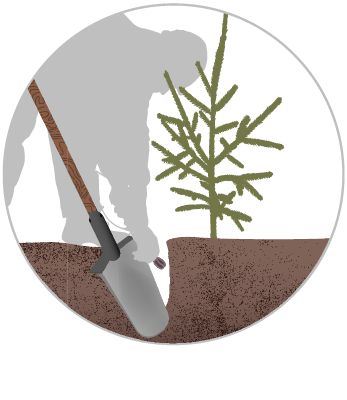
21-5-20
All Purpose Fertilizer
Guaranteed Minimum Fertilizer
Total nitrogen (N)........................... 21.00%
Ammonium nitrogen.......................... 6.50%
Nitrate nitrogen.................................. 12.40%
Urea nitrogen........................................ 2.10%
Available phosphate (P205)............ 5.00%
Soluble potash (K2O).................... 20.00%
Boron (B)........................................... 0.02%
Copper (Cu)...................................... 0.01%
Iron (Fe)............................................. 0.10%
Water soluble manganese (Mn)....... 0.05%
Molybdenum (Mo)............................ 0.01%
Water soluble zinc (Zn).................... 0.07%
Figure 5-4 | Example of a fertilizer label for an "all purpose" fertilizer
The three numbers (21-5-20) represent the percentage of nitrogen, phosphorus, and potassium respectively (21%N, 5% P2O5, and 20% K2O). The label may also contain percentages of other nutrients in the fertilizer. Multiplying these percentages (divided by 100) by the pounds of bulk fertilizer applied per acre will give the quantity of each nutrient applied per acre. In this analysis, applying 500 pounds of fertilizer to an acre would deliver 105 lbs N, 25 lbs P2O5, 100 lb K2O, 0.01 lbs B, 0.005 lbs Cu, etc.
Fertilizer labels report nutrients as a percentage. The example label for a 50 pound bag of fertilizer in Figure 5-4 shows 21 percent nitrogen (N), which indicates that 10.5 pounds of material in the bag is made up of nitrogen ( 50 * 21 / 100 = 10.5 ). The bag also contains 0.02 percent boron (B), which indicates that there is 0.01 pounds of boron in the bag. Calculating the amount of phosphorous and potassium is different because the convention for reporting these nutrients is P2O5 and K2O instead of elemental P and K. To convert P2O5 to P, the analysis for P is divided by 2.29. The percentage of P in the bag in Figure 5-4 is actually 2.2 percent, not 5 percent ( 5.0% / 2.29 = 2.2 ). K2O is divided by 1.21 to obtain 1.6 percent K.
Table 5-3 | Analysis of Common Fertilizers
Available nutrients (typical percentages) |
|||||||||||||||
N |
P2O5 |
P |
K2O |
K |
S |
Ca |
Cu |
Fe |
Mn |
Zn |
B |
Mo |
Mg |
||
Phosphorus |
Mono-ammonium phosphate |
11 |
48 |
21 |
24 |
||||||||||
Ammonium phosphate |
82 |
||||||||||||||
Diammonium phosphate |
17 |
47 |
21 |
21 |
|||||||||||
Single superphosphate |
19 |
12 |
20 |
||||||||||||
Triple superphosphate |
45 |
20 |
1 |
13 |
|||||||||||
Phosphoric acid |
53 |
23 |
|||||||||||||
Dicalcium phosphate |
|||||||||||||||
Soluble potassium |
|||||||||||||||
Superphosphoric acid |
80 |
35 |
|||||||||||||
Potassium |
Potassium chloride |
61 |
50 |
||||||||||||
Potassium nitrate |
13 |
45 |
37 |
||||||||||||
Potassium sulphate |
51 |
42 |
18 |
||||||||||||
Micro- |
EDTA |
10 |
10 |
10 |
10 |
||||||||||
HEEDTA |
6 |
7 |
7 |
9 |
|||||||||||
NTA |
8 |
||||||||||||||
DTPA |
10 |
||||||||||||||
EDDHA |
6 |
||||||||||||||
Granular borax |
11.3 |
||||||||||||||
Copper sulfate |
25 |
||||||||||||||
Ferrous sulfate |
20 |
||||||||||||||
Sodium molybdate |
40 |
||||||||||||||
Zinc sulfate |
36 |
||||||||||||||
Zinc chelate |
4 |
||||||||||||||
Ca & Mg |
Dolomitic limestone |
21 |
11 |
||||||||||||
Magnesium sulfate |
43 |
||||||||||||||
Gypsum |
23 |
||||||||||||||
Epsom salt |
13 |
10 |
|||||||||||||
Fertilizers are selected based on whether they contain the nutrients that are deficient on the project site (Section 5.2.1, see Develop Nutrient Thresholds and Determine Deficits). For example, if nitrogen, phosphorus, and boron are deficient, only fertilizers that contain these nutrients are considered. Most fertilizers contain more than one nutrient. For example, ammonium sulfate contains nitrogen and sulfur; and triple superphosphate contains phosphorus, sulfur, and calcium. Organic fertilizers contain a range of macro and micronutrients. Fertilizers containing more than one nutrient are used if the nutrients contained in these fertilizers are deficient in post-construction soils. Table 5-2 and Table 5-3 show the combination of nutrients that are available in some commercially available fertilizers.
Table 5-4 | Estimated nitrogen release rates for commercially available fertilizers
Nutrient release rates are obtained from lab testing but how they release on-site will vary from site to site, depending on temperature, moisture, and whether the fertilizer was placed on the surface or incorporated into the soil. If slow-release fertilizers are broadcast on the soil surface, release rates are slower than if incorporated into the soil where the conditions are better for break down. Arid sites have slower rates of release than sites with high moisture; cold sites take longer to release nutrients than warm sites. First-year nitrogen release rates for fertilizers are identified with an asterisk were adapted from Claassen and Hogan (1998).
Note: Non-asterisk fertilizers were based on best guess estimates.
Source |
Available Nutrients |
|||
N % |
1st year N release (%) |
% P2O5 |
% K2O |
|
Ammonium nitrate |
34 |
99 to 100 |
0 |
0 |
Ammonium phosphate* |
10 |
99 to 100 |
34 |
0 |
Ammonium sulfate |
21 |
99 to 100 |
0 |
0 |
Anhydrous ammonia |
82 |
99 to 100 |
0 |
0 |
Biosol® * |
7 |
50 to 70 |
2 |
3 |
Calcium nitrate |
15.5 |
99 to 100 |
0 |
0 |
Diammonium phosphate |
18 |
99 to 100 |
46 |
0 |
Fertil-Fibers® * |
6 |
50 to 70 |
4 |
1 |
Gro-Power® * |
5 |
95 to 99 |
3 |
1 |
IBDU |
29 |
95 to 99 |
3 |
10 |
Osmocote 18-6-12® * |
18 |
95 to 99 |
16 |
12 |
Polyon PCU 40® * |
30 |
99 to 100 |
0 |
0 |
Potassium nitrate |
13 |
99 to 100 |
0 |
45 |
Ringer® * |
5 |
50 to 70 |
10 |
5 |
Sustane® * |
5 |
50 to 70 |
2 |
4 |
Urea |
46 |
99 to 100 |
0 |
0 |
In selecting a fertilizer, the macronutrients (nitrogen, potassium, and phosphorus) that are deficient on a site are considered first because they are the most important for long-term site recovery. If these nutrients are not deficient, chances are that the remaining nutrients are not deficient either. On most highly disturbed sites, nitrogen is most likely to be deficient. This nutrient should be considered first when approaching fertilizer selection. Table 5-3 lists common nitrogen fertilizers with typical label analysis. It is common to apply more than one fertilizer to meet the various nutrient requirements of the soil. Nutrients other than nitrogen can be supplied by fertilizers shown in Table 5-3.
Biosolids—Biosolids are a nutrient-rich organic material produced from wastewater treatment sewage sludge that are high enough in macronutrients to be considered a fertilizer (Figure 5-5). When applied to agricultural, forestry, reclamation, and landscaping sites it is a source of nutrients and organic matter. Biosolids improve roadside soils by increasing water-holding capacity, improving soil structure and infiltration, providing slow-release nutrients, and increasing soil biological activity (Sullivan and others 2007). Biosolids are sold as packaged fertilizers from commercial sources or directly in bulk from wastewater treatment centers.
Organic matter |
45-70% |
Nitrogen |
3-8% |
Phosphorous (P2O5) |
3-8% |
Potassium (K2O) |
<1% |
Sulfur (S) |
0.6-1.3% |
Calcium (Ca) |
1-4% |
Magnesium |
<1% |
Figure 5-5 | Range of organic matter and nutrients in biosolids
Biosolids are rich in nutrients and organic matter, often meeting the requirements to be classified as a fertilizer. This table shows the usual range of organic matter and nutrients by dry weight of material (from Sullivan and others 2007). Biosolids also provide micronutrients, including copper, boron, molybdenum, zinc, and iron.
The U.S. Environmental Protection Agency's Part 503 rule, along with State and possibly local regulations, provides comprehensive requirements for the application of biosolids (EPA 1994). Biosolids fall into two classes:
- Class A Biosolids—These are materials that meet rigid requirements which include no detectible levels of pathogens, strict vector requirements, and low metals contents. The applicator has only to apply for permits, though in some cases, site approval may be required if trace elements exceed Exceptional Quality (EQ) limits or if they are not sufficiently stabilized (Sullivan and others 2007).
- Class B Biosolids—These are materials that have been treated but still contain detectible levels of pathogens. Setbacks and public access restrictions are required to protect public health. Site approvals and permits are required for Class B Biosolids application.
Nitrogen is an important component of biosolids because this nutrient is limiting on most roadsides. Biosolids are basically composed of two forms of nitrogen:
- Ammonium-nitrogen—This form of nitrogen is readily available for plant uptake. If biosolids are surface applied, a portion of ammonium-N is lost as gas. Sprinkler irrigating or tilling biosolids into the soil immediately after application can reduce the amount of nitrogen that is lost (Sullivan and others 2007).
- Organic-nitrogen—Nitrogen in this form is bound to organic matter which must be digested by soil microorganisms to be released. This process, called N mineralization, takes time. When first applied however, nitrogen release rates are rapid, but level off over the years, to supply a relatively consistent annual supply of nitrogen.
Biosolids are high in other macro nutrients including phosphorus, calcium, magnesium, and sulfur (Figure 5-5). Phosphorus however, is very low and may need to be added depending on the nutrient status of the roadside soils and the biosolids being applied. Phosphorus is present in biosolids at significant quantities yet the availability is around half of a commercial fertilizer because of the predominance of inorganic phosphorus (EPA 1995). Micronutrients, such as boron (B), copper (Cu), iron (Fe), manganese (Mn), molybdenum (Mo), and zinc (Zn) are present in varying amounts but may not be at the ratios found in a well-balanced commercial fertilizer and micronutrient fertilizers may need to be supplemented (EPA 1995).
Some biosolids are stabilized with alkaline materials which can raise the pH of roadside soils. Where soil pH is low, this can be an advantage, and biosolids can be used as a replacement for agricultural limestone (Sullivan and others 2007). However, on high pH soils, the addition of alkaline-stabilized biosolids can be detrimental to plant establishment and plant growth. For these reason, the pH of the roadside soils is important when considering applying an alkaline-stabilized biosolids.
Biosolids are typically applied on roadsides at higher rates than agricultural lands to improve soils and provide nutrients and organic matter capable of supporting native vegetation (EPA 1994). Rates range from 3 to 200 tons/acre but average around 50 tons (EPA 1995). biosolids are relatively light weight and can be half the weight by volume of soil. A 50 tons/acre application rate of biosolids is approximately 0.5-inch thick layer biosolids applied to the surface of a soil. Baxter and Stephan (2011) found that biosolids placed one inch deep on an abandoned timber haul road in Oregon and disked into the soil, was successful in obtaining a high cover of native grass species. On highway right-of-way plots in Rhode Island, Brown and Gorres (2011) found significant improvement of vegetative cover with a 2.0-inch application rate of biosolids compared to a 2.0-inch application of compost. The differences in plant response to compost and biosolids was due to the C:N ratios (biosolids - 7, compost - 64). In this study, biosolids had four times as much total N as the compost. Fava (2015) however, found that at a 1.0 inch application rate, vegetative cover did not differ from the control plots. The differences in findings of these studies point out the importance of knowing the composition of the biosolids and how they respond to the site they are being applied to. Administrative trials, where different rates of biosolids are applied in combination with compost or shredded wood, can will help develop appropriate rates and soil amendments to use to improve the roadside soils.
Select Fertilizer Release Rates
Fertilizers are grouped by how quickly they break down and release nutrients to the soil. They are either fast-release or slow-release. Release rates are important because they determine the rates at which nutrients become available to plants during the year. If nutrients are released during periods when vegetation cannot use them, some will be lost from the site through soil leaching. This is not only a waste of fertilizer but can be source of ground-water pollution.
Fast-Release Fertilizers—Fast-release fertilizers are highly soluble fertilizer salts that dissolve rapidly and move quickly into the soil during rainstorms or snowmelt. The fertilizer label gives an indication of how quickly nutrients are released. Terms such as "soluble," "available," or "water soluble" indicate that these nutrients are released relatively quickly. "Ammonium" and "nitrate" forms of nitrogen are also indications of fast-release fertilizers. The fertilizer label shown in Figure 5-4 indicates that the fertilizer contains a fast-release fertilizer and most of the nitrogen would be relatively mobile and available to plant growth within the first growing season. Ammonium nitrate, ammonium sulfate, potassium nitrate, and urea are several examples of fast-release fertilizers.
"Water soluble" or "available" nutrients do not always remain available or soluble after they are applied to the soil. Available forms of phosphorus, for example, react in the soil to form less soluble compounds; potassium gets bound up in soils with moderate to high proportions of clay; and many of the micronutrients (e.g., zinc, copper, and manganese) become unavailable when applied to soils with low pH (Section 3.8.4, see pH). Unless soils are sandy or rocky, it can be assumed that many of the nutrients stated as "available," except for nitrogen and sulfur, will become somewhat immobile once they are applied. Over time, however, these nutrients will become available for plant uptake.
The advantages of fast-release fertilizers are they are relatively inexpensive, easy to handle, immediately available to the plant (especially nitrogen), and can be applied through a range of fertilizer-spreading equipment. Disadvantages are that some nutrients, such as nitrogen, will leach through the soil profile if they are not first taken up by plants or captured by soil microorganisms in the breakdown of carbon. Nitrates from fast-release fertilizers have been found to leach through sandy soils to depths that are four times the rate of rainfall (Dancer 1975). For example, for sites with annual rainfall of 12 inches, nitrate could move to a depth of 4 feet if it is not taken up by plants or soil organisms. At this depth, nitrogen would be out of range of most establishing root systems.
Because fast-release fertilizers are salts, they have a potential to burn foliage and roots, especially when fertilizers are applied at high concentrations or when applied during dry weather. High concentrations of fast-release fertilizers can also affect germination rates (Figure 5-6) because of the high soluble salt levels (Brooks and Blaser 1964; Carr and Ballard 1979). Salt damage can be reduced by mixing fast-release fertilizers at lower concentrations or by applying them during rainy weather.
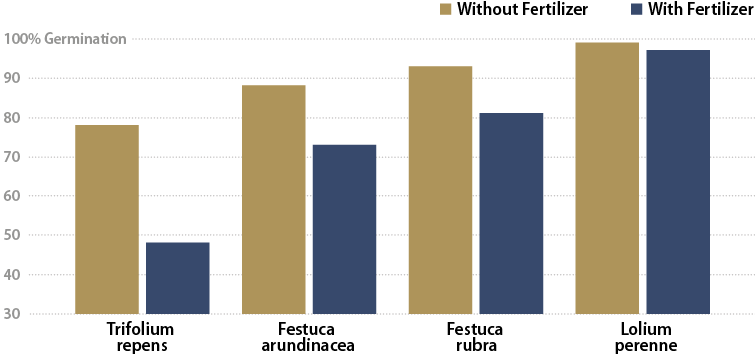
Figure 5-6 | Reduced seed germination after exposure to fertilizer
Germination for some species can be reduced following exposure to a 10-30-10 fertilizer solution at a rate of 750 pounds of fertilizer per 1,000 gallon hydroseeder (after Carr and Ballard 1979).
Slow-Release Fertilizers—These fertilizers are designed to release nutrients at a much slower rate. To be labeled slow-release fertilizer, some states require a specific amount of nitrogen to be in a slow-release form. Forms of nitrogen shown on the label as "slowly available" or "water-insoluble" are good indicators that a fertilizer is in a slow-release form. The advantages of using slow-release fertilizers are as follows:
- Nutrients are supplied at a time when plants are potentially growing
- Less frequent applications
- Less potential for leaching into ground water
- Less potential to cause salt injury
The disadvantages are that many slow-release fertilizers are bulky, cost more to purchase and apply, and are limited by the type of fertilizer application equipment that can be used. Nevertheless, slow-release fertilizers have greater applicability for revegetating disturbed sites than fast-release fertilizers.
Organic slow-release fertilizers—These fertilizers come in either organic or inorganic forms. Organic fertilizers include animal manures (e.g. chicken, steer, and cow), bone meal, fish emulsion, composted sewage sludge (biosolids), and yard waste. Unprocessed organic fertilizers are hard to apply to roadside projects because they are bulky and high in moisture content. Commercially available organic fertilizers, such as Fertil-Fiber™ and Biosol®, have been processed to remove most of the water, which makes them easier to apply with most fertilizer-spreading equipment. For a good discussion on organic fertilizers, see Landis (2011).
The agents responsible for release of nutrients from organic fertilizers are decomposing soil bacteria. When soil bacteria are active, the release of nutrients is high; when dormant, the rate is low. The release of nutrients is therefore a function of moisture and temperature, which governs the rate of bacterial growth. Warm temperatures and high moisture, conditions conducive to plant growth, are also favorable for the breakdown of organic fertilizers. Because of this, the release of nutrients from the decomposition of organic fertilizers often coincides with the period when plants are growing (spring and fall) and the need for nutrients is greatest. The nutrient-release mechanism of slow-release organic fertilizers reduces the risk that highly mobile nutrients, such as nitrogen, will be released in the winter when plants are incapable of absorbing them and the potential for leaching is greatest.
Inorganic forms of slow-release fertilizers were developed for the horticulture and landscape industries where they have become an effective method of fertilizing nursery plants. These are expensive forms of fertilizer and have not been tested on roadside revegetation conditions. Nevertheless, they should not be overlooked in their potential applicability for some native revegetation projects.
Inorganic slow-release fertilizers—These fertilizers include ureaform, nitroform, isobutylidene diurea (IBDU), sulfur-coated urea, and polymer-coated nitrogen, phosphorus, and potassium. These fertilizers have varying mechanisms for nutrient release. Fertilizer granules coated with materials that release nutrients only during warm, moist conditions ensure that nutrients are available during the period when plants are most likely to be growing. These coatings include sulfur (e.g., sulfur-coated urea) and polymers. Each fertilizer has its own formulated nutrient release rate, which varies from 3 months to 18 months. Release rates are available from the manufacturers for most inorganic, slow-release fertilizers. However, it should be noted that these rates were developed for 70° F soil temperatures (Rose 2002), which are higher than soil temperatures in the western United States during the spring and fall when roots and foliage are growing. If roadside soils are colder than 70° F, nutrient release will take longer than what the manufacturer states.
Determine Fertilizer Application Rates
Fertilizer rates are determined for each deficient nutrient, as shown in Figure 5-7. The calculation in this example was done to eliminate a nitrogen deficit of 769 lb/ac. Using a slow-release fertilizer with 8 percent nitrogen, the amount of bulk fertilizer necessary to bring nitrogen levels to minimum targets is 9,613 lb/ac ( 769 * 100 / 8 = 9,613 ), which is a high rate of fertilizer to apply. With a release rate of approximately 40 percent the first year, 308 lbs N/ac would be available, far more than the establishing plant community could absorb. Alternatively, using a fast-release fertilizer with higher nitrogen analysis, such as ammonium nitrate (33 percent N), would reduce the amount of bulk fertilizer to 2,330 lbs/ac ( 769 * 100 / 33 = 2,330 ). While there would be less weight with this more concentrated fertilizer, this is considered a dangerously high application rate because all of the nitrogen would be released in the first year resulting in a much greater potential that high amounts of nitrates are leached through the soil into the ground water and a higher risk that elevated salt levels would be toxic to plant growth. This example illustrates the difficulty in developing fertilizer prescriptions to meet long-term nutrient targets. How does the designer develop a fertilizer strategy to meet short-term and long-term plant needs without over- or under-fertilizing?
A |
Nitrogen (N) deficit |
769 lbs/ac |
Calculated from example in Figure 5-3 |
B |
N in fertilizer |
8% |
From fertilizer label |
C |
Total bulk fertilizer needed |
9,613 lbs/ac |
To eliminate deficit |
D |
Estimated first year N release rate of fertilizer |
40% |
From Table 5-4 or obtain from manufacturers |
E |
Available N first year in fertilizer from first year application |
308 lbs/ac |
N available to plants and soil |
F |
Short-term N target (first year) |
50 lbs/ac |
Depends on C:N ratio, plant cover, and age |
G |
Excess nitrogen |
258 lbs/ac |
Wasted N could leach from soils into water |
H |
Adjusted rates of fertilizer |
1,563 lbs/ac |
To assure that N released first year is not wasted |
I |
Remaining N deficit A - ( H * B / 100 ) = |
644 lbs/ac |
Additional N needed as later applications of fertilizer |
Figure 5-7 | Example of calculating fertilizer application rates to reduce nitrogen
This spreadsheet shows how a slow-release fertilizer would have to be applied at high quantities to reduce the nitrogen deficit. The problem with these high rates is that approximately 40 percent of the nitrogen (Line D) would be released the first year which is more than an establishing plant community could use, resulting in nitrogen leaching (Line G). Fertilizer rates can be lowered to meet just the first-year nitrogen needs (Line F) but not the long-term nitrogen needs of the site (Line I).
The approach presented in this section is based on meeting short-term nutrient needs of the establishing plant community while building a long-term nutrient capital. For example, applying fertilizer at the time of seeding requires very low rates of available nitrogen to meet the first-year needs of the establishing vegetation. Any extra fertilizer has the potential of being wasted. As the vegetation develops over the next few years, the ability of the plant community to take up more available nutrients increases. A strategy of applying low amounts of fertilizer the first year, followed up with higher rates in later years would supply the levels of nutrients needed for a developing plant communities without wasting fertilizers. This practice, however, is seldom employed in roadside revegetation projects. In fact, the typical fertilizer practice does just the opposite—high rates of fertilizers are applied with the seeds to a site that has no vegetation that could utilize the available nutrients. There is no return to the site in later years to assess whether additional applications of fertilizers might be essential for vegetation maintenance or growth. The approach advocated in this section is applying the appropriate mix of fertilizers to meet the annual needs of the vegetation while building long-term nutrient capital until the plant community is self-sustaining. This approach may require fertilizer application over a period of several years.
Because nitrogen is the key nutrient in establishing plant communities, this approach requires setting short-term and long-term nitrogen requirements of the plant community being established. Calculating long-term nitrogen target is addressed in Section 5.2.1, see Develop Nutrient Thresholds and Determine Deficits. Short-term targets are more difficult to set because they change over time. They are governed by the following:
- Soil type
- Carbon-to-Nitrogen ratio (C:N ratio)
- Climate
- Amount of vegetative cover
- Type of vegetation
- Age of vegetation
Some general guides can be helpful in setting short-term nutrient targets for available nitrogen. Applying fertilizer at the time of sowing, for example, requires very low rates of available nitrogen because vegetation is not there to utilize it. Rates range from no fertilizer to up to 25 lb/ac of N when applying fertilizer with seeds. During plant establishment, available N can range from 25 to 50 lb/ac (Munshower 1994: Claassen and Hogan 1998). After plant establishment, rates can be increased to account for increased plant utilization above this amount. These suggested rates are adjusted upward on sites where high C:N soil amendments, such as shredded wood or straw, have been incorporated into the soil to compensate for nitrogen tie-up. Calculating precise rates of supplemental nitrogen for incorporated organic amendments is very difficult. In nursery settings, rates of over 100 pounds of supplemental nitrogen have been recommended for incorporated straw, sawdust, and other high C:N materials (Rose and others 1995). However, applying supplemental rates on highly disturbed sites should be done with caution, utilizing trials where possible to determine more precise fertilizer rates. Periodic soil analysis can provide the designer with a better understanding of the soil nitrogen status. To keep testing costs low, only available nitrogen and total nitrogen need to be tested (Section 3.8.4, see How to Assess Soil Nitrogen and Carbon).
In determining how much fertilizer to apply, it is important to estimate how much nitrogen will be available the first and second years. Manufacturers have this information for most inorganic slow-release fertilizers. Claassen and Hogan (1998) have also performed tests on some slow-release organic fertilizers (Table 5-4). Release rate determinations are performed in the laboratory but the actual release rates will vary in the field by soil type and climate. In the example described in Figure 5-7, the first-year release rate of nitrogen from the slow-release organic fertilizer was estimated at 40 percent. This was a guess based on the manufacturer's estimates of 55 percent release, but because it was being applied to a semi-arid site where decomposition of the fertilizer would be slow, the rate was dropped to 40 percent (Line D). If 40 percent of the nitrogen became available the first year, 60 percent would remain for the following years (Line E). At this release rate, 308 lb/ac of nitrogen would become available the first year after application (Line F). While this is an extremely high rate, consider the application of ammonium nitrate at 100 percent first year release, which would supply 769 lb/ac (Line A) of immediately available nitrogen. Recalculating fertilizer rates using a more realistic rate of 50 lb/ac available nitrogen needed the first year after application (Line F), bulk fertilizer application rates would be 1,563 lb/ac (Line H). At this new rate, the site would have sufficient first- and second-year supplies of nitrogen but lack adequate nitrogen the following years. The remaining deficit to meet long-term nitrogen targets would be approximately 644 lb/ac, which should be supplied through later applications of fertilizer or other carriers of nitrogen (topsoil, compost, biosolids, wood waste, mulch, and nitrogen-fixing plants). In this example, nutrient strategy would be built upon treatments that would increase long-term nitrogen capital.
The process of calculating fertilizer application rates in Figure 5-7 can be used for other deficient nutrients, however, understanding the availability of these nutrients is problematic. Many nutrients become fixed in the soils and their availability is dependent on highly variable factors such as soil texture, pH, and placement in the soil. It is a reasonable assumption that unless the soils are sandy or very rocky, that all nutrients, aside from nitrate or ammonium forms of nitrogen, are relatively unavailable the first year after application. With time, however, they will slowly become available.
Determine Timing and Frequency
The primary reason to fertilize is to supply nutrients during periods when plants can take them up for growth. The demand for nutrients changes throughout the year depending on the physiological state of each plant. In nursery settings, fertilizers are adjusted throughout the year at rates and formulations that correspond to the requirements of the plant. While that capability is not possible in roadside environments, fertilizers can be used more wisely by applying an understanding of how the assortment of fertilizers function in meeting the nutrient requirements of plant communities. At least two plant growth phases are important in the timing of fertilizer application: (1) seed germination and plant establishment and (2) post-plant establishment.
Seed Germination and Plant Establishment Phase—Traditionally, fast-release fertilizers have often been applied at high rates in the fall in the northern United States during the seed-sowing operation. This practice is a quick and easy way to apply fertilizers. However, the timing can result in ineffective and wasteful use of fertilizers )Figure 5-8B) (Dancer 1975). In addition, application of fast-release fertilizers at this time can potentially pollute water sources. Slow-release fertilizers are more appropriate for seed sowing in the fall because much of the fertilizer, but not all, is expected to release nutrients the spring, not in the fall or winter (Figure 5-8D).
Perennial grasses and forbs do not require high levels of nitrogen for germination and early establishment (Reeder and Sabey 1987). In fact, an elevated level of available nitrogen can be a problem because it encourages the rapid establishment and growth of annual weed species over slower-growing perennial grass and forbs (McLendon and Redente 1992; Claassen and Marler 1998). It is important to calculate fertilizer quantities based on the plant requirements over time (Section 5.2.1, see Determine Fertilizer Application Rates).
One strategy is to apply little or no fertilizer during sowing and wait until seeds have germinated and grown into small seedlings before fertilizers are applied (Figure 5-8C). This strategy ensures that nutrients are available when the seedlings actually need them, not before. Fertilizers applied as slow-release form are preferred because they have less potential for causing salt damage when applied over emerging seedlings. Another strategy is to wait until the following fall (Figure 5-8E) or spring (Figure 5-8F) of the second year to fertilize.
Post-Establishment—Once vegetation is established (one or two years after sowing), fertilizers may be applied at higher rates with the assurance that nutrients will be taken up by the plants. It is important that the application rates are based on nutrient levels of the soil and the needs of the native plant species. On fertile soils, there may be no need to fertilize, whereas on soils without topsoil or low in organic matter, a post-establishment fertilizer application may be needed.
Slow- and fast-release fertilizers can be combined to provide short- and long-term nutrient requirements (Figure 5-8E and F). Spring applications of fast-release fertilizers are more effective than fall application because of the higher nutrient requirements of growing plants during that period (Figure 5-8F). In addition, spring applications may pose less risk of damaging vegetation through fertilizer salts on sites where precipitation in the spring is frequent enough to wash fertilizers from the foliage. The conductivity of a fertilizer solution being applied over existing vegetation can be measured with a conductivity meter to avoid salt damage (refer to Section 3.8.4, see Salts). If rates exceed 3,500 mS/cm, then diluting the solution or applying the fertilizer during rainy weather is advised. Fertilizer rates can also be adjusted based on the salt tolerance of a plant species (see ERA).
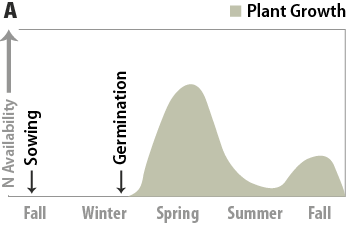
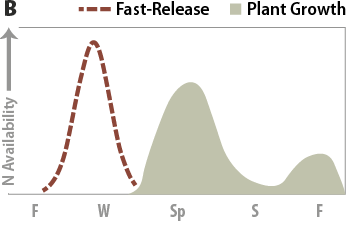
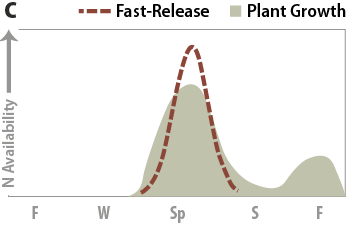

Figure 5-8 | Strategies for applying slow and fast release fertilizers
Fertilizers should be applied during seasons and at rates and formulations that release nutrients when native plants can efficiently draw them from the soil. The following are strategies for applying slow and fast release fertilizers.
A) When seeding occurs in the fall, seeds typically do not germinate until the following spring, at which time there is rapid growth. During the summer, growth rates slow. Growth rates accelerate again in the fall.
(B) When fast-release fertilizers (dashed line) are applied in the fall during seeding, fertilizers move into the soil with fall rains. However, there is no vegetation to take up the nutrients. Mobile nutrients, such as nitrogen, are leached and unavailable in the spring when the establishing plants require them.
(C) Fast-release fertilizer applied in the spring after plants are established is more effective because plants are rapidly growing and can take up nutrients. There are fewer storms in the spring to leach nutrients from the soil.
(D) Slow-release fertilizers (dotted line) release nutrients at a much slower rate. When they are applied in the fall, most of the nutrients should still be available in the following spring.
(E) Once vegetation has become established, plant growth will take place in the fall. Fertilizers applied at this time will be taken up by growing vegetation. Since slow-release fertilizers might not be immediately available, small amounts of fast-release fertilizers can be added to give immediate release nutrients.
(F) Slow- and fast-release fertilizers can be applied in the early spring before rapid root and vegetative growth. Fast-release fertilizers can supplement slow-release fertilizers by supplying immediately available nutrients.
Note: These examples are based on a Mediterranean climate and assumes that seeds germinate in the spring, not in the fall or winter.
Select Fertilizer Application Method
Because nutrients have varying degrees of mobility (nitrogen is highly mobile; phosphorus and many micronutrients are relatively immobile), how fertilizers are applied will determine how accessible nutrients are to the root systems of establishing vegetation. If nutrients are highly mobile, the easiest and least expensive method is broadcasting fertilizer to the soil surface to allow rainfall or snowmelt to release and move nutrients into the soil. A more difficult, yet more effective application method for immobile nutrients is to incorporate, or mix, fertilizers into the soil so fertilizer granules are uniformly distributed and accessible by root systems.
Broadcast Fertilizer Application—For fertilizers with highly mobile nutrients, such as nitrogen and sulfur, broadcast application on the soil surface is an appropriate practice. Broadcast fertilizer application is less effective, however, for immobile nutrients. These nutrients often become immobilized at the soil surface and are very slow to move into the rooting zone where they can be accessed. Depending on soil characteristics, such as pH and clay content, some immobile nutrients will take years to move only a few inches from the point of fertilizer placement.
A variety of dry fertilizer spreaders are available, from hand-operated to tractor-mounted. Most equipment is limited to moderate slope gradients (less than 1V:2H). With all forms of spreaders, they should be calibrated before they are used to ensure that the correct rates are being applied.
Hydroseeding equipment can be used to apply fertilizer in the same operation with seeds, tackifiers, and hydromulch (Section 5.4.2). This equipment can also be used solely to apply fertilizers, especially after vegetation has become established. A great advantage to using hydroseeding equipment is that it can uniformly spread fertilizers on steep slopes and a variety of topographies. In addition, a combination of fertilizers can be easily mixed in the hydroseeder tank and applied uniformly at relatively even proportions. This is especially useful for applying small quantities of fertilizer, such as micronutrients, which are difficult to spread evenly over large areas.
Fertilizer Incorporation—It is important that nutrients that are deficient and have low mobility be incorporated into the soil prior to sowing or planting. Incorporation is possible on gentle slopes but becomes very difficult with increasing slope gradients because of equipment limitations or slope stability. On sites where fertilizers containing immobile nutrients cannot be incorporated, an alternative is to create roughened soil surfaces (Section 5.2.2) prior to fertilizer application. Broadcast fertilizers will accumulate in the depressions of the surface. As soil gradually moves into the depressions over time through erosion (water, wind, or surface ravel), the broadcast fertilizers will become covered with soil. When this happens, immobile nutrients are accessible by roots and nutrient uptake is possible. Surface roughening also reduces the potential for fertilizers to move off-slope through erosion.
Some agricultural spreaders, called fertilizer banders or injectors, are designed to place fertilizer, or other soil amendments including mycorrhizae, at varying depths in the soil. Usually this equipment has a ripping shank or tine that loosens the soil, followed by a tube that drops the fertilizer, and coulters or rollers that close the furrow. As the bander is pulled through the soil, a line, or band, of fertilizer is created. Sowing and banding are often combined in one piece of equipment and applied at the same time. Fertilizer banders were developed for agricultural use and are limited by rock content and slope gradients, however, there are injectors that have been developed for wildland conditions (St. John 1995).
The most common approach to incorporating fertilizer is accomplished in two operations, broadcasting fertilizer on the soil surface and tilling it into the soil. In this approach, hydroseeders and broadcast fertilizer spreaders are used to apply fertilizers evenly over the soil, then the fertilizer is incorporated using tillage equipment outlined in Section 5.2.2.
5.2.2 Tillage
Introduction
Tillage is defined in this section as any mechanical action applied to the soil for the purposes of long-term control of soil erosion, reestablishment of native plant communities, and improve soil function. Most tillage equipment was developed for agricultural soils and has limited applicability for steep, rocky sites typically encountered in revegetation. This section describes the agricultural equipment that can be used for revegetating roadsides, as well as equipment specifically developed for extreme site conditions.
Among the reasons to use tillage in a revegetation project is to shatter compacted soils, incorporate soil amendments, and roughen soil surfaces. These objectives often overlap. For example, incorporating organic matter also loosens compacted soils and roughens soil surfaces. Identifying the objectives for the project will lead to selecting and effectively using the appropriate equipment to achieve the desired soil conditions (Table 5-5).
Table 5-5 | Types of tillage and equipment
The appropriate tillage equipment for the project depends on project objectives.
Objectives |
Shattering |
Incorporating |
Imprinting |
Rippers and subsoilers |
Disks, plows, |
Dixon imprinter, excavator attachments, trackwalking |
|
Loosen compacted soil |
Good |
Good |
Poor |
Incorporate amendments |
Poor |
Good |
Poor |
Roughen surface |
Good |
Good |
Good |
Shatter Compacted Soils
One of the primary purposes for tilling is to loosen compacted soils. When performed correctly, tillage can increase porosity in the rooting zone, increase infiltration rates, and increase surface roughness. For revegetation work associated with road construction and road obliteration, tillage to break up deep compaction is important for reestablishing plant communities. Shattering compaction at depths of at least 2 feet is essential for the healthy growth of most perennial plant species. Without this measure, it may take decades for deep compaction to recover its original bulk density (Wert and Thomas 1981; Froehlich and others 1983). In a review of tillage projects on rangeland soils, Gifford (1975) found that deep tillage greatly reduced runoff, while shallow tillage had little effect. Still, tillage alone may not return a soil to its original bulk density or hydrologic function, nor will the effects of tillage last indefinitely, especially in non-cohesive soils (Figure 5-9) (Onstad and others 1984). Many factors affect the return to bulk densities and infiltration rates typical of undisturbed reference sites. These include the type of tillage equipment used, tillage depth, soil moisture during tillage, soil texture, presence of topsoil, and organic matter content.
There are two fundamentally different equipment designs for reducing compaction. One design lifts and drops soil in place, shattering compacted soil in the process. This type of equipment includes rock rippers, subsoilers, and "winged" subsoilers. The second design churns and mixes the soil. Equipment that falls into this category includes disk harrows, plows, spaders, and attachments to excavators. This type of equipment can also incorporate soil amendments, such as organic matter or fertilizers, in the same operation, as described in Section 5.2.2, see Incorporate Soil Amendments.

Figure 5-9 | Benefits of ripping and mulching vary by soil type
Short-term benefits of ripping (using a winged subsoiler) and mulching road surfaces vary by soil type, as shown in rainfall simulation tests on sites in northern Idaho. Granitic soils responded to ripping and mulching with increased permeability during the first storm, but permeability rates returned to near pre-treatments rates with successive rainfall events. Metamorphic soils reacted positively to both treatments and maintained high permeability rates after three rainfall events. Mulching improved permeability in both soil types. In fact, for metamorphic soils, the combination of ripping and mulching increased permeability to rates that were typical of lightly disturbed forest soils (adapted from Luce 1997).
The terms "subsoiling" and "ripping" are used interchangeably to describe soil-shattering operations. Soil shattering involves pulling one tooth, or a set of teeth, at various depths through the soil to break up compaction created by equipment traffic. The rock ripper is a common tool found on most construction sites. When used to break up compaction, one or two large ripper tines are typically pulled behind a large bulldozer at 1 to 3-foot soil depths. While this equipment will break up compaction in portions of the soil where the ripper tines have been dragged, it does not effectively fracture the compacted soil between the ripper tine paths (Andrus and Froehlich 1983). The effectiveness of rippers can be increased by multiple passes through the soil or by adding tines to the toolbar. Even on small machines, up to five tines can be added to increase soil shatter.
Rippers have also been adapted to increase soil lift between tine paths by welding wide metal wings to the bottom of each tine. These wings are angled upwards so the soil between the tines has greater lift, and therefore greater shatter when the soil drops behind the wing. When two or more tines are placed together on a toolbar, they work in tandem to more effectively break up compaction. The resulting equipment is called a "winged" subsoiler (Figure 5-10). Andrus and Froehlich (1983) found that the winged subsoiler was a far more effective tool for breaking up compaction. This equipment fractured over 80 percent of the compaction in several operational tests, as compared to 18 to 43 percent for rock rippers and 38 percent for brush rakes. However, winged subsoilers are not practical in all soils, especially those with high rock fragments, buried wood, or slopes greater than 3H:1V gradients.

Figure 5-10 | Winged subsoiler
Soil shattering becomes more effective when wings are mounted on subsoil tines. This equipment is called a winged subsoiler.
Photo credit: Brent Roath
Achieving good shatter at deeper soil depths requires that tillage equipment be adjusted for site-specific soil conditions, especially soil texture, soil moisture, and large rock content. Tines will slice through the soil, causing very little soil shatter, if soils are too moist during ripping. Subsoiling when soils are extremely dry can bring up large blocks of soils, especially when the soils are high in clays (cohesive soils).
It is important the winged subsoiler and rock ripper be adjusted to meet the soil conditions of the site. Making the proper adjustments can lead to greater shatter and more efficient use of tractor equipment. These adjustments include the following:
- Tine depth
- Tine spacing
- Number of tines
- Wing width and angle (for winged subsoiler)
For optimum shatter, the depth of the tines is adjusted based on the soil properties and moisture conditions. The tines are adjusted to be above a "critical depth," the point below which soils will not shatter effectively (Figure 5-11B)). The critical depth changes for soil type and tine configuration. Soils high in clays with high soil moisture have shallower critical depths (Andrus and Froehlich 1983).
The closer the spacing of tines, the greater the shattering. The more tines that are placed on a toolbar, the more area of soil that can be shattered. However, where large rocks, slash, and roots are present, closely spaced tines will drag these materials out of the ground. Three to five tines are typically used for most soil types. Wing size, angle, and shape of the tines all play a role in breaking up compaction (refer to Inset 5-2 for specifications for winged subsoiler).
Inset 5-2 | Contract specifications for a winged subsoiler
A winged subsoiler consists of a self-drafting, winged subsoiler on a dolly mount, sized for use with a D-7 tractor. The unit consists of three-winged ripper tines capable of extending 12 to 34 inches below the draw bar. Wings shall be at least 20 inches wide with a 2-inch lift of the wings from horizontal. Tines shall have an individual tripping mechanism that automatically resets; tine spacing must be adjustable, and individual tines must be removable. Various wing patterns must be available and easily interchangeable. Implement must be capable of achieving maximum fracture of compacted soils (minimum 24 inches) in one pass (adapted from Wenatchee National Forest contract specifications).
Typical settings for rock ripper and winged subsoiler equipment configurations are shown in Table 5-6. These are suggested settings and should not be applied without first monitoring the results of the equipment on the project soils. The most direct method for monitoring soil shatter is to measure the depth to the compacted soil with a soil penetrometer or shovel (Section 3.8.2, see Soil Structure). Immediately after a pass is made with the tillage equipment, the shovel or penetrometer is pushed into the soil and the depth to resistance (the compacted layer) is recorded. Measurements are taken every 6 inches across a small transect perpendicular to the direction of the tractor and spanning the width of the tillage disturbance. Plotting the depths to compaction on graph paper provides a cross-section of the shattering pattern (Figure 5-11 is an example of plotting soil shatter). If the shattering pattern is inadequate, adjustments can be made to the tine depth, tine spacing, and angle of the wing. If these adjustments fail to increase soil shatter, a second and perhaps third pass by the ripper or winged subsoiler can be considered. Successive passes made at 45 to 90 degrees angles from the first pass achieves the greatest benefit. Most soil-shattering equipment is attached to the tractor toolbar and is limited to slope gradients of 3H:1V or less. Subsoilers and rippers are best used for projects that consist of gentle terrain or obliterated road sections.
The excavator is good piece of equipment on steeper slopes where its arm can reach 35 feet up and down slope and decompact targeted areas of compacted soil. In this operation, the bucket of the excavator is placed several feet into the soil, lifted and dropped in place (Figure 5-12). Special attachments, such as the "subsoiling grapple rake" have been developed for the excavator that can decompact, incorporate, and remove rock and slash in the same operation (Archuleta and Baxter 2008).
A general rule for tillage is to operate equipment on the contour to reduce the potential of water concentrating in the paths of the furrows and creating soil erosion and slope stability problems. This is especially important on steeper slopes where the potential for soil erosion and slope instability are greater. If several passes are made, it is important to make the last pass on the contour.
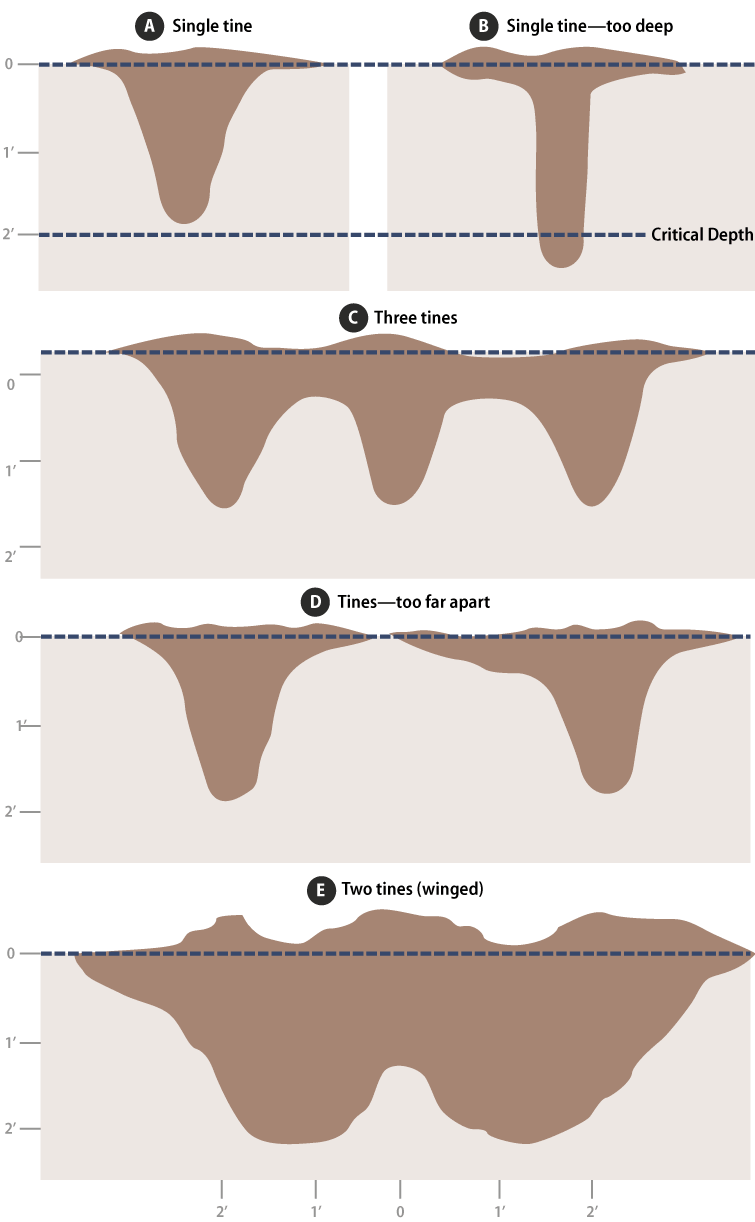
Figure 5-11 | Subsoiler tine and wing configurations determine effectiveness
The effectiveness of subsoiling or ripping equipment to shatter compacted soil is a function of tine depth, number of tines, distance between tines, and wing configuration. Pulling a single tine (A) above a critical depth does some soil shattering as compared to a single tine ripping deeper than a critical depth (B). Placing three or more tines together (C) can be more effective than one tine, but tines spaced too far apart will not effectively shatter the soil (D). Attaching wings to the tines is very effective in shattering compaction between the tines (E) (modified after Andrus and Froehlich 1983).
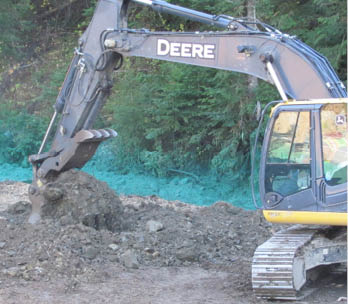
Figure 5-12 | Excavators decompact and incorporate soil amendments
The excavator incorporates and decompacts soils by lifting the soil and dropping in place.
Photo credit: David Steinfeld
Table 5-6 | Recommended design features for some tillage equipment
Modified after Andrus and Froehlich 1983; Froehlich and Miles 1984
Item |
Implement feature |
Recommended design |
Disk harrow |
Disk diameter |
40-50 in. |
Number of disks |
6-12 |
|
Average disk weight |
>1,800 lbs |
|
Disk arrangement |
Offset gangs, independent disks |
|
Max slope (cross slope travel) |
<5:1 H:V |
|
Max slope (down slope travel) |
5:1 H:V |
|
Brush blade |
Tine spacing |
22-26 in. |
Tine depth |
<20 in. |
|
Max slope (cross slope travel) |
<5:1 H:V |
|
Max slope (down slope travel) |
3:1 H:V |
|
Rock rippers |
Tine spacing |
24-30 in. (one pass) |
Ripping depth |
20-24 in. |
|
Number of tines |
5 (one pass) |
|
Max slope (cross slope travel) |
<5:1 H:V |
|
Max slope (down slope travel) |
2.5:1 H:V |
|
Wings of subsoilers |
Ripping depth |
18-22 in. |
Number of tines |
3-4 |
|
Tine spacing |
30-40 in. |
|
Wing width |
12-24 in. |
|
Wing angle |
10-60° |
|
Max slope (cross slope travel) |
<5:1 H:V |
|
Max slope (down slope travel) |
2.5:1 H:V |
It is also important to consider that when cuts and fills are tilled, soil strength is reduced and the soils are less resistant to concentrated water. Improper road or slope drainage may result in rills and gullies on tilled soils, a situation that is less likely to occur when soils are compact. Therefore, on slopes that have been tilled, it is important that road water is directed away from fill slopes at least until vegetation has stabilized the slopes. It is important to discuss any tillage operation on slopes adjacent to roadways with the design engineer to ensure that slope stability and road objectives are not compromised.
Incorporate Soil Amendments
Tilling is used to incorporate fertilizers, organic matter, lime, and other amendments that are placed on the soil surface and evenly distributed in the soil. Tilling with these objectives requires equipment that mixes soil, such as plows, tillers, disks, chisels, and soil spaders. These types of equipment are tractor-drawn and limited to gentle slope gradients (5H:1V or greater) and soils low in rock fragments. They are not designed to break up deep compaction. Under most disturbed soil conditions, the best that can be expected from this equipment is tillage to a depth of 8 inches.
The excavator is also another tool for incorporating soil amendments. It has the advantage over tractor based equipment in that it can incorporate soil amendments several feet into the soil. It can also be used to move topsoil or organic matter to concentrated locations to create mounds or planting islands (Section 5.2.8). When islands are created for deep-rooted species, such as shrubs and trees, soil amendments are applied to the surface of the soil and incorporated several feet deep. Care must be taken on sites where natural soil horizons or soil layers have been placed (e.g. topsoil, liter, and duff) to prevent mixing these layers together.
Rippers and subsoilers are less effective in incorporating materials such as fertilizers or organic matter into the soil. Nevertheless, spreading mulch on the soil surface prior to ripping or subsoiling usually incorporates enough organic matter into the soil surface to enhance infiltration rates (Luce 1997). In the same manner, fertilizers applied to the soil surface, especially those containing immobile nutrients, will be mixed into the top several inches of soil and made available to surface roots.
Roughen Soil Surfaces
Tilling is often done to roughen the soil surface for erosion control and to create a more optimum seedbed (Section 3.8.5, see Surface Roughness). The micro-topography of a roughened surface consists of discontinuous ridges and valleys where the valleys become the catch basins for seeds and surface runoff. Seeds have greater opportunities to germinate and become established in the micro-valleys because of increased moisture, higher humidity, protection from the wind, and shelter from the sun. Surface roughening is a side benefit of the incorporating and shattering operations described in Section 5.2.2, see Shatter Compacted Soils and Section 5.2.2, see Incorporate Soil Amendments.
Roughening is also accomplished by either scarifying or imprinting operations. Scarification is the shallow loosening of the soil surface using brush blades, harrows, chains, disks, and chisels. It does not loosen compacted soils below the surface. Because it only loosens the soil surface several inches, the benefits for revegetation are only seen during seed germination and early seedling establishment. Once root systems hit a compacted layer, which is typically present several inches below the surface, growth is curtailed.
Imprinting is a form of surface tillage that leaves the soil with a pattern of ridges and valleys. The equipment applies a downward compressive force to a metal mold, leaving an impression on the soil surface. Specialized imprinters have been developed for rangeland restoration. For example, the "Dixon" imprinter was developed to restore perennial grasses for rangelands in Arizona and other arid states. It consists of a roller with large angular metal "teeth" that is pulled behind a tractor. The imprinter creates a pattern of V-shaped troughs, 4 to 7 inches deep, encompassing approximately 1 ft2 area (Dixon and Carr 2001a, 2001b). This equipment also has a set of ripping shanks attached to the tractor that shatters deeper compaction before imprinting.
A common practice of imprinting is trackwalking (Figure 5-13). In this operation, a tractor is "walked" up and down cut and fill slopes, leaving a pattern of tractor cleat imprints on the soil surface, parallel to the slope contour, no deeper than several inches. These imprints are substantially shallower than those created by the Dixon imprinter, with less longevity. Because heavy equipment is used, trackwalking can compact soils. Compaction is not often considered when selecting trackwalking practices because soils of most roadside construction sites are already very compacted and trackwalking is unlikely to significantly increase compaction. This is one reason why trackwalking has been considered beneficial for erosion control and revegetation because it can create a somewhat better "short-term" growing environment and reduce surface erosion and sedimentation on very poor sites.
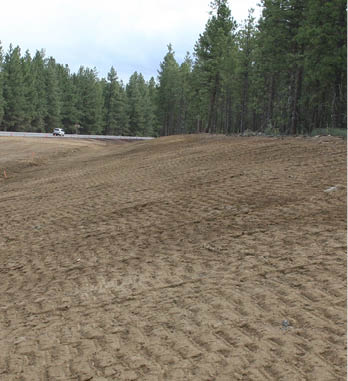
Figure 5-13 | Trackwalking compacts soils
Trackwalking creates imprints on the soil surface, but will also compact surface and subsurface soils.
Photo credit: David Steinfeld
If the last operation on a construction site is to subsoil or rip soils 1.5 to 2 feet deep and leave the soil in a decompacted condition prior to revegetation, trackwalking would be more detrimental than beneficial on most soils in the long-term. The weight of the tractor used to create imprints would compact the tilled soil leaving the surface smoother (less rough) than if left alone. As noted before (Chapter 3.8.2 Soil Structure), compaction reduces infiltration and increases runoff; therefore, trackwalking has the potential to increase in soil erosion. Rainfall simulation tests can be run on sites near the construction project that have been trackwalked and compared with those that have been left in an uncompacted state to determine the effects on runoff and soil erosion (Hogan and others 2007).
An alternative to trackwalking is the use of the bucket of an excavator to pack and imprint the soil surface. Different patterns of steel "teeth" can be welded on the face of the bucket to achieve the desired surface micro-relief. Figure 5-14 shows an excavator bucket, with four strips of angle iron welded to its face, to create a pattern of 3-inch-deep impressions. The excavator, in this example, moves topsoil to the site, shapes the cut and fill slopes, and imprints the surface, all with one operation.
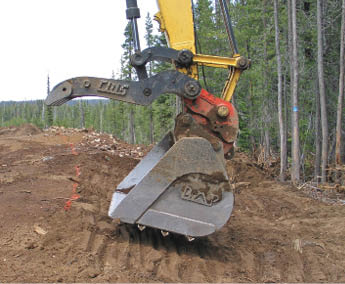
Figure 5-14 | Soil imprinting with modified excavator bucket
An alternative form of imprinting road cuts and fills that does not compact soils is welding angle iron onto the bucket of an excavator. As the excavator pulls topsoil into place and contours the slope, it presses the face of the bucket into the soil surface to form surface imprints.
Photo credit: David Steinfeld
5.2.3 Mulches
Introduction
Mulch is defined as a protective material placed on the soil surface to prevent evaporation, moderate surface temperatures, prevent weed establishment, enrich the soil, and reduce erosion. Mulches, therefore, have many functions or roles in the recovery of native vegetation to a disturbed site. Confusion often arises around the use of mulches on revegetation projects unless the reasons for using them are clearly defined. In this discussion, mulches are grouped into four uses based on the revegetation objectives:
- Seed Covering
- Seedling Mulch
- Soil Improvement
- Seed Supply
For most projects, mulches are used to meet more than one objective but this is problematic when the methods for achieving more than one objectives are not compatible. For example, erosion-control products and practices that are effective for controlling surface erosion are not always optimal for establishing vegetation. For this reason, it is important to understand the objectives for mulching when selecting mulch types and application methods.
This section describes the objectives for applying mulches and the potential mulch sources. Many publications and much research are available on the effectiveness of mulches for erosion control and surface stabilization. This discussion focuses primarily on the characteristics of mulches for plant establishment.
Seed Covering
One of the principal reasons for applying mulch is to enhance seed germination and early seedling establishment. During this critical period, desirable mulches will:
- Protect seeds and young seedlings from soil splash, sheet erosion, and freeze-thaw
- Keep seeds moist during germination
- Keep soils moist during seedling establishment
- Moderate surface temperatures during germination
- Prevent salts from wicking to the surface and harming germinating seedlings
The characteristics of mulch materials that make an ideal seed covering are those that protect seeds from drying winds, solar radiation, high evapotranspiration rates, and surface erosion while still allowing seeds to germinate and grow through the mulch into healthy seedlings. Long-fibered mulches placed at the appropriate thickness, usually meet these characteristics. A long-fibered mulch is composed of particles that are long and thin (at least several inches long with a length to width ratios of greater than 4:1). Such materials include straw, wood strands, pine needles, and shredded wood (ground or chipped woody material).
When applied correctly, the strands of long-fibered mulch loosely pack over each other, much like "pick- up-sticks," forming large air spaces or pores (Figure 5-15). Large pores function much like the air spaces in building insulation by moderating extreme temperatures. The bridging effect of the long particles also makes some of these materials more stable, and less prone to erosion or movement. Depending on the long-fibered material and erosivity of the site, it may not be necessary to apply a tackifier, though heavier materials, such as shredded woods or wood strands are less susceptible to wind displacement than lighter material like straw. Long-fibered materials that are not recommended for mulch unless they are stabilized include shavings and materials less than two inches in length (Robichaud 2013).

Figure 5-15 | Long-fibered mulches
Long-fibered mulches, such as the wood strands shown below, create a good growing environment because seeds and seedlings are protected from excessive drying during germination and early seedling establishment. On sites where freeze-thaw is prevalent, long-fibered mulches can insulate the soil and protect emerging seedlings.
Photo credit: David Steinfeld
Short-fibered mulches are much shorter in length and are typical of materials found in hydromulches. Comparing short-fibered mulches to long-fibered mulches, long-fibered mulches can be applied at greater thicknesses, which help maintain surface soil moisture and higher humidity around germinating seeds and emerging seedlings. In addition, long-fibered mulches can mitigate the effects of frost heaving at the soil surface (Kay 1978), significantly reduce high surface temperatures (Slick and Curtis 1985), and allow sunlight penetration, which enhances seed germination and seedling establishment. Large pores created by long-fibered mulches also allow better gas exchange between the soil and atmosphere (Borland 1990).
Short-fibered mulches usually have smaller pores and form denser seed covers. These materials are applied (Figure 5-16); therefore, they offer less insulation than long- fibered mulches and have less value as a seed covering. Some researchers suggest that very fine textured mulches can increase surface evaporation by wicking moisture from the soil to the surface of the mulch (Slick and Curtis 1985; Borland 1990; Bainbridge and others 2001). These types of mulches are derived from several sources: paper fiber, which provides little cover or slope protection and more typically, wood fiber, which offers longer duration cover and slope protection. Short-fibered mulches are effective as an erosion-control cover when applied with a tackifier, but many are considered inferior to long-fibered mulches for germination and early seedling establishment (Kill and Foote 1971; Meyer and others 1971; Kay 1974, 1978, 1983; Racey and Raitanen 1983; Dyer 1984; Wolf and others 1984; Norland 2000). Recently developed products, like bonded-fiber-matrix (BFM) and High Performance Growth Media, are also applied hydraulically, but their fibers are mechanically kinked so that when applied at recommended rates provide loft and pore space suitable for better seed germination while also providing a high level of slope protection (Figure 5-17).
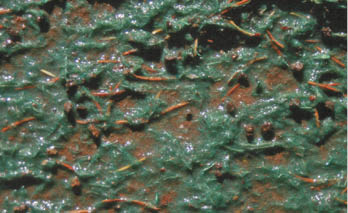
Figure 5-16 | Hydromulch
Hydromulch with tackifier can stabilize the soil surface for up to a year but does not necessarily create an optimum environment for germinating seeds. The short-fibered textures typically form a covering that is too thin to maintain moisture around the seeds during germination when the weather is dry. The hydromulch (dyed with a green tracer) shown in this picture is applied at approximately 1,500 lb/ac. This low application rate may be acceptable on sites where soil erosion potential is low and surface soil moisture is high and seeds do not need to be covered for germination.
Photo credit: David Steinfeld
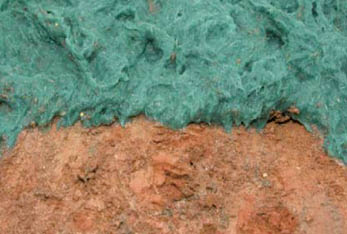
Figure 5-17 | High performance growth media
At 4,000 pounds per acre, High Performance Growth Media, such as Flexterra®, provides a quarter of an inch of loft which creates a better environment for germination than hydromulch.
Photo credit: Profile Product
Compost are being used with increasing frequency on projects as a seed mulch. Composts are different from long-fibered mulches in that the fibers are much shorter in length (typically less than an inch) and composted. Because they have less loft, compared to long-fibered mulches, they do not perform as well, and may dry out faster, which could reduce germination rates on drier sites. When composts are applied to a slope with pneumatic blower or a high-speed conveyor to depths ranging from 1 to 2 inches, it is called a compost blanket. Seeding involves applying the compost blanket, then seeding and covering the seed with ¼" to ½" depth over the seed. Most pneumatic blowers can mix seed with the compost and apply it as a thin layer over the compost blanket as a final pass. This is the easiest method but if this is done, then increasing the seeding rate should be consider because some seeds will be near or on the surface of the compost, lowering the germination rate of the seed mix. Applying seeds with a pneumatic mulch blower is done by placing seeds in a "seed metering bin" attached to most mulch-blowing equipment. This equipment meters seeds into the mulch as it is being applied. The rate at which the metering system delivers seeds is calibrated prior to mulching to obtain the desired seed density (refer to Section 5.4.1, for seed calibration methods).
The application of a tackifier is important because the medium-length fibers of compost do not provide enough weight and bridging between particles to provide protection from wind and water erosion. With tackifiers, composts can adhere to steep slopes in high rainfall areas. Compost blankets have a high moisture holding capacity and its dark color captures heat which aids germination. In addition, compost blankets provide nutrients to plants, which eliminates the need for fertilizer, and over time increases soil organic matter. Compost derived from yard debris is readily available in some areas where it is produced to eliminate organic matter from the waste stream.
Erosion mats are another type of seed cover (Section 5.2.3, see Erosion Mats). These materials come in rolls or sheets, which are laid out on disturbed soils and anchored in place after seeds have been sown. They are composed of such materials as polypropylene, straw, coconut, hay, wood excelsior, and jute. Good characteristics of erosion mats for seed germination and early seedling growth are those with enough loft, or porosity, to provide for optimum seed germination. Erosion mats create a micro-environment for seed germination while protecting the soil and allowing some sunlight to penetrate to the surface of (Figure 5-18). It is important to recognize that the plastic netting in these mats degrade at varying rates depending on the climate and soil conditions. For example, on cool-dry sites, typical of high elevations, decomposition rates are slow and plastic may last for many years. Plastic netting that does not break down quickly can be a hazard to wildlife, entangling amphibians, reptiles, and birds. To reduce this hazard, many state DOTs are requiring that all erosion control mattings be fully biodegradable.
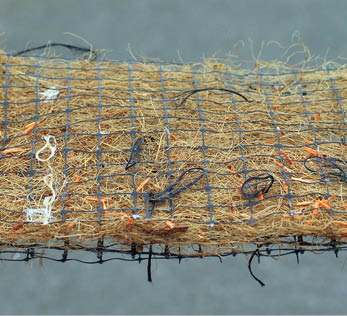
Figure 5-18 | Erosion mat
Erosion mats can be good seed covers. Mats with the highest loft create the best microenvironment for seed germination while allowing some sunlight to penetrate to the surface of the soil. A consideration of the use of these products is how fast they decompose and the effects on wildlife.
Photo credit: David Steinfeld
On sites where vegetation is expected to take several years to establish (e.g., arid, high elevation sites), it is important to apply a mulch with a longevity of more than one year. Materials with greatest longevity are most long-fibered wood mulches, as well as erosion mats made from coconut fiber. Straw, hay, and short-fibered products are less likely to be present after the first year however a High Performance Growth Media is available that is made of coconut fiber and it claims a 24-month functional life.
Mulching for seed covering is critical on sites that have high evapotranspiration rates during germination, unstable soil surfaces, susceptibility to freeze-thaw, or high soil pH. Mulching may be less important on sites where soil surfaces do not dry out during seed germination or on projects where seeds have been covered by soil.
Seedling Mulch
Mulch is placed around newly planted or established plants to improve survival and growing conditions by:
- Reducing surface evaporation
- Preventing the establishment of competing vegetation
- Moderating surface temperatures
- Allowing water infiltration
Studies have shown that survival and growth of young trees are significantly increased by applying mulches around seedlings at the time of planting (DeByle 1969; Lowenstein and Pitkin 1970; Davies 1988a, 1988b). Mulching around seedlings results in the greatest benefit on hot and dry sites (typically south and west aspects) and sites with aggressive competing vegetation. It is less important to apply mulch around seedlings on sites that have a low potential for establishing competing vegetation the first several years after planting or sites that have low evapotranspiration rates or high rainfall during the summer months.
Seedling mulches are applied either as an organic aggregate, rock, or as sheet mulches. Organic aggregate mulches consist of shredded or chipped wood derived from bark, wood, branches, sawdust, or lawn clippings. Rock aggregate mulches consist of a layer of rocks placed around each seedling. Sheet mulches are large pieces of non- permeable or slightly permeable materials made from translucent plastic, newspaper, coconut fiber, or geotextiles (woven fabrics) that are anchored around planted seedlings (Figure 5-19).
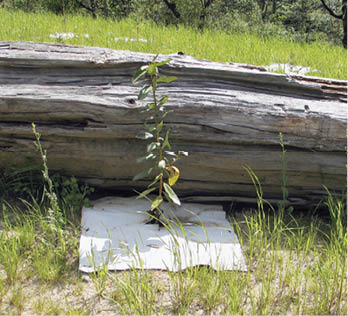
Figure 5-19 | Sheet mulch
Sheet mulches come in a variety of materials, such as the paper/cardboard product shown in this picture. The size of the sheet mulch is large enough to keep competing vegetation away from the seedling. The 3-by-3-foot sheet mulch shown around this Pacific madrone (Arbutus menziesii) seedling is the minimum size for this site.
Photo credit: David Steinfeld
Sheet Mulches—A variety of sheet mulches are available commercially. These mulches are popular because of the relative ease of transport and installation. The effectiveness of sheet mulches increases with the size of the sheets. For most hot, dry sites, a 2.5-by-2.5-foot sheet is considered the minimum dimension (Cleary and others 1988). On harsher sites, 3-by-3-foot or even 4-by-4-foot sheets are necessary to control competing vegetation. When purchasing and installing sheet mulches, it is important to consider (after Davies 1988a, 1988b):
- Selecting the right size—The size of the mulch is based on site conditions and the type and amount of competing vegetation. For example, a hot, south-facing site with full cover of competing grasses will need a large sheet mulch; a north-facing slope with scattered forbs and grasses will suffice with a smaller size.
- Ordering only opaque materials—Translucent materials are not used as sheet mulches because weed seeds can germinate and grow under these materials. During summer, surface temperatures under translucent materials can be lethal to seedling roots.
- Using sheet mulches with long life spans—It often takes three to five years for seedlings to become established on hot, dry sites and for this reason it is recommended that the sheet mulch have a durability of three years (Cleary and others 1988). The use of fully biodegradable materials is recommended.
- Weeding or scalp around seedlings prior to installation—Sheet mulch cannot be installed properly without vegetation being completely removed.
- Mulching immediately after planting—In Mediterranean climates, waiting until later in the spring to mulch runs the risk that competing vegetation will have depleted soil moisture, thereby making the mulch ineffective during the first growing season. This can be avoided, by applying mulch during or immediately after seedlings are planted.
- Staking or anchoring all corners of the mulch—The sides of the mulch sheets can be easily detached by wind, animals, or competing vegetation growing under the mulch sheets. It is important that the corners are staked. Burying all edges of the sheets with soil provides the greatest effectiveness.
- Visibility—Sheet mulches can be very apparent in high visibility areas. Measures to reduce unsightliness of sheet mulches include covering with aggregate mulches such as hay, straw, or wood mulch, or selecting sheet colors that blend into the area.
Organic Aggregate Mulch—Organic aggregates are another group of materials that, when placed thickly around installed plants, will control the establishment of competing vegetation and reduce surface evaporation (Figure 5-20). These aggregates include hay, straw, or chipped and shredded wood materials. Organic aggregates are often used in highly visible areas because they are more aesthetic in appearance than sheet mulches. They are also used in planting islands for long-term control of competing vegetation.
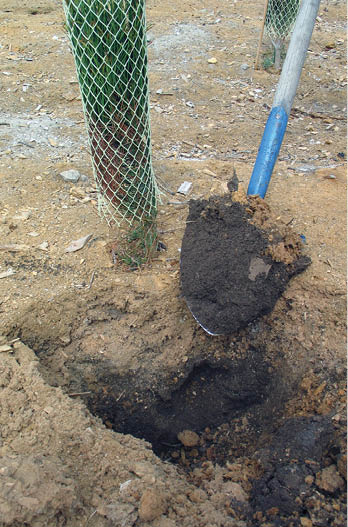
Figure 5-20 | Mulch conserves soil moisture and inhibits the establishment of unwanted vegetation
This photograph was taken in late summer, months after adjacent soils had dried out. The lack of competing vegetation and the low surface evaporation resulting from the placement of 3 to 4 inches of coarse sawdust resulted in very high soil moisture. In addition, the high C:N ratio of the sawdust was believed to be a factor in inhibiting the establishment of unwanted vegetation.
Photo credit: David Steinfeld
The longevity of organic aggregate mulches is a function of the C:N ratio, texture, and depth. High C:N materials, such as uncomposted shredded wood, bark, or sawdust, will last longer than low C:N materials, such as composted yard materials, because these materials are in the initial stages of the decomposition cycle. Coarse-textured materials (Figure 5-21 A, B, C E, F), which include long-fibered mulches have greater longevity than finer-textured materials (Figure 5-21D) because coarser materials have less surface area per volume of material for microbial break down (Slick and Curtis 1985). Coarse-textured materials also tend to hold less moisture, which slows decomposition rates. The longevity of an organic aggregate mulch also depends on the application thickness—the thicker the layer of mulch, the longer it will last. In many climates, coarse-textured materials, such as shredded wood, can last for years on the surface of the soil.
Figure 5-21 | Different types and textures of organic aggregate mulches
(A) freshly ground coarse shredded wood passing a 3-inch screen; (B) freshly ground coarse shredded wood passing a 1.5-inch screen; (C) freshly chipped wood; (D) composted mixtures of ground wood, biosolids, and yard wastes passing a 1.5-inch screen; (E) weathered straw; (F) ponderosa pine needles. All materials are coarse textured except compost (D).
Photo credit: David Steinfeld
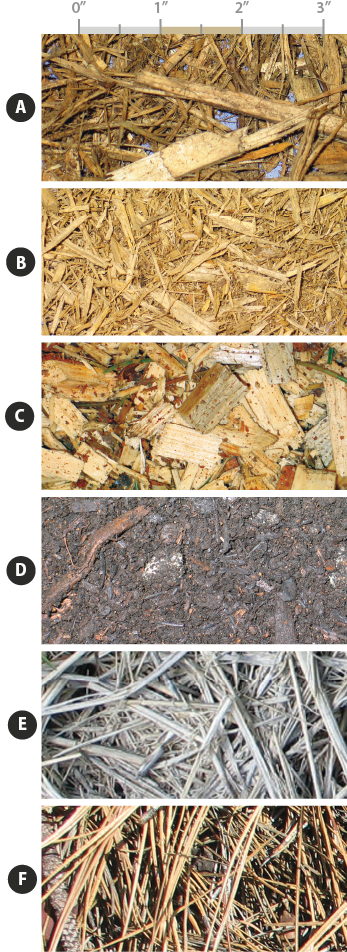
The same factors that affect longevity (e.g., texture, C:N ratio, depth) also determine the effectiveness of aggregate mulches in deterring seed germination of unwanted vegetation around the seedling. Coarse-textured mulches are excellent because they hold very little moisture at the mulch surface and, therefore, are poor environments for seed germination of unwanted vegetation. Alternatively, fine-textured mulches create a more favorable environment for seed germination because they hold more moisture and are in closer contact with seeds. For this reason, many fine-textured materials, such as composts, are excellent growing media for weed seed germination and establishment. As discussed in Section 3.11.4, mulch materials with high C:N ratios discourage growth of weedy annuals because high C:N materials remove available nitrogen that would otherwise give these species a competitive advantage. The effectiveness of a mulch in discouraging the establishment of competing vegetation generally increases with the thickness with which it is placed on the soil surface (Baskin and Baskin 1989). The most effective mulch thicknesses are between 3 and 4 inches (Pellett and Heleba 1995; Ozores-Hampton 1998), but thicknesses as low as 1.5 inches are effective for some small-seeded weed species that need sunlight for germination (Penny and Neal 2003).
Organic aggregate mulches have several advantages over sheet mulches. First, organic mulches can be applied over a much larger area than sheet mulches. Some projects have organic mulches covering the entire site, while other projects concentrate it in strategic areas, such as planting islands. Second, organic aggregate mulches moderate surface soil temperatures, whereas sheet mulches can increase surface temperatures. Mulch thicknesses of 3 inches have been found to reduce soil temperatures below mulch layers by 8 to 10 ° F (Slick and Curtis 1985; Steinfeld 2004), which can benefit the growth of seedlings on very hot sites. The insulative quality of mulches also affects the seasonal heating and cooling patterns in the soil. Soils under thick mulches take longer to warm in the spring, but in the fall, take longer to cool down. Depending on the temperature and rainfall patterns of a site, this could influence seedling establishment.
Mulch can create problems to planted seedlings if it is placed in contact with the plant stem. The high moisture around the stem can be conducive to pathogenic injury. On southern exposures, heat will build up at the surface of, and directly above, the mulch, creating extremely high temperatures on warm summer days. The high temperatures can cause heat damage to stems of young seedlings. It is important, therefore, to keep mulch several inches away from the stem of planted seedlings.
Rock Mulch—Rock can be an effective mulch cover around seedlings. It consists of placing any size rock fraction (e.g. gravels, cobbles, stones) around each seedling. Rock protects the surface from erosion, evaporation, and weed establishment and it may be naturally available on a project site. As with organic aggregate mulches, rock is placed in a 1 to 2 feet radius around and at least several inches deep. Rock is kept away from the stem of the seedling to avoid heat damage. Prior to installation, unwanted vegetation is removed. One of the disadvantages of using rock mulch is that rock fragments can move downslope on steeper slope gradients and bury seedlings. Applying rock on gentler slopes or creating small planting benches where mulch can be placed around the seedling are recommended options.
Soil Improvement
Mulches are sometimes used specifically to increase the nutrient and organic matter status of a soil. Composted organic materials are used for these purposes and are characterized by having low C:N ratios, high nutrient levels, fine textures, and dark colors. While these materials are typically more effective when incorporated into the soil, they are sometimes applied to the surface of the soil where tillage is not feasible (steep and rocky) or tillage costs are unaffordable. Where composted organic materials are applied on the soil surface, the nutrient release rates will be much slower. Refer to Section 5.2.5 for more information on composts.
Seed Supply
The objectives for applying mulch on some projects are to spread materials that contain native seeds. Several mulch materials carry native seeds, including duff, litter, and straw from native seed production fields. When these materials are applied to the soil surface, seeds will germinate given favorable environmental conditions.
Litter and duff are organic layers that form on the surface of the soil under tree and shrub plant communities. They are years of accumulated leaves and needles at varying degrees of decomposition. Included in these layers are dormant seeds, many of which are still viable. When the duff and litter are collected and spread on disturbed sites, the environmental conditions for breaking the dormancy of the seeds present in the material may be met and seeds will germinate.
Litter and duff can be collected from adjacent forest- or shrub-dominated sites or salvaged prior to slope construction. Reapplying them to disturbed sites completes several operations at once: supplies native seeds, covers seeds, and increases long-term nutrient capital. Although this practice might seem expensive or impractical, when compared with purchasing and applying seeds, fertilizer, and mulch separately, the costs could be comparable. Refer to Section 5.2.3, see Litter and Duff for more information on litter and duff.
One of the byproducts of native grass seed production is the stubble that remains in the fields after seed harvest. This stubble contains varying quantities of unharvested seeds which eventually end up in bales. If bales are stored in dry conditions, seeds can remain viable for several years. When hay bales that contain the native seeds are spread as a mulch on disturbed sites, seeds come into contact with soil and eventually germinate. It is important when acquiring native hay that the species and the source of the seed lot is appropriate for the site. Refer to Section 5.2.3, see Straw and Hay, for more information on straw and hay.
Selecting the Appropriate Mulch Materials
A variety of materials can be used as mulches, including the following:
- Shredded wood
- Erosion mats
- Hay and straw
- Manufactured wood strands
- Duff and Litter
- Composts
- Hydromulch
The following sections describe these materials and how they are used in revegetation projects. Figure 5-21 shows examples of some of these mulches.
Shredded Wood
Mulches produced from woody materials are used primarily for seed covering and seedling mulching. There is usually a readily available source of wood material from project sites situated in forested environments. Branches, stems, bark, and root wads are typical waste products from clearing and grubbing that can be shredded, chipped or mulched on site to produce various types of wood mulch. In the past, this material has been burned or hauled to waste areas for disposal. With greater burning restrictions and higher hauling costs, chipping these materials and returning them to disturbed sites as mulch are practices that are becoming more common.
Shredded Wood Production—Creating mulch from right-of-way clearing woody material requires planning and coordination. First the road contractor piles the woody right-of-way clearing debris into "slash piles." These piles include tree boles, bark, branches, and stumps, but it cannot contain large rocks or other inert materials that can cause wear or damage to the equipment. When clearing and piling is completed, a company that specializes in processing wood waste is contracted (typically by the road contractor). In this operation, equipment is brought to each slash pile and materials in these piles are processed into mulch. The resulting wood mulch is either placed in piles adjacent to the slash piles or transported to designated storage sites (Figure 5-22). The timing of these operations may be limited by fire restrictions in the western United States from mid-summer through early fall.
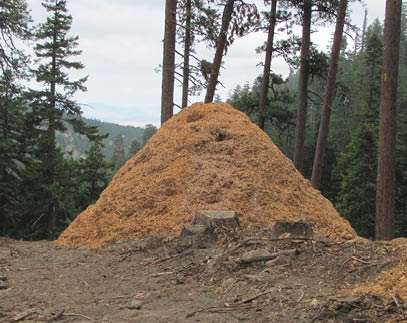
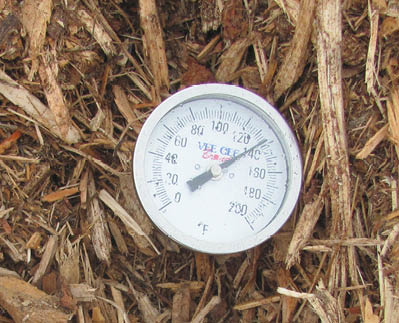
Figure 5-22 | Shredded wood piles are kept below 12 feet for safety reasons
Shredded wood piles generate heat as they compost (A). A 4-foot-long thermometer (B) can be inserted into the pile to determine internal pile temperatures. Some operations require piles to be turned when a specific temperature is reached.
Photo credit: David Steinfeld
If undesirable plant species are included in the slash piles, spread of these species is likely to occur when they are processed and applied as a mulch. This can be prevented by identifying these plant populations on site during the weed assessment (Section 3.11.6) and avoiding placing them into slash piles.
It is important to define the desired mulch characteristics prior to processing the piles. For example, the size and shape of the wood particles will determine their stability and propensity to move down slopes. Long strains of wood particles tend to be more stable than short strains because they knit together and have greater weight. Obtaining the proper size and dimension can be difficult because there is a variety of wood waste reduction equipment that produce different dimensions and fibrosity (the degree that wood fibers are separated). Obtaining the desired the particle size and shape by specifying a screen size the material should pass does not always produce the desired material. Screens only sort for two dimensions, and not for length or fibrousness. Identifying the type of waste reduction equipment can narrow the type of mulch produced (Table 5-7). For example, mulch produced by shredders is long and fibrous (Figure 5-23A and B), whereas mulch produced from chippers has sides that are of nearly equal lengths, with fibers still intact (Figure 5-23C). It is important that the correct equipment and screen sizes are used. It can be beneficial for the designer to request the contractor processing the material to send a sample of the different mulches that their equipment produces. In addition, being present at the beginning of the operations can assure that the proper material is being produced.
Table 5-7 | General types of wood waste reduction equipment
Modified from Re-Sourcing Associates and CPM Consultants 1997
General equipment types |
Examples |
Feedstock |
Particle geometry |
Chippers |
Disc chippers, drum chippers |
Whole logs, clean residuals |
Clean edge, two-sided |
Hogs |
Swing hammer, fixed hammer, punch and die, mass rotor |
Wood waste, stumps, land clearing debris |
Coarse, multi-surfaced, fibrous |
Shredders |
Low speed-high torque, high speed |
Wood waste, stumps, land clearing debris |
Coarse, multi-surfaced, fibrous |
Hybrids |
Knife hogs, pan and disc |
Wood waste, stumps, land clearing debris |
Semi-coarse |
Generally, the coarser the size of the mulch, the less expensive the production costs because more mulch of coarser size can be produced in a given time frame than smaller textured mulch. Other factors, such as tree species, moisture content, and portion of tree processed, affect the characteristics of the mulch. If the wood is wet during processing, it is more likely to be shredded; if it is dry, it will be more chip-like. There is also variation in mulches based on species of origin. For example, ponderosa pine (Pinus ponderosa) and western juniper (Juniperus occidentalis) tend to create more fibrous mulch than lodgepole pine (Pinus contorta). Processed root wads tend to be more fibrous than boles of trees. They may also contain large rocks which will damage processing equipment and need to be removed prior to processing or set aside and not used.
The shredded wood operation requires space to store the pre-processed woody debris, operate the processing equipment, and a storage site for the processed shredded wood. Depending on the operation, this could require a significant area. It is important to consider the size of the processed shredded wood piles when determining space requirements. Standards for pile heights of no greater than 12 feet are often used for fire and safety reasons. Piles larger than this height may be prone to spontaneous combustion. Long stemmed thermometers are available to monitor interior pile temperatures. One consideration for pile locations is the distance to the areas being mulched. Travel time between mulch piles and application areas can be as longer than the actual application of the material.
Purchasing Shredded Wood—On projects where waste materials are not available for mulching, purchasing shredded wood may be an option. Overall costs are much higher than processing waste wood on site because of the purchase of the material and transporting to the site. If commercial mulch sources are nearby, transportation costs are significantly reduced. Testing the shredded wood is important to obtain suitable material. Methods and specifications can be developed that are similar to those provided in Section 5.2.5.
Applying Shredded Wood—Shredded wood is applied in several ways—pneumatic mulch-blowing equipment, adapted manure spreaders, and rock slingers. Pneumatic mulch blowing equipment (Section 5.2.3, see Seed Covering) has varying transport capacities, ranging from 25 to 100 yards of material (Figure 5-23).
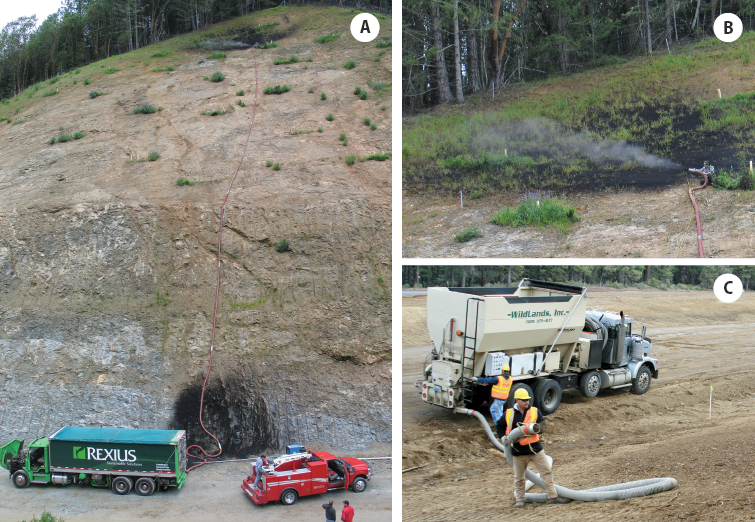
Figure 5-23 | Blowing equipment is used to apply mulch on steep slopes
Compost and shredded wood are applied on steeper slopes with mulch blowing equipment which is pneumatically delivered to the site through an application hose that can reach several hundred feet up steep slopes (A) with enough force for ample delivery of mulch (Image B is a close up of the application of mulch near the top of Image A). Large trucks can hold between 75 and 100 yards of mulch (A), while smaller trucks can hold up to 25 yards (C). A tackifier is added to compost to increase surface stability on steep slopes.
Photo credit: David Steinfeld
An application hose is positioned where mulch is to be applied and is pneumatically delivered from the mulch bins to the site. The amount of mulch applied depends on the revegetation objective. For seeding, application rates range from 100 yd3/ac (0.75-inch thickness) to 135 yd3/ac (1.0-inch thickness). For seedlings, mulch application ranges from 400 yd3/ac (3-inch thickness) to 540 yd3/ac (4-inch thickness). Note: The higher rates used for mulching seedlings are only used in close proximity to the plants. The remaining areas are mulched at a lower rate.
When applying shredded wood for erosion control objectives, the particle size of the material may be as important as the amount of material applied. On compacted soils, where overland flow is expected from heavy rainstorms, shredded wood lacking material smaller than an inch thick in length performs better in reducing sediment loss than material with finer wood. This coarse material can be applied at 50 to 60 percent ground coverage with good erosion control (Foltz and Wagenbrenner 2010).
Application rates depend on factors such as length and diameter of hose, blowing equipment, elevation rise, and dimensions of the area being covered. Rates of application typically range from 25 to 35 yd3/hr. If mulch is applied at a 1-inch depth (134 yd3/ac), it would take between 4 to 5 hours to cover an acre. These are optimum rates because they do not account for the time it takes to travel to the mulch source, load the mulch bin, and travel back to the application site. The time required to make these trips can sometimes be longer than the actual application time for mulching. Using larger transport capacities is one way to significantly reduce the time associated with refilling mulch bins.
Mulch blowing equipment can be used on any slope gradient that can be accessed by foot. By using ropes, slope gradients of up to 1H:1V can be accessed. Hose lengths can be attached to extend the delivery of mulch up to 400 feet. Because mulch is delivered through hoses, the system will plug if the size of the shredded wood exceeds the tube size. It is therefore important that mulch be free of large pieces of wood. Using a mulch blower is an excellent method for evenly applying shredded wood, but frequent monitoring by inspectors is important to ensure that the specified amount of mulch is being applied.
Shredded wood can also be applied with modified manure spreaders (Figure 5-24). Depending on the type of modifications, this equipment can apply shredded wood at a much faster rate than mulch blowing equipment, however this equipment generally is limited by the distance it can cast the material which is typically ranges from 35 to 75 feet depending if it is being applied upslope (less distance) or downslope (greater distances). Tackifiers are not typically applied to shredded wood after it is placed because this material is less susceptible to wind erosion than mulches that are finer textured and lighter.

Figure 5-24 | A manure spreader adapted to side cast shredded wood
Shredded wood can also be casted from adapted manure spreaders. On this project, the seed mix was sown using a hydroseeder, then 0.75 inches of shredded wood was applied over the seeds.
Photo credit: David Steinfeld
Seed Placement during Mulching—Seeds can be sown prior to or during mulch operation. Seeds that are sown prior to mulching can be done with dryland sowing methods, hydroseeding, or through the pneumatic mulching equipment (Section 5.2.3, see Seed Covering). A thicker layer of shredded wood is applied in a second pass at a depth between 0.5 and 1.0 inches over the seed.
Erosion Mats
Erosion mats (e.g. erosion control revegetation mats and rolled erosion control products) are manufactured blankets or mats designed to increase surface stability and control erosion. They are applied in direct contact to the soil surface for control of sheet erosion and to aid in the establishment of vegetation.
A multitude of products are on the market, with a range in design and costs. Determining which products will meet project objectives at the right price can be challenging. Several State Departments of Transportation periodically evaluate and compare the shear stress, soil erosion protection, longevity, and other characteristics for these products (Caltrans 2003; Kemp 2006), and these documents are available on the internet. State of Washington and State of Oregon DOTs are moving to require that all erosion control mattings be fully biodegradable. Because the installed costs of erosion mats can be expensive, it is important that the job is done correctly. Taking the time to select the appropriate erosion mats, native species mix, and seed placement techniques is essential for ensuring that revegetation is successful. Small field trials using different species and erosion mats can help in these decisions (Figure 5-25).
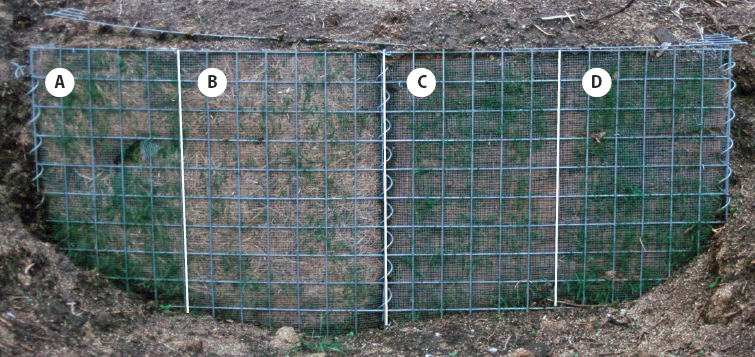
Figure 5-25 | Field trials of species and materials
Small field trials can help select the most appropriate species and materials for a project. The trial shown in this photograph compared straw mat (A and B) with a polywoven mat (C and D). It also compared the growth of blue wild rye (Elymus glaucus) and California fescue (Festuca californica) (A and C). The first-year results indicated that there was much better establishment of grasses on the polywoven erosion mat than the straw mat, yet no difference in species growth. Maintaining the trial for two years showed that California fescue outperformed blue wild rye. These results led to using California fescue and the polywoven erosion mat for the project described in Inset 5-3.
Photo credit: David Steinfeld
The same characteristics that create an optimum environment for seed germination in other mulches are also important to consider when selecting erosion mats. Typically, products that protect the seeds from drying out but allow light and space for germinating seeds to grow into seedlings will perform best for vegetation establishment. The thicker erosion mats with the most loft typically have better conditions for seedling establishment than thinner materials however, if the mat is too thick, seedlings will not be able to emerge from the fabric.
The drawbacks to erosion mats are generally not in the product itself but in how it is applied to the site. Poorly applied erosion mats can result in sheet and rill erosion under the fabric. To avoid this problem, several important measures can be taken when installing erosion mats. First the surface of the soil is smoothed to a uniform surface texture before the mat is placed. Landscape staples or pins are then installed at a specified spacing to hold the matting and ensure in intimate contact with the soil surface. The matting is trenched or keyed into the soil at the upper reaches of the fabric to prevent overland water flow from undercutting the mats.
Seeds are sown on the site prior to installing erosion mats. Because installation is commonly performed by the road building contractor, it is important that the designer works with the contractor to assure that seeds are being sown during the seeding windows. Seeding can be done using any type of seeding method (e.g., hydroseed, drill, or hand broadcast) however, once the slopes have been sown, care must be taken during and after mat installation to avoid disturbing the seed. Unless the seeds are extremely small, sowing seeds over installed erosion mats is not recommended because larger seeds will hang up in the fabric. Small seeds can be applied over erosion mats if tackifiers are not used and if the timing is such that sufficient rain will move it through the erosion mat to the soil surface.
Some manufacturers offer erosion mats that are impregnated with seeds, eliminating the need for sowing. This method is advantageous on steep slopes or soil-faced gabion walls (Inset 5-3) where placing seed prior to mat installation is difficult. It is important to work directly with companies that provide these products by supplying them with source-specific seeds and specifying appropriate sowing rates. For successful germination, seeded erosion matts are installed so that seeds and fabric are in direct contact with the soil. This method works best in environments with reliable moisture during germination.
Inset 5-3 | Case Study—Erosion mats with native grasses and forbs
Reconstruction of the Agness-Illahe Highway required building long sections of gabion walls. Because this highway was visible from the Rogue River (a designated "wild and scenic" river in southwestern Oregon) and was heavily traveled by river runners and fishermen, it was important that the gabion walls be visually screened using native plants. Gabions were designed to hold 12 inches of compost-amended soil (topsoil was not available) on the face of the walls by wire mesh frames (Image A in the illustration below). Placement of seeds at the surface of the gabion wall was problematic. Several small plots using different erosion mats, seed mixes, seed rates, and seed-attaching methods were tested to determine how to best meet the revegetation objectives (Figure 5-25).
The results from these trials indicated that native grass and forb seeds could be attached to erosion mats using a tackifier (Image B). In 2003, the findings were applied to the construction project. Needing approximately 33,000 ft2 of gabion wall facing, the erosion mats were prepared by rolling them out on a road surface, applying California fescue (Festuca californica), gluing the seeds to the mat, and re-rolling the erosion mats.
The seeds held tightly to the fabric during transportation and handling. At the construction site, seeded mats were attached to the wire mesh at the face of the wall (Image C) and compost-amended soil was placed behind the screen and lightly tamped. The gabion walls were built in the summer of 2003, but the seeds did not germinate until late fall after several rainstorms. Image D shows a close-up section of wall with newly germinating seedlings emerging through the erosion mat in late 2003, four months after wall construction. Image E shows 20- to 30-foot-high walls in July 2006, three years later, fully vegetated and effectively screening the walls from the road and river (Image C courtesy of Scott Blower). For more detail, see the Native Revegetation Resource Library.
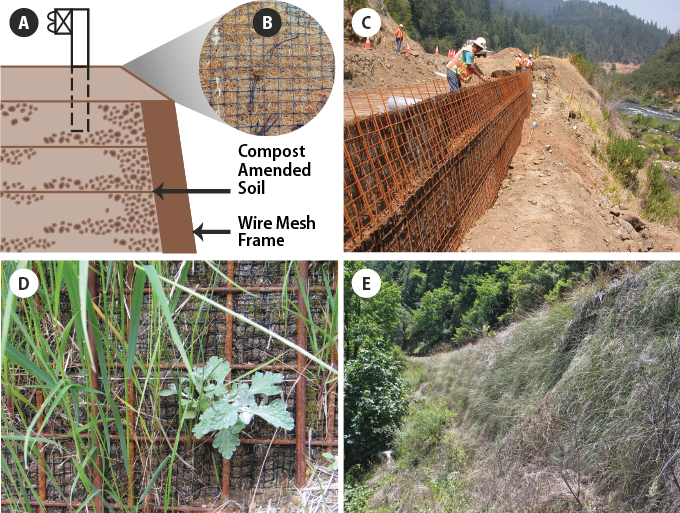
Straw and Hay
Straw and hay are long-fibered mulches used on many revegetation projects for seed cover and erosion control (Image E in the illustration in Inset 5-3). The terms "straw" and "hay" are often used interchangeably, however there are distinct differences—straw is the stubble left over after seeds have been harvested from commercial seed or grain crops while hay comes from grass/legume fields and usually the whole plant baled for stock feed. When hay is harvested, it usually contains seeds from a variety of pasture species.
Straw and hay are often used on revegetation projects because they are available, comparatively inexpensive, and generally successful in establishing grass and forb plants from seeds. The long stems of these materials create loft, or high porosity, that keeps moisture near the soil surface where seeds are germinating. This creates a favorable environment for young seedlings by allowing sunlight to penetrate and protecting the young seedlings during the early stages of establishment.
Straw is often preferred over hay because it generally contains fewer undesirable seeds and the seeds that are contained in straw are not always inappropriate for use in revegetation projects. For example, straw from some grain production fields (e.g., rice straw) has seeds of species that are not adapted to many environments and therefore may not become established. Straw produced from native seed production fields may have desirable seeds if the fields are grown from identified genetic sources and used for projects within the appropriate seed transfer zones (Inset 5-4). Using source-identified straw not only act as a mulch when it is applied, but it also supplies extra native seeds to the site. Some native grass species grown for seed production are very difficult to harvest and clean. One strategy for these species is to allow the seeds to ripen in the fields and bale the seeds and stems together. The seeded bales can be applied directly to the site through straw blowing equipment, accomplishing seeding and mulching in one operation.
Inset 5-4 | Source identified straw bales
A secondary product from the seed production contracts is the straw that remains after harvest. This material can be used for erosion control or seed covering. It can be used as a mulch and has the additional advantage of being a source of unharvested viable seed. This product must be treated similarly to certified straw sources (Section 5.2.3, see Straw and Hay). There should be no noxious or undesirable weed seed in the bales. A visit to the seed production fields prior to seed harvest will indicate if there are any unwanted species that will be present in the hay bales. Bales of each seedlot must be kept separate from other sources to prevent mixing. If straw bales are stored for any length of time, they must be protected from rain.
Purchasing Straw and Hay—The drawbacks to using straw and hay are that these materials can contain seeds from undesirable species, are susceptible to wind movement, may have limited application distance, and decompose in a relatively short time compared to other mulches. Introducing seeds of undesirable species from straw and hay sources is an important consideration when choosing a source. There are many examples where, in the urgency of erosion control, straw or hay from unknown sources has been applied, resulting in the introduction of weed species. The assumption is that short-term control of soil erosion and sediment production outweighs the long-term introduction of undesirable plant species. The possible results from these assumptions need to be understood and agreed upon prior to applying hay or straw from unknown sources. Good integration of erosion control and revegetation planning can eliminate the need for last-minute purchase and application of unknown or undesirable hay or straw sources.
Many states have certification programs that inspect fields and certify that the bales are "weed free" which means that the material is free of the noxious or listed weeds of the inspecting state. There can be other seeds in the bales, however, that may not be considered weeds by the certifying state, but unwanted on the project site. A conservative approach is to examine the fields that will produce the bales and observe which species are present before they are harvested. It can be assumed that if a species of grass or forb is present in a field, seeds from these plants will show up in the bales.
Some things to require when purchasing straw or hay are as follows:
- Does the source exceed State Certification Standards for "weed free"? Many states have straw certification programs but for states where no standard programs exist, acceptance can be based on seed crop inspection reports and/or visual field inspections prior to harvest. Standards may also be set by the Government and listed on individual task orders.
- Is straw or hay baled and secured? Generally, bales should be less than 100 pounds.
- Are bales wet after harvest or during storage prior to delivery? Not only is wet material harder to handle and less effective, mold is often present, which can pose respiratory risks to applicators.
The quality of straw and hay varies among grass species. Rice straw, for example, is wiry and does not readily shatter, which makes it more difficult to apply as compared to wheat, barley, or oats (Kay 1983; Jackson and others 1988). Native straw is generally longer and stronger than grain straw (Norland 2000), although some native species have better properties as mulches than others. Larger stemmed grasses, such as blue wildrye (Elymus glaucus), mountain brome (Bromus marginatus), and bluebunch wheatgrass (Pseudoroegneria spicata) make good mulches because of their large leaves and stems.

Figure 5-26 | Straw blower
Straw blowers range in size from machines that can apply 30 to 60 bales per hour (shown here) to very large straw blowers that can shoot up to 20 tons per hour.
Photo credit: David Steinfeld
Application—Straw and hay can be spread by hand or with a straw blower. For large jobs, using a straw blower is the most practical application method. Many types of straw blowers are available, ranging from very small systems (Figure 5-26) that deliver from 30 to 180 bales per hour to large straw blowers that operate at rates up to 20 tons per hour. The distance that straw or hay can be blown depends on the hay-blowing equipment, wind conditions during application, straw characteristics, and whether the material is being applied upslope or downslope (cuts or fills). When wind is favorable, straw can be shot up to 100 feet. However, when wind is blowing against the direction mulch is being applied, the distance is reduced. Because of the limited application range, this equipment is limited to sites adjacent to roads. The upper portions of steep, extensive slopes are typically not reachable by straw blowers.
When straw is used as a seed mulch, it is important that the application rates are not so deep that a physical barrier is formed. A minimum depth that has been shown to control evaporation is 1 inch (Slick and Curtis 1985). Applying too much straw will restrict sunlight and growing space for establishing seedlings. A rule of thumb is that some surface soil (15 percent to 20 percent) is visible through the straw after application (Kay 1972, 1983; Jackson and others 1988). This equates to 1.5 to 2 tons per acre, depending on the type of straw and its moisture content, though this rate should be adjusted based on the climate of the site.
Straw is susceptible to movement with moderate to high winds. Tackifiers are often applied over the straw to keep it in place (Kay 1978). Products such as guar and plantago are used with low quantities of hydromulch to bind straw together. Straw can also be crimped, rolled, or punched into the soil. A puncher is a roller with a set of straight studs, greater than 6 in long, that push straw into the soil. A crimper is similar but has serrated disks attached to a roller. This equipment stabilize the straw by burying portions of the stems into the soil and increase erosion protection because of the greater contact of straw with the soil surface. Some soil types may not be suitable for crimping, especially sandy soils that may not have the strength to hold straw in place. It is important to consider the potential for soil compaction that may result from heavy equipment on soils.
Wood Strands and Wood Wool
Wood strands and wood wool are commercially available wood products used for mulch. Wood strands are long, thin pieces of wood produced from wood waste veneer, whereas wood wool, known as excelsior, is wood slivers produced from aspen, spruce, and pine wood. These products are developed as an effective erosion-control alternative to straw and hay (Foltz and Dooley 2003). The advantages of wood strands and wood wool over straw are that they are free of seeds, have greater longevity, and more resistant to wind.
Wood strands and wood wool form a stable surface cover with high porosity or loft; characteristics that are important for controlling soil moisture and temperature around the germinating seeds. The large spaces or pores created by the wood strands allow space, light, and protection for young emerging seedlings (Figure 5-15). Unlike straw, these materials keep their structure or porosity over time and do not compress with snow or lose fiber strength until they begin to decompose. The application rates for wood strands follow the guides for straw—at least 15 percent to 20 percent of the soil surface is visible. This may result in a lower application rate than recommended for erosion control. Installing small test plots of varying thicknesses of mulch is a good means to determine the appropriate thickness for optimum seed germination and erosion control. Wood strands are delivered in different size bales and applied by hand or through straw-blowing equipment (Figure 5-26). As with straw, this product is limited by the accessibility of the site by hay transportation and blowing equipment.
Litter and Duff
Litter is the layer of fresh and partially decomposed needles and leaves that cover the surface of most forest and shrub plant community soils. Duff is the dark, decomposed layer directly below the litter layer (leaves and needles are not identifiable in the duff layer) that is high in nutrients and humus. In addition to providing soil protection and nutrients, litter and duff can contain dormant, yet viable, seeds from species that make up the forest or shrub plant communities (Section 5.2.3, see Seed Supply). When litter and duff are collected, they should be matched to the appropriate revegetation site. For example, litter and duff collected from cool, moist sites should not be applied on hot, dry sites.
The depth that litter and duff accumulates will vary by species composition, age, and productivity of the plant community. The quality of the litter for erosion control and longevity varies by the dominant forest or shrub species. Pine needles provide the greatest benefit because the long needles interlock, reducing the potential of movement from rain or wind erosion (Inset 5-5) (Image F in Figure 5-21). Needles from species such as Douglas-fir are shorter and tend to compact, providing less surface stability. Litter from deciduous tree and shrub plant communities provides less protection because the leaves are less interlocking, provide less loft, and often form a mat that can be difficult for germinating seeds. Nevertheless, these materials should not be overlooked because they can be a source of seeds and nutrients.
Inset 5-5 | Pine straw industry
Using forest litter as a mulch is not a new concept—pine needles have been a popular landscaping mulch in the southern United States for the past 25 years. The "pine straw" industry, as it is referred to, has been established to harvest needles in a sustainable manner from young plantations of southern pine species to meet this demand.
In the western states, litter has typically been collected manually by raking. The collection of litter has been mechanized in the southern United States, and the pine straw industry is well developed in this part of the country. Baling equipment has been developed for this industry and could be applicable to the western United States. Collection of needles and duff is done when the litter and duff are dry. If these materials are not used immediately, they are placed in small piles and covered with plastic to keep the materials dry. Excessive moisture can turn the piles into compost and possibly affect seed viability.
Litter and duff can be applied manually to disturbed sites. If the litter and duff is free of large materials, it can be applied in a variety of ways including pneumatic mulch blowers, straw blowers, and modified manure spreaders.
One method for determining the amount of viable seeds in a litter layer is to conduct a germination test at the project site over a several-year period by obtaining litter and duff from several potential collection areas and testing them on nearby sites. Dry litter and duff samples are collected from each plant communities and a known amount is weighed. The samples can either be spread in an area near the project (free of vegetation and topsoil) or on potting soil in a garden or greenhouse. In either case, the duff and litter is overwintered and a germination count is made in the spring. The numbers of seedlings per known volume or weight of litter and duff material is used to determine the rate of litter to be applied.
5.2.4 Topsoil
Introduction
Topsoiling is the salvage, storage, and application of topsoil material to provide a suitable growing medium for plants and to enhance soil infiltration (Rauzi and Tresler 1978; Woodmansee and others 1978; Natural Resource Conservation Service (NRCS) 1994). Topsoiling has been found to increase plant cover and biomass through an increase in nutrient availability, water-holding capacity, and microbial activity, including mycorrhizae (Claassen and Zasoski 1994).
While topsoiling has many benefits for revegetation, topsoiling cannot re-create the original undisturbed soil. In the process of removing and reapplying topsoil, soils undergo a loss of soil aggregation, organic nitrogen, arbuscular mycorrhizal fungi (AMF) inoculum, and microbial biomass carbon (Visser and others 1984). Minimizing topsoil disturbance is preferred to topsoiling, especially on sensitive soils, such as those derived from granitic and serpentine bedrock (Claassen and others 1995).
Salvaging Topsoil
Salvaging topsoil is done in areas that will be severely disturbed during construction. These areas are usually identified early in the planning stages. Topsoil within these areas can be surveyed to determine the depth and quality of the topsoil that can be excavated. If weeds are observed during the field survey, it is a good possibility that the seeds of these species are present in the topsoil. These areas can be avoided or undesirable vegetation treated prior to topsoil removal. Ideally, only the topsoil, and not the subsoil, is removed in the excavation process. Mixing subsoil into the topsoil will dilute microbial biomass and mycorrhizal inoculum and reduce the quality of the topsoil.
During topsoil excavation, the litter and duff layers are removed together with the topsoil. These layers are sources of decomposed and partially decomposed organic matter which will undergo some decomposition, releasing nutrients and organic matter to the soil during storage. There are circumstances where the duff/litter layer is removed and stored separately from the topsoil which is when the duff and litter are to be used as a native seed source or soil cover (Section 5.2.3, see Seed Supply).
Topsoil layers are typically removed with either the blade of a tractor or excavator bucket. Where precision is important, using an excavator bucket is the preferred tool. Thin topsoils, common on high elevation sites or soils where the subsoil cannot be mixed with the topsoils (e.g. subsoils with very high or low pH, high sodium, high salinity) can be scraped with the front of the excavator bucket to the desired depth. There is less depth control when using a tractor.
Topsoil is typically moved into berms at the bottom of fill slopes or the top of cut slopes and stored there until it is reapplied or transported to a storage area. This will require that the storage areas along the cut and fill slopes will have minimal amount of disturbance until the soil is reapplied. Typical berm dimensions are approximately 6 feet wide by 3 feet high. In areas where there is more topsoil than can be stored on-site, topsoil is trucked offsite to larger storage piles. When selecting off site storage areas, it is important to assess the site and surrounding area for unwanted vegetation because of the potential that this vegetation will become established on the topsoil piles. It is also important to plan salvaging operations so that there is a minimal amount of compaction prior to removal. This will require keeping large equipment travel on salvaged topsoil areas to a minimum.
To maintain optimum soil quality, it is best to excavate topsoil when soils are relatively dry. Under dry conditions, there is less potential to compact the soil, destroy soil aggregation, or oxidize organic matter. Dry topsoil store longer and maintain better viability than moist topsoil (Visser, Fujikawa, and others 1984). Restricting topsoil excavation operations to dry periods for large topsoil piles, or if topsoil is to remain in piles for more than one year, will increase the viability of the topsoil.
Storing Topsoil
The question often raised around storing topsoil is how long it can remain piled before it loses its viability. Studies have shown that stored topsoil can remain viable from six months (Claassen and Zasoski 1994) to several years (Miller and May 1979; Visser, Fujikawa, and others 1984; Visser, Griffiths, and others 1984,) but will decrease in viability after five years (Miller and May 1979; Ross and Cairns 1981).
Viability of stored topsoil is a function of moisture, temperature, oxygen, nitrogen, and time. Stockpiled topsoil has been compared to "diffuse composting systems" (Visser, Fujikawa, and others 1984) because, under optimum conditions, organic material in the topsoil will compost. Decomposition of organic matter in stored topsoil will reduce microbial biomass essential for nitrogen cycling (Ross and Cairns 1981) and fine roots that store mycorrhizal inoculum (Miller and May 1979; Miller and Jastrow 1992). Optimum environments for decomposition include high moisture, warm temperatures, and available nutrients, all conditions present in most topsoil piles. Climates with lower moisture and temperatures can be more favorable to long-term storage. A study in Alberta, Canada, for example, revealed that topsoil had very little respiration or organic decomposition after three years in a stockpile due to the influence of the cold, dry climate (Visser, Fujikawa, and others 1984). Dry topsoils store longer and maintain greater populations of viable mycorrhizal fungi (Miller and Jastrow 1992). Topsoil piles, that will be held over winter in areas of moderate to high rainfall, will benefit by covering with plastic to keep the soil dry. This will also keep the piles protected from erosion and weed establishment.
The size of the pile can also affect the viability of the topsoil. The interior of large piles maintains higher temperatures and are usually anaerobic, which can be detrimental to soil microorganisms. Microbial biomass levels and mycorrhizal fungi have been found to be very low in the bottom of large stockpiles (Ross and Cairns 1981; Miller and Jastrow 1992). Most projects limit topsoil piles to 3 to 6 feet in height. This is not always possible, especially when topsoil storage space is limited. Under these circumstances, the size of the topsoil pile can be quite large. To reduce the negative effects associated with very large piles, topsoils can be salvaged dry and kept dry during storage. They can also be stored for as short a time as possible. In addition to maintaining the viability of the topsoil, minimizing storage time will reduce the risk of weed infestation.
Standard specifications often call for temporary seeding of topsoil piles. The benefits of this practice are erosion control and maintenance of mycorrhizae inoculum through the presence of live roots. This practice also runs the risk of introducing undesirable plant species that may be present in the seeding mix if a non-native species mix is used. Alternatives to this practice include hydromulching without seeds or covering with plastic however, both practices lose their effectiveness with time.
Reapplying Topsoil
The depth of topsoil application is generally based on the amount of topsoil available and the desired productivity of the site after application. As a rule, the deeper that topsoil is applied, the greater the site productivity. If the objective is to restore a site to its original productivity, the placement of topsoil should be at a depth equal to or greater than the topsoil horizon of undisturbed reference sites. Sufficient topsoil quantities, however, are rarely available in the quantities needed to restore disturbed sites to their original topsoil depths. This often leads to applying topsoil too thinly across a project site. There may be a minimum topsoil depth below which the application of topsoil is not effective. Research on a northern California road construction site (Claassen and Zasoski 1994) suggests that a depth of 4 to 8 inches was required for an effective use of topsoil. On sites where the subsoil is unfavorable for plant establishment (e.g., very high or low pH, high sodium, high salinity), minimum depths of greater than 12 inches of topsoil may be considered (Bradshaw and others 1982).
Determining minimum topsoil application depths can be based on the minimum amount of nitrogen required to establish a self-maintaining plant community. A threshold of approximately 700 kg/ha (625 lb/ac) of total nitrogen in the topsoil has been suggested for sustaining a self-maintaining plant community in a temperate climate (Bradshaw and others 1982). Claassen and Hogan (1998) suggest higher rates, especially on granitic soils, of 1,100 lb/ac total nitrogen. Using total nitrogen levels from soil tests of topsoil in reference areas, the application thickness of topsoil can be determined using the calculations presented in Figure 5-27.
A |
Total soil nitrogen (or other nutrient of interest) in salvaged topsoil |
0.14% |
From soil test of post construction soils. Reported in gr/l, ppm, mg/kg, ug/g; divide by 10,000 for percentage |
B |
Soil bulk density |
1.1 gr/cc |
Unless known, use 1.5 for compacted subsoils, 1.3 for undisturbed soils, 0.9 for light soils such as pumice |
C |
Fine soil fraction |
70% |
100% minus the rock fragment content; from estimates made from sieved soil prior to sending to lab |
D |
Nitrogen for soil layer |
2,911 lbs/ac ft |
Calculated amount of total nitrogen in 1 acre feet of soil |
E |
Minimum or |
1,100 lbs/ac |
Determined from reference sites or minimum thresholds from literature |
F |
Minimum topsoil |
4.5 inches |
The minimum thickness of topsoil to apply to meet minimum thresholds of nitrogen |
Figure 5-27 | Minimum topsoil thicknesses can be calculated from nitrogen tests
Soil testing of salvaged topsoil can be used to calculate the thickness to apply to meet minimum nitrogen levels.
Some sites, like high elevation and desert environments, have very little topsoil to begin with. In these areas, salvage and application of topsoil may be less than 4 inches depending on the topsoil depth of the reference site. While this may not seem worth the effort, the addition of a thin layer of salvaged topsoil may provide soil organisms and seeds that are essential for restoring the site to original productivity and species composition.
Once the desired topsoil depth has been established, then it can be determined if there is enough salvaged topsoil available. The quantity of topsoil needed can be determined based on the depth of topsoil from Figure 5-28. For example, if an average of 10 inches of topsoil is needed on a project, approximately 1,350 yd3/ac topsoil will be required. If there is not enough topsoil to meet this depth, then an alternative approach may need to be taken, including strategic placement of topsoils, or areas where topsoil depths are reduced. The strategy might concentrate topsoil in areas such as planting islands, planting pockets, or in a mosaic pattern that blends with the natural vegetative community. In areas that have reduced or no topsoil, other mitigating measures could be used, such as incorporation of organic matter into the subsoil or mulching.
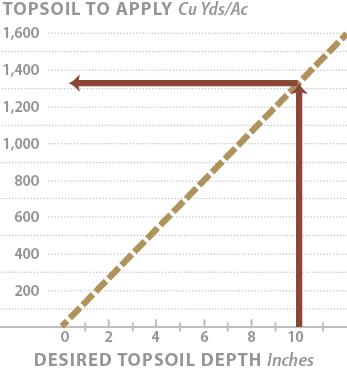
Figure 5-28 | Determining the soil quantity needed for a specific topsoil depth
The quantity of topsoil to apply to achieve a specified topsoil thickness can be estimated using this graph. For example, to create a topsoil, 10-inches deep, would require 1,350 yd3 of topsoil.
Manufactured Topsoil
The term manufactured topsoil (also referred to as "engineered topsoil") is used to define a soil created to perform like, or develop into, topsoil. It is usually manufactured offsite and transported to the area where it is applied. Manufactured topsoil is used in gabion walls, crib walls, or other bioengineered structures. It can also be used in planting pockets and planting islands.
Selection of the appropriate organic matter, soil texture, and soil amendments for manufactured topsoil will increase the success of the project. It is critical that manufactured topsoil be similar to the soils of the reference site with characteristics that will support the desired plant community. The basic components of a manufactured topsoil are the loam borrow, compost, and soil amendments.
Loam Borrow—Loam borrow is any material that is composed of mineral particles meeting a suitable texture class (Figure 5-29). Optimal loam borrow is low in coarse fragment content, is weed-free, and meets general soil quality specifications shown in Table 5-8. Testing loam borrow will determine if the material meets these general specifications. Loam borrow can come from many sources, such as subsoils, river sands, and terrace deposits. When loam borrow comes from subsoils or parent material, it can be assumed that beneficial soil microorganisms, like mycorrhizae and nitrogen-fixing bacteria are not present. These microorganisms can be added to the loam borrow using inoculums (Section 5.2.7).
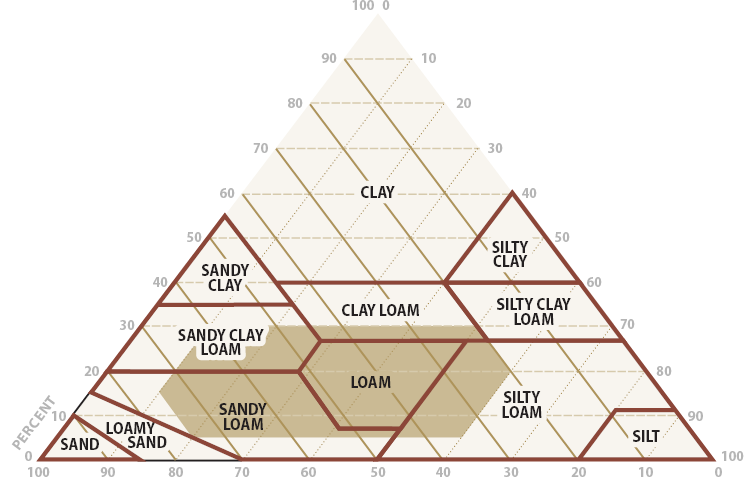
Figure 5-29 | Soil textures suitable as loam barrow
Soil textures that are suitable as "loam borrow" are shown in light brown on the USDA textural triangle.
Compost—The organic component of manufactured topsoil (Section 5.2.5) is composted materials from of a variety of materials, including yard waste materials (grass clippings, leaves, and shredded wood of trees and shrubs), sawdust, and biosolids. The heat generated during composting effectively reduces pathogens, weeds, and insects that may be hazardous to humans and detrimental to the reestablishment of vegetation. To reduce the potential for spreading weeds, compost specifications call for material that is free of weed seeds and vegetative material that may propagate weedy plants (e.g., blackberry canes). Specifications also call for well-composted, or stable, which can be indirectly determined by a respirometry test or calculated using C:N ratios obtained from laboratory testing of nitrogen and organic matter. A stable compost will have a low respirometry rate (<8 mg CO2-C per g organic matter per day) and low C:N (<25:1). A bioassay test that compares the rate of seedling emergence and seeds sown in compost to seeds sown in a control growing medium would be useful. Table 5-9 lists the laboratory tests for determining the optimum composts to use in manufactured topsoils.
Table 5-8 | General specification ranges for loam borrow used in manufactured topsoil
This table outlines the general specifications for loam borrow used in manufactured topsoil. It can be adapted depending on the soil characteristics of the compost and other soil amendments that will be used in the composition of the manufactured topsoil (modified after Alexander 2003b; CCREF and USCC 2006).
Test parameters |
Test methods |
Loam borrow |
Physical contaminates (man-made inerts) |
Man-made inert removal and classification (TMECC 0.308-C) |
<1% |
Trace contaminants |
Arsenic, Cadmium, Copper, Mercury, Manganese, Molybdenum, Nickel, Lead (TMECC 04.06) |
Meets US EPA, 40 CFR 503 Regulations |
pH |
1:5 slurry pH (TMECC 04.11-A) |
5.0-7.5 |
Soluble salts |
Electrical conductivity using 1:5 slurry method (dS/m) |
<5 |
Biossay |
Percent seedling emergence and relative seedling vigor (TMECC 05.05-A) |
>80% of control |
C:N ratio |
(TMECC 05.02-A) |
<25 |
To ensure the delivery of high quality organic materials, compost can be obtained from a facility that participates in the Seal of Testing Assurance (STA) program (Inset 5-6). Upon request, these compost facilities send the latest lab results of the material of interest. If compost is from a STA composting facility is not available, other sources can be considered but testing the quality of the compost will be the responsibility of the designer. Compost testing by the designer involves sampling the compost piles and sending the samples to an STA lab ( listing can be found at the Composting Council's website).
At the same time that compost piles are tested, they can also be visually inspected to ensure that noxious weeds are not present on or near the composting facility.
The compost application rates typically range from 10 to 30 percent by volume of the loam borrow. Section 5.2.5 describes how to determine specific organic matter rates.
Soil Amendments—Soil amendments, such as fertilizers, lime, and beneficial microorganisms, can be applied to the compost and loam borrow to bring the manufactured soil into acceptable ranges for pH, nutrients, and microbiological parameters. The type and amount of amendments to apply can be determined by conducting a lab analysis on a sample of the manufactured topsoil (e.g. the combination of loam borrow and compost at the specified mixing ratio). From the results of the soil analysis, a determination can be made for the application rates for fertilizers (Section 5.2.1), lime amendments (Section 5.2.6), and beneficial soil microorganisms (Section 5.2.7).
Table 5-9 | General specification ranges for composted materials for composted materials in manufactured topsoil
These generalized specifications for composts to use in manufactured topsoil can be adapted depending on the soil characteristics of the loam borrow and site conditions
Modified after Alexander 2003b; CCREF and USCC 2006
Test parameters |
Test methods |
Composted Material |
Physical contaminates (man-made inerts) |
Man-made inert removal and classification (TMECC 0.308-C) |
<1% |
Trace contaminants |
Arsenic, Cadmium, Copper, Mercury, Manganese, Molybdenum, Nickel, Lead (TMECC 04.06) |
Meets US EPA, 40 CFR 503 Regulations |
pH |
1:5 slurry pH (TMECC 04.11-A) |
5.0-8.5 |
Soluble salts |
Electrical conductivity using 1:5 slurry method (dS/m) |
<5 |
Biossay |
Percent seedling emergence and relative seedling vigor (TMECC 05.05-A) |
>80% of control |
% Moisture content |
Percent wet weight (TMECC 03.09-A) |
30-60 |
Total organic matter |
Percent by dry weight, loss on ignition (TMECC 05.07-A) |
25 to 60% |
Stability |
Respirometry. Carbon dioxide evolution rate — mg CO2-C per g OM per day (TMECC 05.088) |
<8 |
C:N ratio |
(TMECC 05.02-A) |
<25 |
Particle size |
Percent of compost by dry weight passing a selected mesh size, dry weight (TMECC 02.12- B) |
|
Large quantities of manufactured topsoil can be mixed in a staging area. Using the bucket of a front-end loader or excavator, the compost and loam borrow can be measured out proportionately. For example, using a 5 yd3 bucket, manufactured topsoil with a ratio of 25 percent compost and 75 percent loam borrow would have one scoop of compost applied to three scoops of loam borrow to produce 20 yd3 of material. Additional amendments, such as fertilizers or lime materials, would be applied based on calculations for a 20 yd3 pile. Once all the materials have been placed in the pile, it is thoroughly mixed using the front-end loader.
Purchasing loam borrow, compost, and topsoil requires a set of contract specifications that ensure product quality. The specifications in Table 5-8 and Table 5-9 were developed for the U.S. Department of Transportation by the Composting Council Research and Education Foundation (Alexander 1993b). The tests are based on the Test Method for the Examination of Composting and Compost (TMECC) protocols. These are general quality guidelines and can be broadened or made more constraining depending on the specifics of the project. When considering purchasing these products, it is important to request the latest lab analysis. An STA facility (Inset 5-6) will have these reports available while others might not. It is important that these tests be run by STA laboratories and that the sources be visited to determine whether there are undesirable or noxious weeds on or near the piles.
Inset 5-6 | The Seal of Testing Assurance Program
Just as many products at the local market have seals of approval (e.g., "Approved by the FDA" or "USDA Inspected"), the United States Composting Council operates an approval system for composting facilities. The Seal of Testing Assurance (STA) is a voluntary program that requires compost manufacturers to regularly test their composts using an approved third-party testing facility. The procedures for sampling and testing are outlined in the Test Methods for the Examination of Composting and Compost (TMECC) protocols. The STA program ensures that the company is reputable. Compost can be purchased from companies that do not participate in the STA program but this leaves the sampling and testing up to the buyer. This may involve visiting the composting site, collecting samples from the compost piles, sending them to a qualified lab to run TMECC tests, and interpreting the results when they are returned (www.compostingcouncil.org) (after Alexander 2003).
5.2.5 Organic Matter Amendments
Background
High-quality topsoil is not always available in the quantities needed to meet the objectives of a revegetation project. In such cases, infertile subsoils can be augmented by the incorporation of organic matter amendments. This practice can be an important tool to begin the process of rebuilding a soil and reestablishing native vegetation.
One immediate effect of incorporating organic matter into infertile subsoils is increased infiltration. Water that would typically run off the soil surface during rainstorms now enters the soil. Amended subsoils also have greater permeability and often increased water storage. Changes in these factors can improve the overall hydrology of the site, making soil less susceptible to runoff and erosion.
Incorporation of organic matter can often improve plant establishment and growth rates, especially if composted organic matter is used. Composted organic materials increase soil nutrients and rooting depth, which can create better growing conditions for native plant establishment. The use of non-composted organic materials, such as shredded wood, can restrict plant growth for the first several years after incorporation because of the immobilization of nitrogen. Nevertheless, non-composted materials may be important to consider when composted sources are not available or too expensive, and there is readily available sources of material from clearing and grubbing of trees and shrubs. This material will have an immediate improved effect on infiltration and permeability, as well as speeding the long-term rehabilitation of the soil.
Incorporated organic matter becomes the primary source of energy for soil organisms and, whether fresh or composted, is the driving force behind soil development. In the process of decomposition, soil organisms turn cellulose into complex organic compounds while slowly releasing nutrients for plant growth. Some of the resulting compounds act similarly to glues, sticking soil particles together into aggregates, which ultimately create soil structure. The slow decomposition of organic matter delivers a steady supply of nutrients to the establishing plant community for many years.
The strategy behind many current revegetation projects is to obtain immediate cover with the use of seeds, fertilizers, and other amendments without considering what is needed for long-term site recovery. It is not uncommon to find good establishment of vegetative cover immediately (within a year) after revegetation work, but several years later find that it was not sustainable. Life expectancy of many revegetation projects has often been found to be very short (Claassen and Hogan 1998). Incorporating organic matter takes a different approach. This strategy puts more emphasis on the development of the soils and less on the quick establishment of vegetation. It is based on the premise that creating healthy, functioning soils is the first step in reestablishing native vegetation. This cannot happen without basic minimum soil components, such as an organic source, nutrients, and good soil porosity. When these components are in place, a site can develop into a sustainable plant community. Incorporating organic matter into the soils of highly disturbed sites is an important component of meeting long-range revegetation objectives.
Set Objectives
Section 5.2.3 described the use of organic matter as a mulch for covering seeds. When used as mulch, organic matter protects the soil surface from erosion, enhances seed germination, and with time, breaks down and improves surface soil properties. Applying organic matter on the soil surface may be far easier and more practical than incorporating it into the soil, however, the incorporation of organic matter into the soil offers the following additional advantages:
- Improves soils of "difficult" subsoils or parent materials
- Increases water-holding capacity
- Improves rooting depth
- Improves infiltration and drainage
- Encourages quicker release and availability of nutrients and carbon
Setting objectives clarifies why this mitigating measure is being considered and helps define the appropriate sources and application rates for incorporated organic matter.
Improving "Difficult" Parent Material—The parent material from which soils are derived often plays an important role in how soils will respond to disturbances. Soils originating from granitic rock respond poorly to the removal of topsoil. Subsoils from this parent material have very high bulk densities and low permeability rates. They can "hardset" when dry, restricting root growth and increasing runoff (Claassen and Zasoski 1998). Any positive effects of deep tillage are often short-lived on granitic subsoils (Luce 1997) because they quickly return to high bulk densities and soil strengths. Granitic soils can benefit from the incorporation of organic matter, not only because of increased nutrients, but because the soil's physical properties are improved. Organic amendments lower bulk densities and help to form pathways for water entry, soil drainage, and root growth. Organic matter can also increase the water-holding capacity of these soils.
Soils derived from serpentine rock have also been identified as difficult to revegetate because of heavy metals, low water-holding capacity, low nutrient levels, and a low calcium-to-magnesium ratio. When disturbed, these sites can take decades to revegetate, producing a continual output of sediments. In addition to using plant materials collected from similar serpentines sites, incorporating compost into serpentine soils can greatly improve revegetation success by increasing water-holding capacity (Curtis and Claassen 2005).
Increasing Water-Holding Capacity—The incorporation of organic matter can increase the water-holding capacity of soils with less than 9 percent available water capacity (Claassen 2006). These include soils with sand, loamy sand, and some sandy loam textures, as well as soils high in rock fragments. Incorporating organic matter to increase water-holding capacity can be critical on arid or semi-arid sites, or sites with very little summer rainfall. The increase in moisture-holding capacity depends on the type of organic matter and the degree of decomposition. Non-decomposed (fresh) organic sources, such as large wood chips, can decrease soil water-holding capacity because they act similarly to gravels and hold very little water. A test for determining how much soil moisture will be increased or decreased by the incorporation of organic matter is described in the Native Revegetation Resource Library. The results from this test will help determine the source and quantity of organic matter to incorporate. If there is no increase in percent soil moisture with the additions of organic matter over the soil with no organic matter additions, it means that in the short term, applying organic matter will not improve water-holding capacity. For a more accurate assessment, contact analytical laboratories that perform soil moisture tests.
Improving Rooting Depth—For species that have deep rooting requirements, such as trees, shrubs, and some wildflowers, incorporating organic matter into the subsoil can increase rooting depth. This can be beneficial for plant establishment and long-term site recovery, especially when applied to soils derived from "difficult" parent materials. Soils that are compacted can also benefit from deep incorporation of organic matter. The incorporation of organic matter to deeper levels is often accomplished by applying a thick layer of organic matter to the surface and then incorporating it to the desired depths with an excavator or methods discussed in Section 5.2.2. It is important that the organic matter is thoroughly mixed through the soil profile during incorporation.
Improving Infiltration and Drainage—The hydrology of most disturbed soils is improved with organic matter incorporation. The degree to which infiltration and permeability are improved depends on the size and shape of the organic source and application rates (as described in the following sections). Finer-textured soils (e.g., clays, clay loams, silty clay loams, sandy clay loams) will have better infiltration and permeability when organic matter is uniformly incorporated into the surface of the soil. This objective is important in areas where water quality issues are high.
Improving Nutrients and Carbon—Incorporating organic matter into the soil can ensure that nutrients and carbon are available to decomposing soil microorganisms, which are essential for rebuilding a healthy soil. This objective is important for highly disturbed soils low in nutrients and carbon (e.g., sites lacking topsoil).
Select Organic Materials
There is a range of organic material sources that are available. Developing a selection criteria based on the following characteristics can be helpful:
- Source of organic matter
- Level of decomposition
- C:N ratio
- Size and shape of material
Recognizing how these characteristics will help achieve the objectives for incorporating organic matter will guide the designer in making the appropriate decision for each project.
Organic Sources—Most available organic sources originate from waste byproducts of agriculture, forestry, and landscape maintenance. They include yard & household waste (lawn clippings, leaves, food waste), wood residues (sawdust, bark, branches, needles, roots, and boles of trees and shrubs from landscape maintenance, land clearing, logging operations, or mills), manures (poultry or cattle), agricultural waste products (fruits and vegetables), and biosolids (treated sewage sludge meeting U.S. Environmental Protection Agency regulations). In the composting process, usually more than one source is used. A compost from one facility could include lawn clippings, leaves, yard waste, poultry manure, and shredded wood, while another facility could use yard waste, shredded wood, and biosolids.
Each organic source has a unique nutrient composition. Green alfalfa, for example, has a very different nutrient makeup than organic matter derived from wood residues of cleared right- of-way. Even within sources, there are very different nutrient compositions (Figure 5-30). For example, most of the nutrients of trees are concentrated in the foliage and branches, and very little in the bole of the tree. A chipped slash pile composed of higher proportions of branches and foliage will contain a greater level of nutrients than a pile composed primarily of tree boles and, as such, would probably be a more preferred organic source.
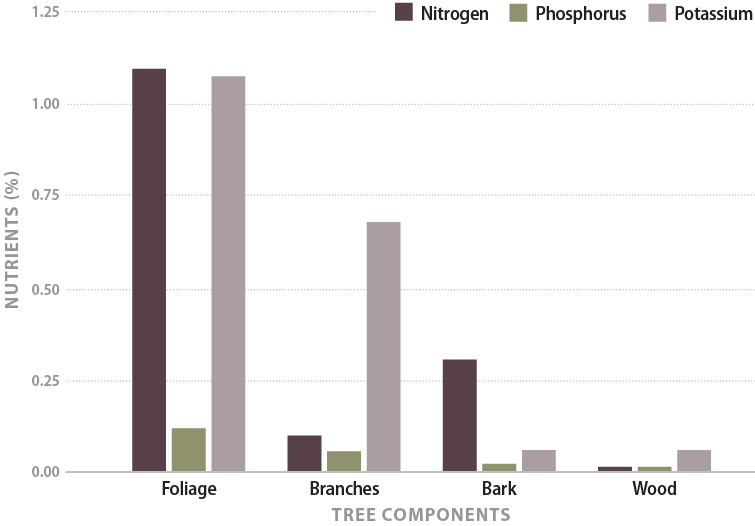
Figure 5-30 | Nutrients in forest biomass
Nutrients are held in different portions of the forest biomass, as shown for old growth Pacific silver fir. On a percentage basis, tree foliage is the storehouse for nutrients. Mulch derived from branches and foliage will have a greater nutrient content than mulch from bark and wood.
Adapted from Cole and Johnson 1981
As organic sources decompose, they contribute their nutrients to the fertility of the soil. Knowing the source from which the organic matter was derived will give some indication of the amount of nutrients that might be supplied to the soil. This information is important to determine whether target long-term nutrient levels will be achieved.
Knowing the source of the organic matter might also identify contaminants that could be harmful to plant growth. Additions of materials, such as fly ash, feedlot, and municipal and factory waste products, could decrease the quality of an organic source. Testing these materials for contaminants, pH, soluble salts, and bioassay will identify potential problems.
Level of Decomposition—Organic matter can be in various stages of decomposition, from fresh organic matter with minimal decomposition to compost that has undergone extensive decomposition. The level of decomposition is an important consideration when selecting an organic amendment. Additions of relatively undecomposed organic matter to the soil can have negative short-term effects on plant establishment and growth.
Fresh Organic Matter—Organic matter is recently ground or chipped material that has undergone very little decomposition is considered "fresh organic matter." These materials usually have very high C:N ratios and will immobilize soil nitrogen for months to several years after incorporation, depending on the characteristics of the organic source. Very slow establishment of plants can be expected when incorporating fresh organic matter unless a continuous source of supplemental nitrogen is applied (e.g., applications of slow release fertilizers, establishing nitrogen fixing plants). Nevertheless, applying fresh organic matter to highly disturbed soils can have a positive effect on slope hydrology and surface erosion. Fresh organic matter can increase infiltration and permeability in poorly structured soils by creating pathways for water flow.
Incorporating fresh organic matter is not generally practiced in roadside revegetation projects. However, considering the expense of purchasing and transporting composted materials to remote sites, as well as the availability and abundance of road right-of-way material that is typically burned for disposal, this is an option that may be worth considering (Inset 5-7). If shredded or chipped road right-of- way material is to be incorporated into the soil, it is best to allow it to age as long as possible in piles. Moving the piles several times to add oxygen will increase the rate of decomposition.
Inset 5-7 | Highway 35
The Oregon State Highway 35 road was frequently affected by high intensity storm events that eroded portions of the roadsides and added sediment into the tributaries of Hood River. A road project was implemented in 2011 and 2012 to reconstruct portions of the highway and improve the hydrology of the roadsides to withstand road surface runoff. Shredded wood was applied at an average depth of 6 in and mixed into the soil approximately 18 to 24 inches deep. The purpose of incorporating shredded wood was to create pathways for water to flow through the soil and thereby increase infiltration and soil drainage. The slopes with shredded wood responded favorably to extreme surface runoff events (A). Runoff from a non-paved road moved quickly into the soil depositing road sediments over the surface of the fill slope. On slopes that were not amended, runoff was not absorb into the soil and gullies were created, moving road and gully sediments off the project site (B). High rates of slow release fertilizers were applied to offset nitrogen tie-up due to the high C:N ratio shredded wood.
Photo credit: David Steinfeld
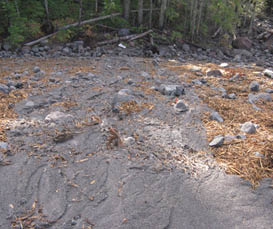
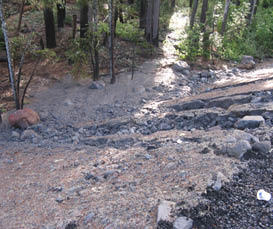
Aged Organic Matter—Some sources of organic matter have been stored in piles for long periods and are partially decomposed. They are darker in appearance than fresh sources, but the appearance of the original organic source can still be discerned (e.g., needles or leaves are still identifiable). These materials are sometimes referred to as "aged organic matter." Because only partial decomposition has occurred, the C:N ratio is lower than with fresh organic matter. Nitrogen immobilization, however, will still occur for a significant period after incorporation. Aged organic sources have not typically undergone extensive heating, like composts, and they can contain seeds of undesirable weeds.
Composted Organic Matter—Compost is the result of controlled biological decomposition of organic material. During the early stages of composting, heat is generated at temperatures that are lethal to weed seeds, insects, and pathogens (Inset 5-8). Fresh, moist compost piles will usually generate heat in the first few days of composting, reaching 140 to 160 ° F, which will kill most pathogens and weed seeds (Epstein 1997; Daugovish and others 2006). The resulting material is a relatively stable, sanitized product that is dark brown to black and beneficial to plant growth (Alexander 2003a, 2003b). Composts are very suitable materials for increasing the water-holding capacity of sandy soils, increasing nutrient supply, and enhancing soil infiltration and permeability rates.
Inset 5-8 | Compost production
The production and use of compost in the United States has flourished as a result of a ban in many of states on yard wastes in landfills. Since 1988, the number of yard waste composting facilities in the United States has expanded from less than 1,000 in 1988 to more than 3,500 in 1994. With the formation of the Composting Council in 1989, research in compost manufacturing has increased significantly.
Composting is the biological decomposition of organic matter under controlled aerobic conditions. To start the composting process, there should be organic matter, water, microorganisms, and oxygen (Image A in the illustration below). Heat is also needed but is created by the microorganisms as they proliferate. Temperatures exceed levels that kill most pathogens and weed species (Image B).
With time, in a controlled composting environment, microorganisms release carbon dioxide and water from the organic matter. The rate at which these are released, and ultimately the composting time, is a function of the type of material being composted and the composting method.
A variety of composting methods have been developed. State- of-the-art facilities and equipment that control and monitor oxygen, moisture, carbon dioxide, and temperature levels throughout the composting process produce relatively uniform products. The picture shown in Image C is of a composting system that pumps oxygen through a pipe centered in the wrapped piles of compost. Temperature and carbon dioxide are controlled through a venting system (adapted from Epstein 1997).
Photo credit: David Steinfeld
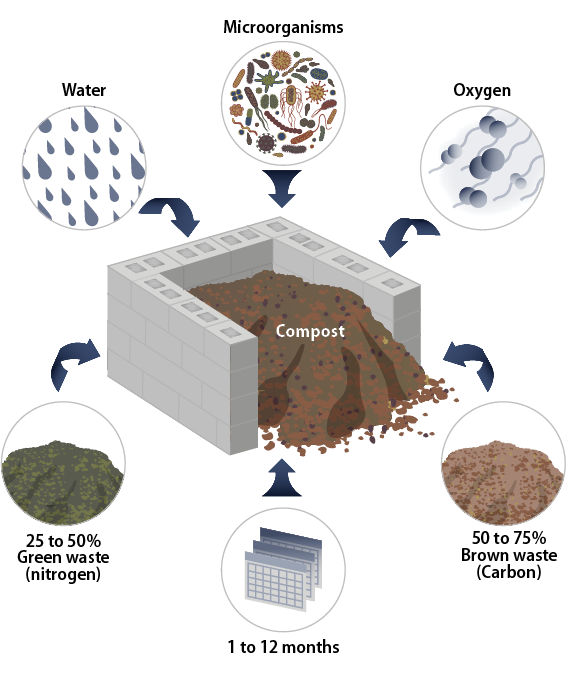
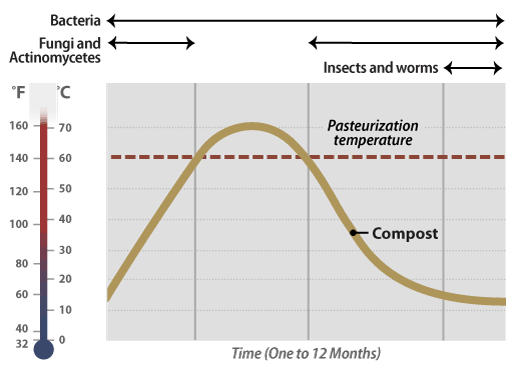
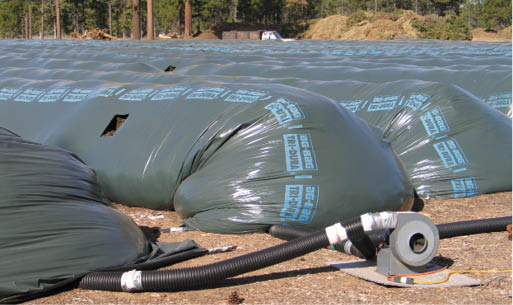
Biochar and Black Carbon—Biochar is a carbon-based material, produced from biomass (e.g. wood chips and plant residues) in a low oxygen, high temperature environment in a process called pyrolysis. It is a type of "black carbon" — a continuum of charred residues that includes char, charcoal, bone char, carbon ash, carbon black, black carbon, carbonized carbon, coke, and soot — produced for the specific purpose of sequestering carbon (Spokas and others 2012). Biochar is very resistant to decomposition and lasts for hundreds of years in the soil, as compared to uncharred biomass which breaks down in decades returning carbon to the atmosphere. It's high porosity and large surface area makes it very absorbent to nutrients, metals, and water and for this reason is of interest in roadside management as a soil amendment for plant growth and removing contaminates from road runoff. Biochar can be used on roadsides for (1) sequestering carbon, (2) improving soil characteristics, and (3) enhancing water quality.
Applying biochar to roadsides for carbon sequestration has been limited because of the high costs and availability of the material. Other methods of sequestering carbon on roadsides are more cost effective such as mowing grasses less frequently, converting introduced annual grass and forb vegetation to perennial species, maintaining forested areas, using vegetation in lieu of traditional engineering solutions (e.g. living snow fences, slope stabilization), and converting open areas to shrub and forested species (FHWA 2010).
Depending on the soil type, incorporating biochar may immediately affect soil nutrition, water retention, or microbial activity which may improve soil productivity. In reviewing the literature, Spokas and others (2012) found that biomass yields increased in half of the studies where biochar or black carbon was added to the soil but either decreased or showed no significant differences in the other half. The reasons for conflicting study results are likely due to the variety of biochars used in these studies. Biochar properties range widely depending on type of material used (feedstock), temperatures (pyrolosis conditions), and how the biochar was stored. Differences in study findings may also be due to the soil type. Of the studies with positive results, a greater number of these studies were conducted on either weathered or degraded soils with limited soil fertility, similar to roadside conditions.
The large surface area and cation exchange capacity of biochars may immobilize plant nutrients, decreasing soil productivity and restricting plant growth. Combining biochar with compost, manure, fertilizer, and other amendments may mitigate these effects and be a good method for using biochar in soil remediation (Beesley and others 2011). It is important to understand the effects of applying biochar to a roadside project through trials or administrative studies. Applying biochar to roadsides for soil improvement has been done on a limited scale and research is needed to understand its value in improving these sites.
Biochar has the potential to be an effective sorbent for organic and inorganic contaminants in soil and water (Ahmad and others 2013). Used in storm water design, it holds promise in removing heavy metals and other road pollutants from road runoff, including brake lining dust, leaded gas, antifreeze, and herbicides. Mixed into the soil where road runoff concentrates (e.g. road shoulders, amended ditchlines, filter strips, bioretention swales, constructed wetlands) biochars may capture contaminants before they enter live drainages. Mixing 4 percent biochar into a roadside filter strip, Brown (2016) greater infiltration rates, lower runoff levels, increase in soil moisture content nitrate reduction.
The origin of biochar may be critical in the type of contaminant being absorbed. Biochars produced under high temperatures have higher surface area and are more effective in capturing organic contaminants while lower temperature biochars are more suitable for removing inorganic contaminants such as metals (Ahmad and others 2013). The same absorptive characteristics that make biochars good for water quality may also capture nutrients important for plant growth. For this reason, if biochars are being used in road runoff structures, it is important to consider its impacts on plant growth. As stated above, using composts, manures, shredded wood, fertilizers, and other amendments with biochar, may increase soil productivity and plant growth. Laboratory or field testing of biochar with soil amendments prior to use on projects will identify the effectiveness of these mixes in removing road contaminants.
Carbon-to-Nitrogen Ratio—The C:N ratio is one of the most important characteristics to consider when selecting a source of organic matter. It is an indicator of whether nitrogen will be limiting or surplus (Section 3.8.4, see Soil Nitrogen and Carbon). The higher the C:N ratio, the greater the likelihood that nitrogen will be unavailable for plant uptake. When an organic source with a high C:N ratio is incorporated into the soil, carbon becomes available as an energy source for decomposing soil organisms. Soil microorganisms need available nitrogen to utilize the carbon source. Not only do microorganisms compete with plants for nitrogen, they store it in their cell walls, making it unavailable for plant growth for long periods. As the carbon sources become depleted, the high populations of soil microorganisms die and nitrogen is released for plant growth (Figure 3-40).
Table 5-10 | C:N ratios for common sources of organic matter
From Rose and Boyer 1995-; Epstein 1997; Claassen and Carey 2004; Claassen 2006
Materials |
C:N ratio |
Wood: Ponderosa pine and Douglas-fir |
1,200:1 to 1,300:1 |
Bark: Ponderosa pine and Douglas-fir |
400:1 to 500:1 |
Wood: Red alder |
377:1 |
Paper |
170:1 |
Pine needles |
110:1 |
Wheat straw |
80:1 |
Bark: Red alder |
71:1 |
Dry leaves |
60:1 |
Dry hay |
40:1 |
Leaves |
40:1 to 80:1 |
Yard compost |
25:1 to 30:1 |
Oat straw |
24:1 |
Rotted manure |
20:1 |
Alfalfa hay |
13:1 |
Top soil |
10:1 to 12:1 |
From Rose and Boyer 1995; Epstein 1997; Claassen and Carey 2004; Claassen 2006 |
|
When C:N is greater than 15:1, available nitrogen is immobilized but as ratios dip below 15:1, nitrogen becomes available for plant uptake. Most fresh and aged organic sources have C:N ratios greater than 15:1 (Table 5-10) and will immobilize nitrogen for some period of time when incorporated into the soil. When these same materials are composted, C:N ratios approach or even fall below 15:1 and provide a source of nitrogen to the soil. Co-composts, which are biosolids mixed into the compost, can have ratios between 9:1 and 11:1, indicating they are a ready source of available soil nitrogen. When materials with C:N ratios are below 10:1, they can be considered a fertilizer and labeled accordingly. The period of time that nitrogen remains immobilized in the soil is dependent on several factors:
- Climate—High moisture and warm temperatures are important for accelerating decomposition rates. For example, organic matter will decompose faster in Florida than in the mountains of Idaho.
- Quantity of incorporated organic matter—The more organic matter that is applied, the longer the immobilization. A small amount of incorporated sawdust will immobilize very little nitrogen as compared to several inches of the same material.
- C:N ratio of organic amended soil—The combined C:N ratio of soil and incorporated organic matter gives an indication of how the type and rate of incorporated organic matter will affect the soil C:N ratio. An amended soil with a high C:N ratio will have a longer immobilization period than a soil with a lower C:N ratio.
- Depth of incorporation—The depth to which high C:N materials are mixed into the soil will affect decomposition rates. For example, a layer of high C:N material near the surface of the soil will decompose slower than the same layer mixed to 12 inches deep because there would be less soil to organic matter contact.
- Size and shape of organic matter—The more surface area of the organic source, the faster decomposition will take place. A fine compost will decompose faster than a coarse, screened compost.
- Nitrogen fertilization or fixation—Nitrogen present in the soil or supplied from fertilizers or nitrogen-fixing plants will speed up decomposition rates.
It is difficult to predict how long nitrogen will be immobilized in a soil due to the incorporation of organic matter. The variety of available organic sources, unique soil types, and range of climates in the United States make this difficult. For practical purposes, it can be assumed that without supplemental additions of nitrogen (from fertilizers or nitrogen-fixing plants), the immobilization of nitrogen in soils with high C:N ratios will be in the order of months, if not years. To give some idea of decomposition rates, Claassen and Carey (2004) found that partially composted yard waste with a C:N of 18:1 took over a year for nitrogen to become available under aerobic incubation testing conditions.
A |
Total nitrogen (or other |
10 lbs/yd3 |
From laboratory report; most labs will report out nutrients in lbs/yd3 of material |
B |
Nitrogen deficit |
769 lbs/ac |
Determine from reference sites or minimum thresholds from literature (see Figure 5-2 and Figure 5-3) |
C |
Minimum application rates |
77 yd3/ac |
Volume of compost to apply to the site to meet minimum thresholds |
D |
Minimum application depth |
0.6 in |
Thickness of compost to apply to the site to meet minimum thresholds |
Figure 5-31 | Determining application rates
The following calculations can be used to determine the amount of compost to apply to a site. They are based on laboratory test results of the compost and threshold nitrogen levels obtained from reference sites.
The incorporation of materials with high C:N ratios may be beneficial to long-term soil aeration and water movement because the material will not break down as fast as materials with lower C:N ratios. For example, the incorporation of alfalfa hay (C:N =13:1) will decompose quickly, and the effects on soil structure might be short-lived. Alternatively, pine needles (C:N = 110:1) or shredded Douglas-fir (1,200:1) will be effective for many years. High C:N materials are also a longer-term energy source to soil organisms that help create soil structure (Inset 5-7).
Nitrogen-based fertilizers can be applied to offset the effects of high C:N ratios on soil productivity by making nitrogen available for plant growth. Section 5.2.1 describes fertilizer strategies for reducing the effects of high C:N soils.
Material Size and Shape—The range in sizes and shapes of organic matter plays a role in how quickly organic matter breaks down in the soil. Particles with greater surface area to volume ratios will decompose faster than particles with less surface area to volume under similar environments. Chipped wood, for example, has a low surface area to volume ratio and takes longer to break down than long strands of ground wood or fine screened sawdust, which have greater surfaces areas.
The particle size and shape of the organic source can also be important in slope hydrology by increasing infiltration and permeability rates. Long, shredded wood, for example, can create extended passageways for water movement. If applied at high enough rates, long fibers can overlap, creating continuous pores that will increase drainage. Wood chips applied at the same rates are less likely to form continuous routes for water drainage because of their shape.
Large undecomposed wood can significantly reduce soil water storage due to low water-holding capacity of the material. Incorporating large, undecomposed woody organic matter into soils with low water-holding capacities should be tested first to determine its effect (Section 5.2.5, see Background).
Determine Application Rate
The rates for applying organic matter should be based on the objectives for organic matter incorporation. Each objective described in Section 5.2.5, see Set Objectives will yield different application rates. For example, a project objective to increase permeability would require the addition of 6 inches of compost mixed into 24 inches of soil. This is a far greater quantity than if the objective was to increase nutrient supply, which would require 2 inches of compost added to the top 12 inches of soil.
Determining the rates of organic matter needed to improve nutrient status can follow the process outlined for calculating fertilizer rates in Section 5.2.1, see Develop Nutrient Thresholds and Determine Deficits. If a nutrient, specifically nitrogen, is found to be deficient, the amount of organic material to apply should be determined. A nutrient analysis is necessary to make these determinations. Figure 5-31 provides an example of how to calculate the amount of organic matter to incorporate to meet minimum levels of nitrogen.
When organic matter is used to increase infiltration and permeability for water quality and soil erosion, a rate of 25 percent organic matter (by volume) to 75 percent soil (by volume) has been suggested by several researchers (Claassen 2006). This would require 4 inches of organic matter be incorporated for every 9 inches of soil (Inset 5-7). Actual field trials could be installed prior to construction to measure the effects of soil amendments on infiltration. By incorporating several rates of organic matter on plots in disturbed reference sites near the project, the infiltration rates of each treatment could be determined using rainfall simulation equipment.
If the objective for incorporating organic matter is to increase the soil's available water-holding capacity, the rate of organic matter application should be based on achieving a total available water-holding capacity for the desired vegetation of the project area (setting these targets is described in Section 3.8.2).
Ensure Product Quality
Purchasing compost requires a set of contract specifications that ensure product quality. Table 5-10 is a "model specification" developed for the U.S. Department of Transportation by the Composting Council Research and Education Foundation (Alexander 1993b) for composts used as soil amendments on roadways. The tests are based on the TMECC protocols. These are general quality guidelines and can be broadened or made more constraining depending on the specifics of the project. When considering purchasing compost or any other type of organic matter from a manufacturer, it is important to request the latest lab analysis. An STA facility (Inset 5-6) will have these reports available while others might not. It is important that these tests be run by STA laboratories. It is a good practice to visit the location of the organic sources to determine whether there are undesirable or noxious weeds on or near the piles. If these species are present, materials should not be purchased.
5.2.6 Lime Amendments
Introduction
Agricultural lime is used when soil pH of a disturbed site needs to be raised to improve plant survival and establishment (Section 3.8.4, see Salts). Liming low pH soils improves plant growth by reducing aluminum toxicity, increasing phosphorus and micronutrient availability, favoring symbiotic and non-symbiotic nitrogen fixation, improving soil structure, and enhancing nitrification (Havlin and others 1999).
Set pH Targets
Each plant community has an optimal pH range. Plant communities dominated by conifers, for example, function well between pH 5.0 to 6.5, whereas grass-dominated plant communities in arid climates perform well between pH 6.5 and 8.0. It is important to set a realistic post-construction target pH when considering liming because large quantities of lime materials are needed for even small changes in soil pH. For example, raising the pH of a sandy loam soil from 5.5 to pH 6.5 takes nearly twice the amount of lime necessary to raise it to pH 6.0. A half point pH difference in this case can result in an increase of more than 1,000 lb/ac in application rates.
As described in previous sections, it is important to understand the characteristics of the reference site topsoils and try to recreate these soil conditions after construction. On projects where topsoil is removed and not replaced, it is important to determine the difference between the pH of the reference site topsoil and the post-construction surface soil through soil testing. When the pH of the post-construction surface soil is significantly lower than the reference site topsoil, liming to raise subsoil pH to reference site topsoil levels (target levels) can be beneficial.
Select Liming Materials
There are several types of liming materials commercially available (Table 5-11) and selection of these materials is typically based on costs, reactivity, effects on seed germination, and composition of the material. All liming materials will raise soil pH but not at the same level as pure limestone. To account for this, all commercially available liming materials are rated against pure limestone for neutralizing effects. The rating system is called calcium carbonate equivalent (CCE). Burnt lime (CaO) for example, might have a CCE of 150, which means that it has a 50 percent greater neutralizing capacity than pure limestone and much less of this material needs to be applied to increase pH. A low CCE material, such as slag, might have a CCE of 60, which means that it has 40 percent less neutralizing capacity. Liming materials with high CCE, like Ca(OH)2 (slaked lime, hydrated lime, or builders lime) and CaO (unslaked lime, burnt lime, or quicklime), can be caustic to germinating seeds and, if used, need to be applied several months before sowing to reduce the potential damage to emerging seedlings (Havlin and others 1999).
Table 5-11 | Calcium carbonate equivalents
Liming materials are rated by how well they neutralize the soil using pure limestone as the baseline of 100 percent. The rating system is called calcium carbonate equivalents (CCE). Values for some commercially available products are shown below.
Campbell and others 1980; Havlin and others 1999
Material |
Chemical formula |
CCE |
Slag |
CaSiO3 |
60-90 |
Agricultural limestones |
CaCO3 |
70-90 |
Marl |
CaCO3 |
70-90 |
Pure limestone |
CaCO3 |
100 |
Pure dolomite |
CaMg(CO3)2 |
110 |
Hydrated lime, slaked lime, builders' lime |
Ca(OH)2 |
120-135 |
Burned lime, unslaked lime, quicklime |
CaO |
150-175 |
The particle size of the liming material determines how quickly the pH of a soil will increase. The finer the material, the faster the soil pH will increase. For example, a lime material passing a 100-mesh screen reacts faster and takes less quantity than material passing a 50-mesh screen. Finer lime materials are typically more expensive.
Determine Liming Rates
Determining how much liming material to apply is based on these factors:
- Soil texture—Soil texture plays an important role in lime requirements because the higher the clay content, the more lime that must be added to the soil to raise the pH. A soil with a clay loam texture requires over three times more lime to raise the pH from 5.0 to 6.0 than a sandy soil. This is because finer-textured soils and organic matter have higher CEC (Inset 5-9).
Inset 5-9 | Cation exchange capacity (CEC)
The capacity of a soil to hold positive ions (referred to as bases or cations) is called the cation exchange capacity (CEC). A soil with a high CEC holds greater amount of cations, such as calcium and magnesium, than a soil with a low CEC. For this reason, a high CEC soil requires more liming material to raise it to the same pH level. Cation exchange capacity is directly related to the amount of clay and organic matter present in the soil—the higher the clay or organic matter content, the higher the CEC. Rock fragments have little or no CEC because they are massive in structure. Rates of liming on high coarse fragment soils are reduced proportionally.
- Soil organic matter—Soil organic matter (in humus form) has a high CEC and requires more lime material to raise pH.
- Percentage of rock fragments—Rock fragments have little to no CEC because they are massive and typically unweathered. Rocky soils will require less lime materials to raise pH.
- Depth of liming material—Lime materials are relatively insoluble and only change the pH of the soil around where they were placed. Liming rates are adjusted based on the soil depth to which the lime material is mixed.
- Lime material composition—Each liming material is rated by how well it neutralizes the soil. Less materials with high CCE (Section 5.2.6, see Select Liming Materials) are required as compared to low CCE materials.
- Fineness of liming material—The fineness of the liming material determines how quickly the pH will change. Very fine materials change pH quicker than coarse materials. Therefore, less quantity of finer-grade materials will be required for immediate pH soil change.
For a quick approximation of liming rates, refer to the Excel workbook titled "Calculating Liming Rates Procedure" in the Native Revegetation Resource Library, which is based on the lime application rate curves shown in Figure 5-32. However, for a more accurate assessment of rates, the Shoemaker-McLean-Pratt (SMP) Buffer method is available. This test requires samples of the post-construction surface soils be sent to a soils laboratory. Results are reported in a table that shows the quantity of lime needed to raise the soil sample to pH 7. The information can be graphed and used in a similar fashion to the example in Figure 5-32. The SMP test is well adapted for soils with pH values below 5.8 and containing less than 10 percent organic matter (McLean 1973). The future of the SMP test however, may be short-lived because of the hazardous chemicals that are used and other tests, such as the Sikora Buffer method may be used in its place (Anderson and others 2013).
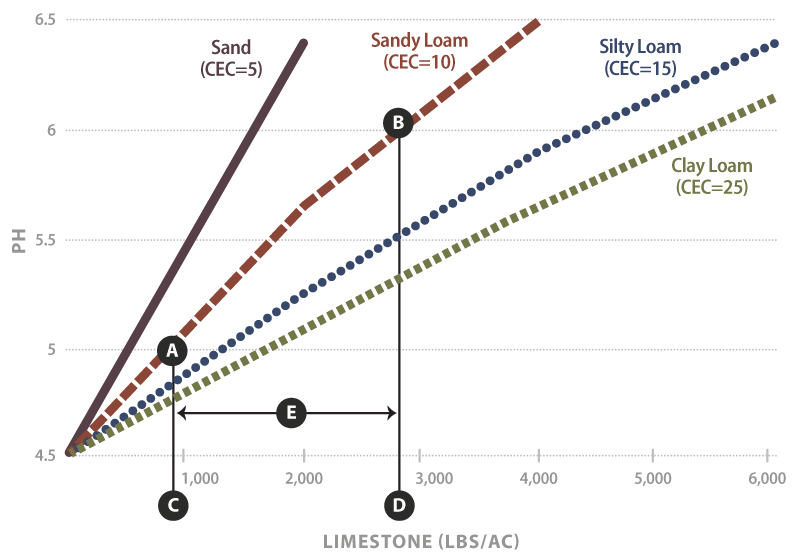
Figure 5-32 | Approximate liming rates for disturbed soils
This chart can be used to approximate the liming application rates for disturbed soils. The chart is based on measuring pH changes of four soil textural classes as limestone is incorporated into the surface 7 inches of soil (chart modified from Havlin and others 1999). For example, a sandy loam soil has an existing pH of 5.0 (A) and a target pH after liming of pH 6.0 (B). The amount of limestone to apply (E) is 1,900 lb/ac, which is calculated by subtracting 900 (C) from 2,800 (D). Refer to the Calculating Liming Rates Procedure workbook for a quick determination of rates and materials. More accurate lab results obtained from the SMP Buffer method for determining lime requirements can be substituted for values obtained in this graph.
Apply Liming Materials
Limestone materials are commonly applied in powder form through fertilizer spreaders or hydroseeding equipment. Pelletized limestone, which is very finely ground material that has been processed into shot-sized particles, is easy to handle and can be used in fertilizer spreaders. Hydroseeding equipment, however, is probably the best method for spreading liming materials, especially very fine liming materials which can be difficult to apply through fertilizer spreaders.
Because liming materials are relatively insoluble in water, surface applications of lime, without some degree of soil mixing, renders the lime ineffective for immediate correction of soil acidity. Several studies have indicated that it can take more than a decade for surface-applied lime (not incorporated) to raise soil pH to a depth of 6 inches (Havlin and others 1999). It is important, therefore, to incorporate liming materials into the soil at the depth where the pH change is desired.
Incorporation can be accomplished on gentle slope gradients using tillage equipment, such as disks and harrows (Section 5.2.2). Liming materials can be mixed on steep slopes using an excavator. However, if equipment is not available for mixing on steep sites, applying very finely ground limestone through hydroseeding equipment is a possible way of raising the surface pH (Havlin and others 1999). This material raises pH faster and depending on the soil type and slope gradient, can increase the pH in the surface 3 or 4 inches of soil over time. The size specifications for very fine lime is 100 percent passing a 100-mesh sieve and 80 percent to 90 percent passing a 200-mesh sieve.
5.2.7 Beneficial Soil Microorganisms
Background
Beneficial microorganisms are naturally occurring bacteria, fungi, and other microbes that play a crucial role in plant productivity and health. Some types of beneficial microorganisms are called "microsymbionts" because they form a symbiotic (mutually beneficial) relationship with plants. In natural ecosystems, the root systems of successful plants have several microbial partnerships that allow them to survive and grow even in harsh conditions (Figure 5-33). Without their microsymbiont partners, plants become stunted and often die. Frequently, these failures are attributed to poor nursery stock or fertilization, when the real problem was the absence of the proper microorganism.
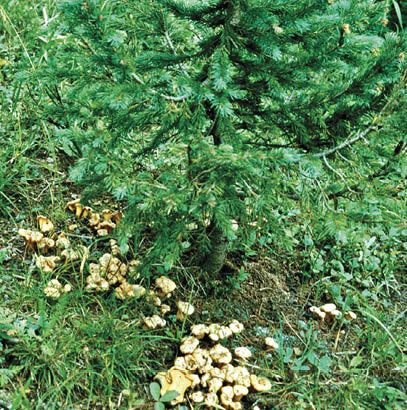
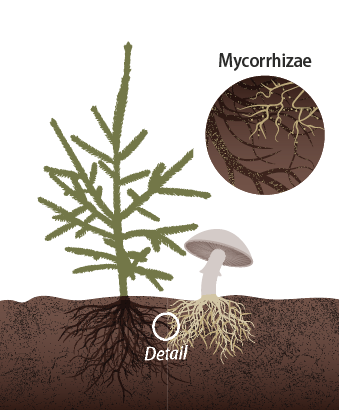
Figure 5-33 | Symbiotic relationships of plants
Many plants rely on symbiotic relationships to survive and grow in nature (A). The mushrooms under this spruce are the fruiting bodies of a beneficial fungus that has formed mycorrhizae on the roots (B).
Photo credit: Thomas D. Landis
As described in Section 5.2.7, see Sources and Application of Arbuscular Mycorrhizal Fungi it is important to consider beneficial microorganisms as part of an overall strategy to conserve existing ecological resources on the site. These strategies include the following:
- Minimizing soil disturbance
- Conserving and reapplying topsoil and organic matter
- Leaving undisturbed islands or pockets on the project site
- Minimizing use of fast-release fertilizers
On projects where soil disturbance will be minimal or where topsoil is still present and contains functional communities of beneficial microorganisms, reintroducing the organisms will usually not be necessary. However, most road projects involve severe disturbances and, therefore, healthy populations of beneficial microorganisms may be depleted or even absent. Soil compaction and removal of topsoil, which is routine during road construction, is particularly detrimental to beneficial soil microorganisms. In addition, beneficial bacteria and fungi do not survive in soil for long periods of time in the absence of their host plants and may be killed during the topsoil storage period. Reintroducing beneficial microorganisms may be an important component in establishing and maintaining native vegetation and in restoring soils.
Appropriate beneficial microorganism can be reintroduced by inoculating seeds and plants with the beneficial microorganism, or introducing the microorganism in the planting hole. Applying inoculum however, does not always result in the colonization of the root system with the beneficial organism. As will be discussed, colonization depends on the quality of the inoculum and the soil environment. Plants with well colonized root systems may establish more quickly and with less water, fertilizer, and weed control, than non-colonized plants, thereby reducing installation costs.
The two most important microsymbionts for revegetation projects are mycorrhizal fungi and nitrogen-fixing bacteria.
What are Mycorrhizae?
Mycorrhizae are one of the most fascinating symbiotic relationships in nature. "Myco" means "fungus" and "rhizae" means "root"; the word "mycorrhizae" means "fungus-roots." The host plant roots provide a convenient substrate for the fungus and also supply food in the form of simple carbohydrates. In exchange for this free "room-and-board," the mycorrhizal fungus offers benefits to the host plant:
Increased Water and Nutrient Uptake—Beneficial fungi help plants absorb mineral nutrients, especially phosphorus and micronutrients such as zinc and copper. Mycorrhizae increase the root surface area, and the fungal hyphae access water and nutrients beyond the roots (Figure 5-34). When plants lack mycorrhizae, they become stunted and sometimes chlorotic (yellow) in appearance (Figure 3-29 and Figure 5-34 B).
Stress and Disease Protection—Mycorrhizal fungi protect the plant host in several ways. With some fungi, the mantle completely covers fragile root tips (Figure 5-34A) and acts as a physical barrier from drying, other pests, and toxic soil contaminants. Other fungal symbionts produce antibiotics that provide chemical protection.
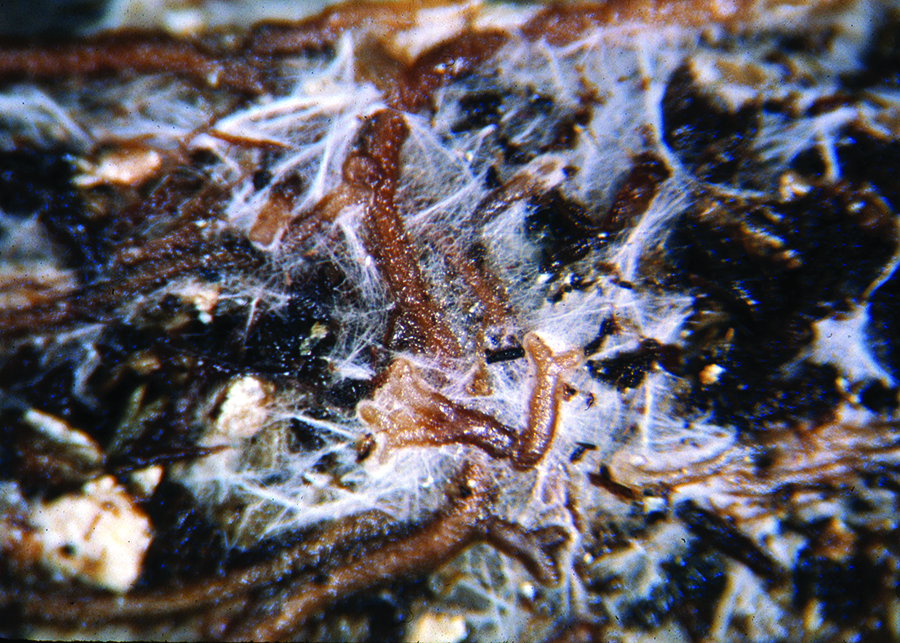

Figure 5-34 | Mycorrhizal fungi benefits host plants
Mycorrhizal fungi offer many benefits to the host plant. The fungal hyphae increase the area of absorption for water and mineral nutrients, whereas fungal mantle covers the root and protects it from desiccation and pathogens (A). Seedlings grown in nurseries soils that are low in mycorrhizae are often stunted as shown in this patchy nursery bed (B).
Photo credit: Thomas D. Landis
Increased Vigor and Growth—Plants with mycorrhizal roots survive and grow better after they are planted on the project site. This effect is often difficult to demonstrate but can sometimes be seen in nurseries where soil fumigation has eliminated mycorrhizal fungi from seedbeds. After emergence, some plants become naturally inoculated by airborne spores and grow much larger and healthier than those that lack the fungal symbiont (Figure 5-34B). Mycorrhizal fungi form partnerships with most plant families, and three types of mycorrhizae are recognized:
- Ectomycorrhizal fungi (ECM) have relatively narrow host ranges and form partnerships with many temperate forest plants, especially pines, oaks, beeches, spruces, and firs.
- Arbuscular mycorrhizal fungi (AMF) are also known as endomycorrhizae or vesicular-arbuscular mycorrhizae. These fungi have wide host ranges and are found on most wild and cultivated grasses and annual crops, most tropical plants, and some temperate tree species including cedars, alders, and maples as well as flowering forbs use by pollinators.
- Ericoid mycorrhizal fungi form partnerships with the Epacridaceae, Empetraceae, and most of the Ericaceae; plants affected include blueberries, cranberries, crowberries, huckleberries, azaleas, rhododendrons, and sedges. Because these mycorrhizal associations involve unique species of fungi, few commercial inoculants are available and the best option is to use soil from around healthy plants.
For restoration purposes, the important thing to remember is that different plant species have specific fungal partners. ECM fungi are generally specific to one genus, whereas AMF fungi can colonize a wide range of genuses. Conserving existing topsoil and organic matter is a key practice to protecting existing populations of beneficial microorganisms. Where disturbed soils are expected, practices may be necessary to reintroduce the key microsymbionts. Applying mycorrhizal inoculants is one option but it must be based on the target host plants and the site condition. Identifying whether the host plant is endomycorrhizal, ectomycorrhizal, ericoid, or non-mycorrhizal is important in selecting inoculum. Conifer seedlings, for example, require very specific ectomycorrhizal fungi for successful inoculation. Endomycorrhizal species, on the other hand, are broad in range and therefore a general mix of several endomycorrhizal species can be used for a broader range of plant species.
Sources and Application of Ectomycorrhizal Fungi
Three common sources of ECM inoculants are soil, spores, or pure culture vegetative inoculum.
Soil—Topsoil, humus, or duff from beneath ECM host plants in or near the project can be used for inoculum if done properly (Figure 5-35 A). Because disturbance and exposure to direct sunlight may kill these beneficial fungi, inoculation using these sources need to be done as quickly as possible. For the best results, small amounts topsoil, humus or duff are collected from several different locations and mixed into the soil prior to planting.
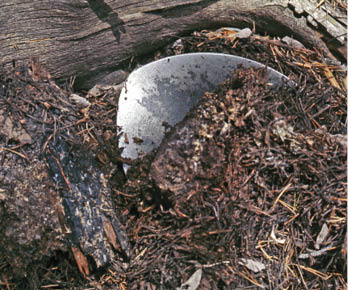
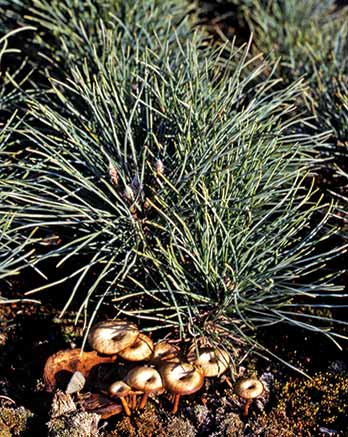
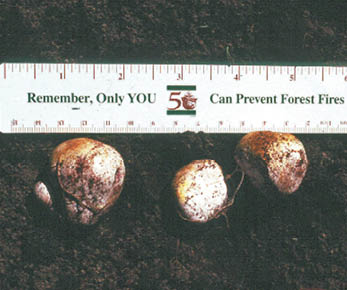
Figure 5-35 | Soil inoculum can be collected in the field
Inoculum can be obtained by collecting topsoil or duff from areas with similar plant species (A) or from the spores of mushrooms (B), puffballs, or truffles (C) collected from around the host plant.
Photo credit: Thomas D. Landis
Spores—Spore suspensions are sometimes available from commercial suppliers. These spores are collected in the field from ripe fruiting bodies like mushrooms and truffles (Figures 5-35 B and C). The quality of commercial sources can be variable so it is important to verify the quality of the inoculum. It is also possible to make inoculum from spores by collecting ripe fruiting bodies of mushrooms, puffballs, or truffles from beneath healthy plants. They are then rinsed and pulverized in a blender for several minutes to make a slurry. Fungal spores do not have a long shelf life and benefit from being refrigerated and applied as soon as possible.
Pure Culture Inoculum—Mycorrhizal fungi are available commercially as pure cultures, usually in a peat-based carrier. Most commercial sources contain several different species of ECM. Because this type of inoculum is made from pure fungal cultures and does not store well, it is rarely available from suppliers.
Application rates and methods for ectomycorrhizal inoculums vary by species. Because these mycorrhizal fungi are very specific to their host species, it is important to work closely with company representatives when using ectomycorrhizal inoculum. Nurseries can inoculate plants with ECM and if this service is desired, it needs to be stated in the seedling-growing contract. However, as stated above, there is no guarantee that the plants that are inoculated with have colonized roots when they are planted at the project site.
Other ectomycorrhizal fungal inoculums are applied at the time of planting with the objective to get the inoculum in contact with the plant roots. Some formulations are mixed with water and the slurry is applied to the roots of nursery stock. However, the effectiveness of many of these applications has not been verified by research under roadside revegetation conditions.
Verifying the Effectiveness of ECM Inoculation—It is fairly easy to recognize ECM with the naked eye on the root system of a seedling. The short feeder roots of the seedling is covered with a cottony-white or a brightly colored mantle or sheath over the roots (Figure 5-36). Unlike pathogenic fungi, mycorrhizae will never show signs of root decay. Sometimes, mushrooms or other fruiting bodies will appear alongside their host plants which is an indicator of the species of mycorrhizae that is present. If mycorrhizae is not visible on the roots systems, plant samples can be sent to a laboratory where they analyzed for inoculation effectiveness.
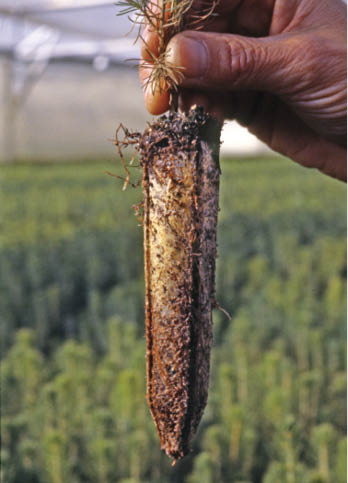
Figure 5-36 | Ectomycorrhizae fungi are visible on roots
Ectomycorrhizae are visible on plant root systems as white or colored structures with a cottony or felt-like texture.
Photo credit: Thomas D. Landis
Sources and Application of Arbuscular Mycorrhizal Fungi
The two main sources of arbuscular mycorrhizal fungi inoculants include "pot culture," (also known as "crude" inoculant), and commercially available pure cultures.
Nursery Pot Culture—With this option a specific AMF is acquired either commercially or from a field site as a starter culture, and then added to a sterile potting medium. A host plant such as corn, sorghum, clover, or an herbaceous native plant is grown in this substrate and as the host grows, the AMF spores multiply (Figure 5-37A). At maturity the shoots of host plants are removed and the substrate, now rich in roots, spores, and mycelium, is processed (Figure 5-37B). The resultant inoculum can be incorporated into growing media or planting beds before seeds are sown. This is a highly effective technique for propagating AMF in the nursery and could also be used on the planting site. For details, refer to Arbuscular Mycorrhizas: Producing and Applying Arbuscular Mycorrhizal Inoculum (Habte and Osorio 2001).
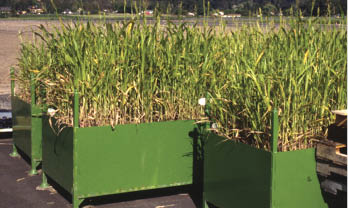
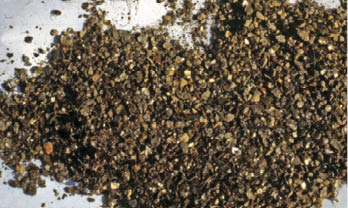
Figure 5-37 | Arbuscular mycorrhizal fungi
Because of their wide host range, AMF fungi can be raised on host plants like sorghum (A) producing spores and colonized roots that can be chopped-up for inoculum (B).
Photo credit: David Steinfeld
Commercial Products—Several brands of commercial AMF inoculants are available and usually contain a mix of several fungal species. Coarser-textured products are incorporated into soil or growing media, and finer-textured products are applied as wetable powders through sprayers or injected into irrigation systems. Inoculation effectiveness has been shown to vary considerably between products, so it is wise to install tests before purchasing large quantities of a specific product. Laboratories can provide a live spore count, which is the best measure of inoculum quality.
Application of AMF Inoculants—AMF inoculums typically come in a granular form with different grades of fineness. Coarse-grade products are mixed in the soil prior to sowing seed. Finer-grade inoculums, which are more expensive, may be mixed with water and applied directly onto seeds or as a root dip. Use of fine-grade inoculum through hydroseeding equipment is another way to combine AMF with seeds as they are sown. There is little research on AMF inoculation effectiveness on roadside revegetation sites.
Verifying the Effectiveness of AMF Inoculation—Unlike ectomycorrhizal fungi, AMF are not visible to the unaided eye. To verify the effectiveness of AMF inoculation, roots are stained and examined under a microscope for the percent of the root system that is colonized by AMF.
Management Considerations for Mycorrhizal Fungi
It may be helpful to work with a specialist to selecting the application rates and appropriate mycorrhizal partners for the plant species and outplanting sites. Some management modifications may be required to promote formation of mycorrhizal partnerships in the field. Fertilization is probably the most significant adjustment. Mycorrhizal fungi extend the plant's root system to extract nutrients and water from the soil. In some cases, fertilizer applications can be reduced by half or more due to the increased nutrient uptake by mycorrhizal fungi. Fertilizer type and form are also important. For instance, high levels of soluble fertilizers may inhibit mycorrhizae. An excessive amount of phosphorus in the fertilizer may inhibit the formation of the partnership; therefore, phosphorus fertilizers should be reduced. If nitrogen is applied, ammonium-N is better used by the plant than nitrate-N (Landis 1989). Controlled-release fertilizers are preferred because they release small doses of nutrients gradually, compared to the more rapid nutrient release from traditional products. Applications of certain herbicides, pesticides, insecticides, fungicides, and nematicides are detrimental to mycorrhizal fungi. See Inset 5-10 for an example of contract specifications for purchasing mycorrhizal inoculum.
Inset 5-10 | Example of contract specifications for purchasing mycorrhizal inoculum
Purchase of Mycorrhizal Inoculum. The mycorrhizal inoculum must have a Statement of Claims that certifies:
- the date inoculum was produced
- mycorrhizal fungi species present in the inoculum
- number of propagules per pound of product, and
- the type and grade of carrier.
Product Specifications. Date of inoculum application will be within one year of production date. The storage, transportation and application temperatures of the mycorrhizae shall not exceed 90 ° F. Inoculum must consist of at least 5 species of (choose endomycorrhizal, ectomycorrhizal or a combination of endo and ectomycorrhizal) fungi with no one species making up more than 25 percent of the propagules.
- The inoculum will contain these species:
.
- The inoculum will contain
live propagules per pound (Typical rates for endomycorrhizal inoculums average around 60,000 to 100,000 propagules per pound and 110,000,000 propagules per pound in ectomycorrhizal inoculums.)
- (For applications to the soil surface only) Live propagules must be smaller than 0.3mm.
- (Optional) A one ounce sample will be collected from each inoculum and sent to
laboratory for analysis using the
standardized test to determine the number of propagules.
Application of Endomycorrhizal Inoculum to Soil Surface
- Endomycorrhizal inoculum will be applied at a rate of
live propagules per acre (typical rates range from 1,000,000 to 3,600,00 live propagules per acre).
- Inoculum will be applied in the same operational period as seed application.
- If inoculum is applied through a hydroseeder, it should be applied within 45- minutes of being mixed in the hydroseeding tank.
Application of Mycorrhizal Fungi to Planting Holes
- Mycorrhizal inoculum will be applied at a rate of
live propagules per seedling.
Nitrogen-Fixing Bacteria
Nitrogen-fixing bacteria live in nodules on plant roots and accumulate (fix) nitrogen from the air and share it with their host plants (Inset 5-11). Unlike mycorrhizal fungi, which are found on most trees and other plants, only certain species of plants form symbiotic partnerships with nitrogen- fixing bacteria.
Inset 5-11 | How does biological nitrogen fixation work?
The symbiotic partnership between plants and their nitrogen-fixing microsymbionts works this way:
Nitrogen fixing bacteria, present in the soil, are attracted to flavonoids secreted from the roots of host plants and invade the root cracks or deformed root hairs. In response, a root nodule appears and an environment for nitrogen bacteria is created. Within the low oxygen environment of each nodule, millions of bacteria convert atmospheric nitrogen to ammonia (NH3) through an enzyme call nitrogenase. This requires a relatively high amount of energy that the plant supplies to the bacteria. In return, the plant receives ammonia, which is converted to amino acids and used to synthesize proteins for plant growth. When the "nitrogen-fixing" plant sheds its leaves, or dies, the nitrogen stored in the plant's tissues is released into the soil and becomes available to other plants. This process, part of the nitrogen cycle, is the major source of nitrogen fertility in most natural ecosystems.
The role of nitrogen-fixing bacteria and their partner plants is important in revegetating roadsides. Because nitrogen-fixing plants are often pioneer species that are the first to colonize disturbed sites, they are ideal for revegetation or restoration projects. These species help restore fertility and organic matter to the project site. Nitrogen-fixing bacteria form nodules on roots of host plants (Figure 5-38A) and accumulate nitrogen from the air (Figure 5-38B). While plants that form this association are sometimes called "nitrogen-fixing plants," the plant itself is not able to fix nitrogen by itself. It is only through the partnership with bacteria that these plants are able to obtain atmospheric nitrogen. In this partnership, the bacteria supply the plants nitrogen, and in exchange, the bacteria is given a place to grow and carbohydrates from the plant for energy. Without these bacterial partnerships, plants are not able to make direct use of atmospheric nitrogen.
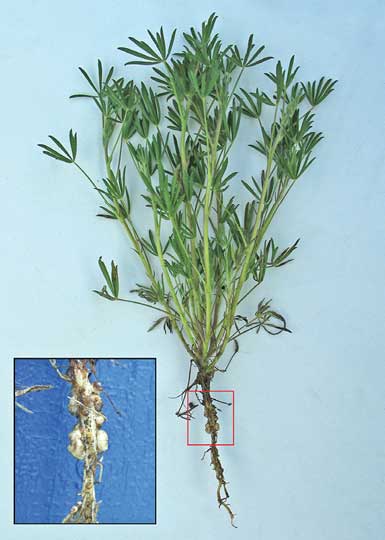
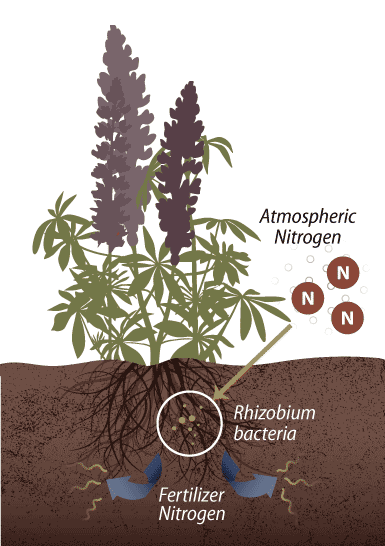
Figure 5-38 | Nitrogen-fixing bacteria
Nitrogen-fixing plants, such as legumes, have symbiotic bacteria residing in nodules (blue inset) on their roots (A) which can chemically "fix" atmospheric nitrogen into forms that can be used by plants as fertilizer (B).
Photo credit: David Steinfeld
Soil on restoration sites, however, may not contain the proper species of bacteria to form a symbiotic partnership with the plant. This is particularly true for compacted subsoils. Inoculating plants ensures that "nitrogen-fixing" plants form an effective partnership to fix nitrogen. Therefore, use of nitrogen-fixing plants can be an important part of accelerating rehabilitation of degraded land.
Two genera of nitrogen-fixing bacteria that are important in revegetation are Rhizobium and Frankia. Rhizobium grow with some members of the legume family (Figure 5-39A and B) and plants of the elm family. They form nodules on the roots and fix nitrogen for the plant. Frankia are a different kind of bacteria. Frankia partner with non-leguminous plants, such as casuarinas, alders, bitterbrush, and buffaloberry (Figure 5-39C and D) and more than 200 different plant species distributed over eight families. The species affected by Frankia are called "actinorhizal" plants (Table 5-12).
Table 5-12 | Nitrogen-fixing bacteria and their plants
Nitrogen- |
Family |
Subfamily |
% Nitrogen fixing plants |
Common plant species |
Rhizobium spp. |
Legume |
Caesalpinioideae |
23 |
Redbud, honeylocust |
Legume |
Mimosoideae |
90 |
Mesquite, acacia |
|
Legume |
Papilionoideae |
97 |
Lupine, milkvetch, black locust, clover |
|
Frankia spp. |
Birch |
Alder, birch |
||
Oleaster |
Silverberry, buffaloberry |
|||
Myrtle |
Myrtle |
|||
Buckthorn |
Cascara, snowbrush, deerbrush |
|||
Rose |
Mountain mahogany, cliffrose, bitterbrush |
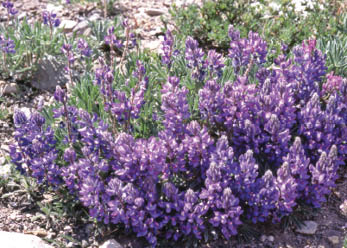
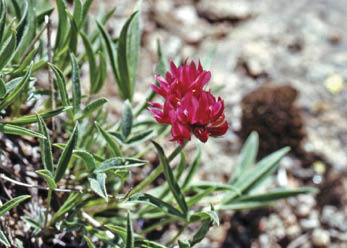
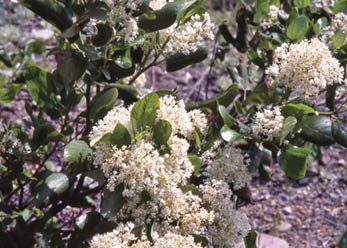
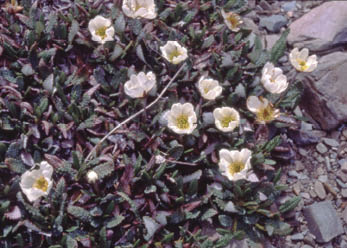
Figure 5-39 | Nitrogen-fixing plants
Nitrogen-fixing bacteria include Rhizobium that forms relationships with plants in the legume family including lupines (A) and clovers (B), and Frankia that forms relationships with other non-leguminous plants such as snowbrush ceanothus (C) and mountain-avens (D).
Photos A, C, and D courtesy of Tara Luna
Uses for Nitrogen-Fixing Plants in Revegetation
Only a fraction of native species are nitrogen-fixing host plants. In the western United States, the most common are the lupines, vetch, bitterbrush, ceanothus, alder, and wax myrtle (Table 5-12). On nitrogen-poor sites, sowing or planting a higher proportion of these species can help a site to recover nitrogen fertility and organic matter (Figure 5-40A). The amount of nitrogen that is produced is related to the area of vegetative cover in nitrogen-fixing host plants, the productivity of the plants, and climate factors such as temperature and moisture. If percent cover of nitrogen-fixing host plants is low, then the amount of nitrogen supplied to the site will be correspondingly low (Figure 5-40B). Likewise, dry or cold conditions tend to result in slower accumulation of nitrogen. While many native and introduced nitrogen-fixing plants are attractive to pollinators, they are also attractive forage for large herbivores.
A plant survey of disturbed and undisturbed reference sites can indicate which nitrogen-fixing plants will do well on a revegetation project. Observing the abundance of root nodules on these plants can provide some indication whether they are fixing nitrogen.
Figure 5-40 | Amount of nitrogen is related to the cover of nitrogen-fixing plants
The accumulation of nitrogen by N-fixating bacteria is directly related to the cover of nitrogen-fixing host plants on a site. The large plants shown in this photograph are N-fixing lupines (A). The nitrogen-fixing potential of a 15-year-old stand of Ceanothus velutinus and Purshia tridentata was directly proportional to plant cover (B) (adapted after Busse 2000).
Photo credit: David Steinfeld
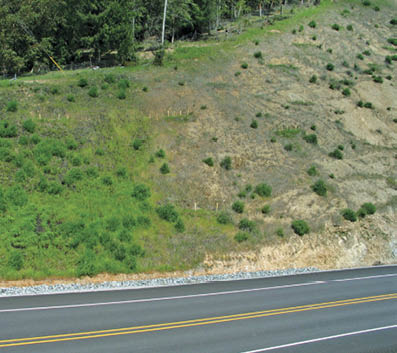
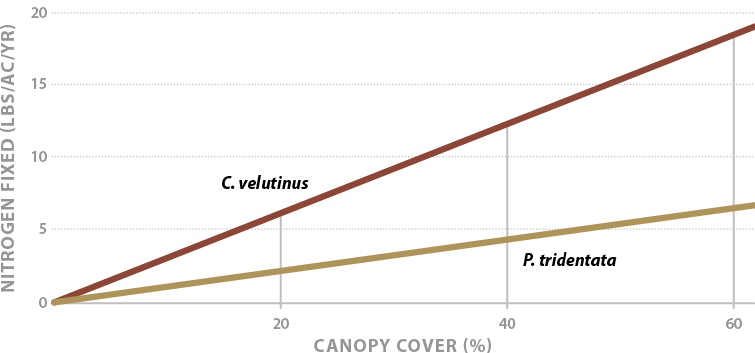
Inoculating with Nitrogen-Fixing Bacteria
Nitrogen-fixing nursery stock with nodulated root systems generally exhibit faster early growth than seedlings than un-nodulated root systems. Nursery inoculation can reduce costs in establishment and maintenance; several dollars' worth of inoculant applied in the nursery is inexpensive compared to applying nitrogen fertilizer. Faster establishment can also lead to greater herbaceous cover that can shade out unwanted vegetation. When nitrogen-fixing plants shed leaves or dies, the nitrogen stored in the plant's tissues is cycled into the soil and eventually taken up by adjacent plants. Early establishment of nitrogen-fixing plants accelerates natural nutrient cycling on disturbed sites and promotes the establishment of sustainable plant communities.
It should be noted that in many cases, uninoculated seedlings may eventually form a partnership with some kind of Frankia or Rhizobium strain after they are outplanted. These may not be with optimal or highly productive bacterial partners, and it may take months or even years on highly disturbed sites. Until they become naturally inoculated, plants are dependent on nitrogen fertilizers and may become out-competed by weeds. Inoculating in the nursery ensures that plants form effective, productive partnerships in a timely fashion.
Acquiring Nitrogen-Fixing Bacterial Inoculants—Nitrogen-fixing bacteria are very specific; in other words, one inoculant cannot be used for all plants and a different inoculant strain for each nitrogen-fixing species is usually necessary. Superior strains can yield significant differences in productivity and growth rate of the host plant—in some cases over 40 percent better growth (Schmit, 2003).
Two forms of inoculant can be used: pure cultured inoculant and homemade (often called "crude") inoculant. Pure cultured inoculant is purchased from commercial suppliers, seed banks, or sometimes, universities. Crude inoculant is made from nodules collected from roots of nitrogen-fixing plants of the same species to be inoculated. Whichever form is used, it is important to handle the inoculants with care because they are very perishable. Storing the inoculants in cool, moist conditions away from light will help maintain their viability.
Pure culture inoculants usually come in small packets of finely ground peat moss (Figure 5-41A). The inoculants are added to chlorine-free water to create a liquid slurry (allowing a bucket of tap water to stand uncovered for 24 hours is a good way to let chlorine evaporate). If a blender is available, using it to blend some inoculant in water is a good practice to ensure the bacteria will be evenly mixed in the solution. If a blender is not available, a mortar can be used. Five to ten grams (about 0.2-0.4 ounce) of manufactured inoculant can inoculate about 500 seedlings, usually exceeding the recommended 100,000 bacteria per seedling. Once seedlings begin to nodulate, nodules from their roots can serve as the basis for making crude inoculant as described below. This way, inoculant need only be purchased once for each plant species grown, and thereafter, crude inoculant can be made from nodules.

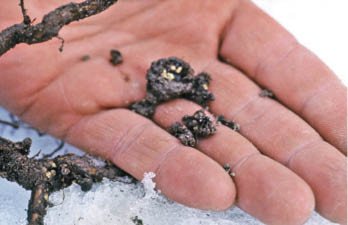
Figure 5-41 | Nitrogen-fixing bacteria are commercially available
Nitrogen-fixing bacteria are commercially available as pure culture inoculant, often in a carrier (A), or can be prepared by collecting nodules from roots of plants in the wild (B).
Photo credit: Tara Luna
Preparing Crude Inoculant—Crude inoculant is made using nodules; each of which can house millions of bacteria. For Rhizobium, observing a brown, pink, or red color inside the nodule is usually a good indicator that the bacteria are actively fixing nitrogen. For Frankia, desirable nodules will be white or yellow inside. Grey or green nodules indicate that the structures are not viable.
To make a crude inoculant, select healthy, vigorous plants of the same species as the plants to be inoculated. If available, choose seedlings that were inoculated with select bacteria. Search for nodules with the proper color and pick them off cleanly. If possible, collect nodules from several plants and place them in containers. As soon as possible after collection (within a few hours), put the nodules in a blender with clean, chlorine-free water. About 50 to 100 nodules blended in a liter of water are enough to inoculate about 500 seedlings. This solution is a homemade liquid inoculant, ready to apply in the same method as cultured inoculant as described below. If they are to be stored, place in refrigerated conditions to maintain viability.
Applying Inoculant—It is important to apply inoculant when seedlings are just emerging, usually within two weeks of sowing. This helps ensure successful nodulation and maximizes the benefits of using inoculants. One liter of liquefied inoculant made from either nodules or cultured inoculant as per the instructions above is diluted in water. For 500 seedlings, about 5 liters of chlorine-free water is used. This solution is then watered into the root system of each seedling using a watering can. In the field, for direct seeding applications, the slurry of commercial or crude inoculant can be added to the hydroseeder tank along with the seed mix.
Management Considerations for Nitrogen-Fixing Inoculations
Verifying the Nitrogen-Fixing Partnership—Allow two to six weeks for indications that seedlings have formed a symbiotic partnership with nitrogen-fixing bacteria. Signs include the following:
- Seedlings begin to grow well and are deep green despite the absence of added nitrogen fertilizer
- The root systems give off a faint but distinctive ammonia-like scent
- Nodules are usually visible on the root system after about four to six weeks Figure 5-40A and Figure 5-42), and nodules are pink, red, or brown (for Rhizobium), or yellow or white (for Frankia)
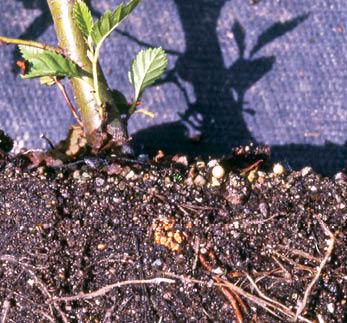
Figure 5-42 | Nitrogen-fixing bacteria will multiply as inoculated plants grow
After successful inoculation, nitrogen-fixing bacteria will multiply on the root system as plants grow. The circle points to a visible Frankia nodule on an alnus seedling.
Photo credit: Tara Luna
Post-Planting Care—Several factors are of primary concern when using inoculants for nitrogen-fixing bacteria:
- Fertilization—The use of nitrogen-fixing bacterial inoculant requires some adjustments in fertilization. Excessive nitrogen fertilizer will inhibit formation of the partnership.
- Water quality—Excessive chlorine in water is detrimental to Rhizobium and Frankia. The water source may need to be tested and a chlorine filter used if excessive chlorine is a problem.
- Micronutrients and soil quality—Some nutrients are necessary to facilitate nodulation, including calcium, potassium, molybdenum, and iron. Excessively compacted soils, extremes of pH or temperature also inhibit nodulation.
Other Beneficial Microorganisms
In nature, communities of bacteria, fungi, algae, protozoa, and other microorganisms in the soil make nutrients available to plants, create channels for water and air, maintain soil structure, and cycle nutrients and organic matter. A healthy population of soil microorganisms can also maintain ecological balance, preventing the onset of major problems from viruses or other pathogens that reside in the soil. The practice of protecting and reestablishing beneficial microorganisms is key for revegetation. As a science, however, the use of beneficial microorganisms is in its infancy. Although thousands of species of microorganisms have been recognized and named, the number of unknown species is estimated to be in the millions. Almost every time microbiologists examine a soil sample, they discover a previously unknown species (Margulis and others 1997). Conserving, maintaining, and creating healthy soils will help to create and sustain the natural populations of beneficial microorganisms.
5.2.8 Topographic Enhancements
Introduction
Topographic enhancements are alterations to the roadside landscape designed to improve the growing environment for plants. Topographic enhancements are important when site resources such as topsoil, organic matter, and water are limited (Section 3.10). It is often better to concentrate limited resources in key areas where resources can be most effective rather than spread them across the larger project area and dilute them to the point of having little benefit to reestablishing native vegetation. An additional benefit of topographic enhancement features is that most are designed to capture water related to road drainage. This improves water quality by reducing peak-flow water to watersheds and capturing sediments.
Topographic enhancement integrates three components into the roadside design: soil improvement, site stability, and water harvesting (Figure 5-43). Soil improvement can occur when limited topsoil and organic matter are strategically used to create growing areas with optimum rooting depth (Section 3.8.2, see Rooting Depth). Stable landforms are created that reduce surface erosion and increase slope stability (Section 3.8.5 and Section 3.8.6). Water harvesting can result when local topography is modified to capture runoff water and concentrate it in areas where it can be used by plants (Section 3.8.1, see Road Drainage) (for background on water harvesting, see Fidelibus and Bainbridge 2006). The integration of these three components will determine the success of a topographic enhancement design.

Figure 5-43 | Topographic enhancement strategies
Optimal topographic enhancement for establishing vegetation occurs when the roadside design includes soil improvement, site stability, and water capture treatments. It is important to consider topographic enhancement strategies early in project design.
Topographic enhancement strategies are considered during the road planning stage and the design of any features are in collaboration with the planning engineer. There are many types of topographic enhancement structures. This discussion is not exhaustive but is rather intended to introduce the designer to a variety of structures that can be installed during road construction to enhance the establishment of native plants.
Planting Pockets and Microcatchments
When terraces are filled with growing media (topsoil or amended subsoil) and planted, they are referred to as planting pockets. Planting pockets are designed to have adequate soil depth and good water holding capacity to store intercepted water and support the establishment of planted seedlings. The surface of the planting pocket is in-sloped to capture water and sediment and the face of the pocket is protected from surface erosion using a mulch (Figure 3-15).
Fill slope microcatchments are structures that capture runoff from outsloped road surfaces and compacted shoulders into terraces and berms where it can be used for plant growth (Figure 3-14). Microcatchments include storage basins and berms. Berms are typically 4- to 8-inch-high obstacles placed on the contour. They are formed from soil, woody debris (logs), or manufactured products such as straw wattles or compost berms. Manufactured products and woody debris are "keyed" (partially buried) into the soil surface to prevent water from eroding under the structure. Compost berms are continuous mounds of compost that can slow water and filter sediments. Seedlings can be planted immediately above berms or obstacles to access captured water. Unless species that propagate vegetatively are used in these structures, it is important to avoid planting where sediment will bury the seedling.
Planting Islands
Planting islands are used where resources, such as topsoil and organic amendments, are limited. They are designed into such revegetation projects as obliterated roads, view corridors, disposal sites, staging areas, and other highly disturbed sites. The strategy behind planting islands is to create areas of ideal growing environment for tree seedlings that replicates the natural topography and tree distribution observed in the surrounding landscape.
Islands can be created by excavating to a depth of several feet and backfilling with either topsoil or compost-amended material (Figure 5-44). Alternatively, compost and other soil amendments (including lime and fertilizers) can be spread over planting islands at the depth needed to amend the soil profile and mixed thoroughly through the soil with an excavator or backhoe. After planting, mulch can be applied across the surface of the entire island. Planting islands will generally occupy less than a quarter to a third of the entire site, leaving the remainder as "inter-island." The inter-islands will be much less productive than the planting islands. Grass and forb plant communities are therefore more suited to these areas (Figure 5-45).
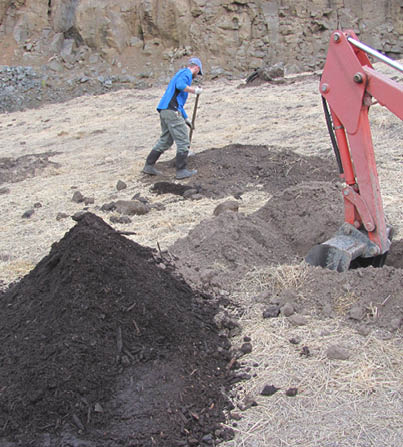
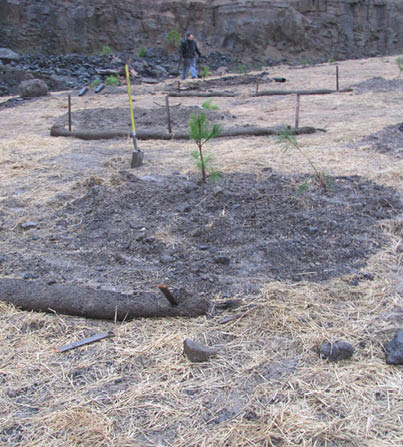
Figure 5-44 | Planting islands focus resources and work in concentrated areas
Planting islands were created on this highly-compacted waste disposal site that lacked topsoil or organic matter. Spaced 15 to 20 feet apart, the planting islands were composed of 5 cu ft of compost/shredded wood mixed to a 2-ft depth using a backhoe (A). Two trees were planted at each island (B). The inter-island was seeded with a native grass and forb mix and covered with straw.
Photo credit: David Steinfeld
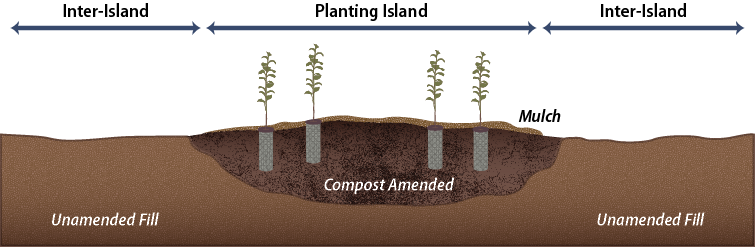
Figure 5-45 | Planting island cross section
Illustration of a typical cross section of a planting island where soil depth is enhanced for tree establishment. Inter-island areas are planted to shrubs and grasses.
Amended Ditches
The purpose of amended ditches is to treat road runoff before it reaches live channels. Amended ditches are designed for areas where there is not enough room along the roadside for vegetated swales but they differ in that they are not terraced, nor as wide. Because of their high infiltration rates, these structures retain more sediment and runoff as compared to typical ditches.
Amended ditches are designed to have high infiltration rates and good water storage capacity. These soil characteristics allow road runoff water, originating from low to moderate rainstorm events, to be absorbed and stored in the soil below the ditch. As rainfall intensities increase, the amended ditches become saturated and convey water. To stabilize the channel surface from downcutting during high rainstorm events, the ditches are designed to support a continuous vegetative cover. The organic matter that is added to the ditches during construction, not only keeps the soils open and supports vegetative cover, has been shown to sequester road pollutants (Grismer and others 2011).
One method of constructing an amended ditch is to place 6 inches by 3 feet layer mixture of shredded wood/compost along the ditchline and incorporating it into the soil to a depth of 18 inches with an excavator (Figure 5-46). The shredded wood/compost mixture is produced by mixing 3 parts shredded wood with 1 part compost. The shredded wood adds structure and drainage while compost adds slow release nutrients for establishing and maintaining vegetation. Compost reduces or eliminates the need for fertilizing which is important because fertilizers placed in ditchlines may enter stream courses and decrease water quality.
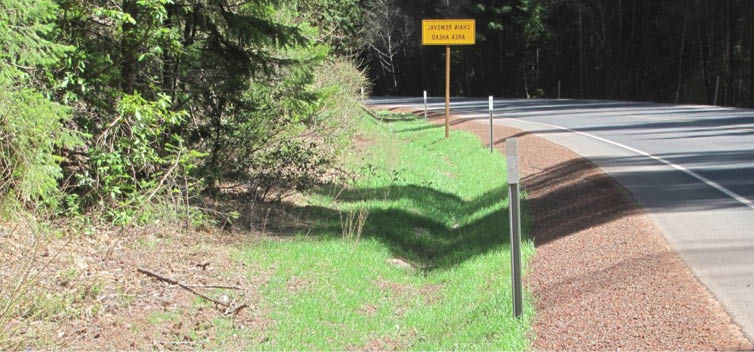
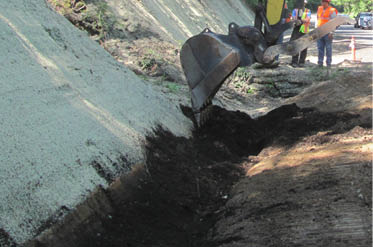
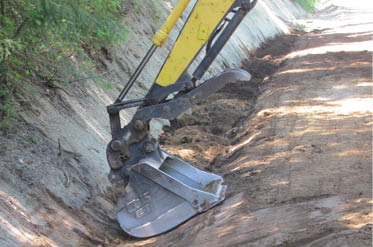
Figure 5-46 | Amended ditches
On the North Umpqua Highway project, amended ditches were created by mixing shredded wood and compost to a depth of 18 inches (A). The ditchlines were then formed using the bucket of the excavator (B). Surfaces were seeded, mulched, and lightly irrigated with a water truck being used for dust abatement. Within 6 weeks the ditches were stabilized with grasses and ready for the fall rainstorms (C).
Photo credit: David Steinfeld
It is important to establish a vegetative cover on the ditches prior to when heavy precipitation periods are expected. Grass seeds, composed of species appropriate to the site, are applied to the amended ditches and covered with weed-free straw or shredded wood as soon as the ditches are constructed. If seeding is done in the summer, in areas where rainfall is low, it may be necessary to irrigate to encourage the quick establishment of vegetation. The schedule of watering depends on the site however, a simple rule is to water when the surface of the soil, beneath the straw, just begins to dry out. Watering can be coordinated with the dust abatement operation.
Biotechnical Engineering Structures
Topographic enhancement includes a variety of engineering structures that integrate vegetation into the design. These include vegetated retaining walls, brush layers, vegetated riprap, and live pole drains. Attention to the quality of topsoil is important in most biotechnical engineering structures. For instance, the quality of topsoil and how it is placed in vegetated retaining walls is critical for establishing vegetation (Figure 5-47). Where riprap is to be vegetated, it may require a deep layer of high quality composts cover placed over and between the riprap (Figure 5-48).
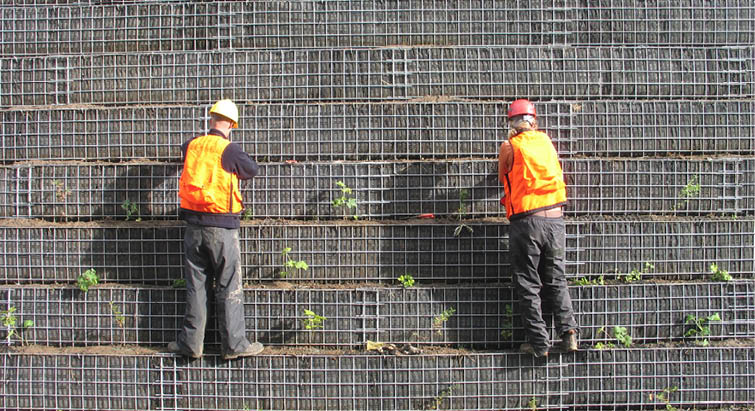
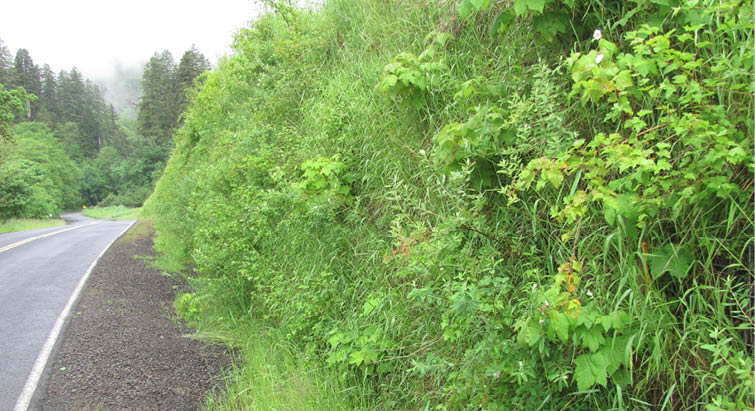
Figure 5-47 | Vegetated retaining walls
The MSE walls on the Blaine Road project required topsoil to be placed in one foot wide baskets faced with native seeded erosion mats. The 6 inch ledges between baskets were planted with native shrub seedlings (A) and within several years after planting, the walls were covered with shrubs and grasses (B).
Photo credit: David Steinfeld
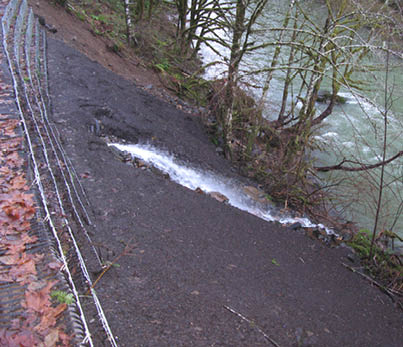
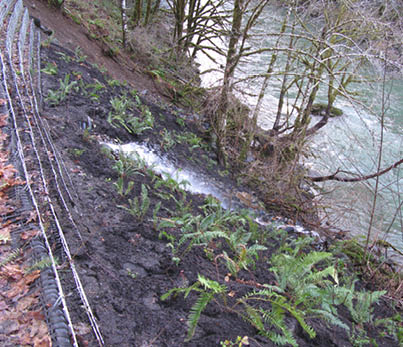
Figure 5-48 | Vegetated riprap
Riprapped culvert outlets were reconstructed along the Nestucca River, an Oregon State Scenic Waterway, and required that they be revegetated with native riparian species. A compost blanket was installed over the riprap at a depth of 8 inches (A). It was planted with seedlings of a variety of riparian species shown in (B) a year later.
Photo credit: David Steinfeld
Runoff Strips and Constructed Wetlands
Runoff strips are catchment structures constructed in areas where intermittent concentrated road drainage occurs. These are typically at the outlets of culverts or in road drainage dips. Runoff strips capture concentrated runoff into small ponds or catchment basins. These areas can be planted with riparian species, such as willows (Salix spp.) and cottonwoods (Populus spp.), or wetland species, such as rushes (Juncus spp.) and sedges (Carex spp.). Runoff strips are placed in draws or concave topography and are composed of engineered impoundment barriers, using riprap, logs, or gabion baskets, which store water from runoff events. The barrier must have a spillway (a low point in the structure) and be keyed into the sides to ensure that concentrated water does not erode around its sides. Where runoff strips are on gentle gradients, constructed wetlands may possibly be developed (Figure 5-49).
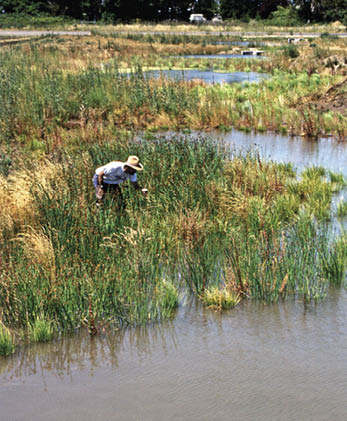
Figure 5-49 | Constructed wetlands are effective at capturing runoff water
Constructed wetlands capture water from roadside runoff and filter sediments before water enters perennial streams. Constructed wetlands can create favorable habitat for unique flora and fauna.
Photo credit: David Steinfeld

